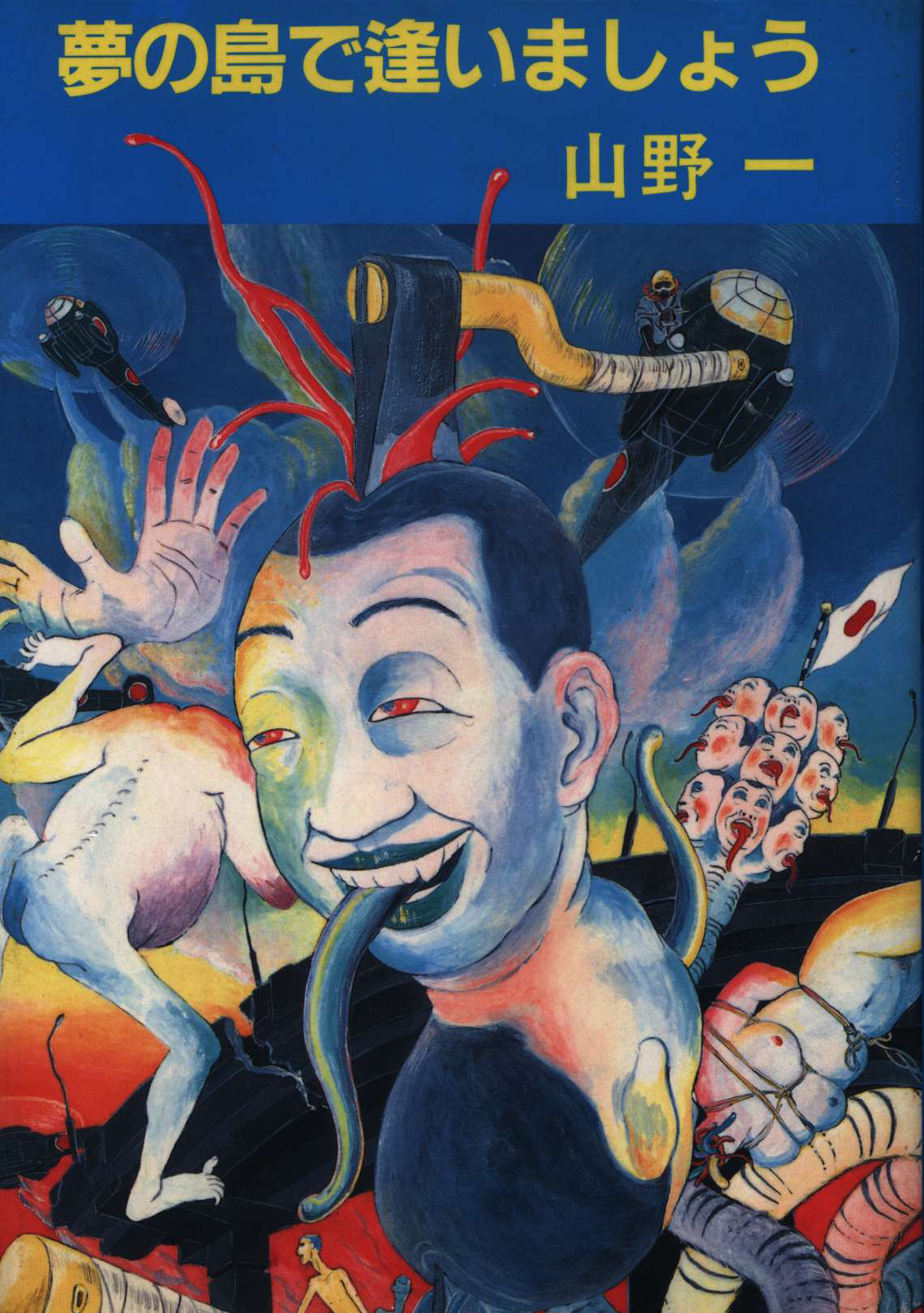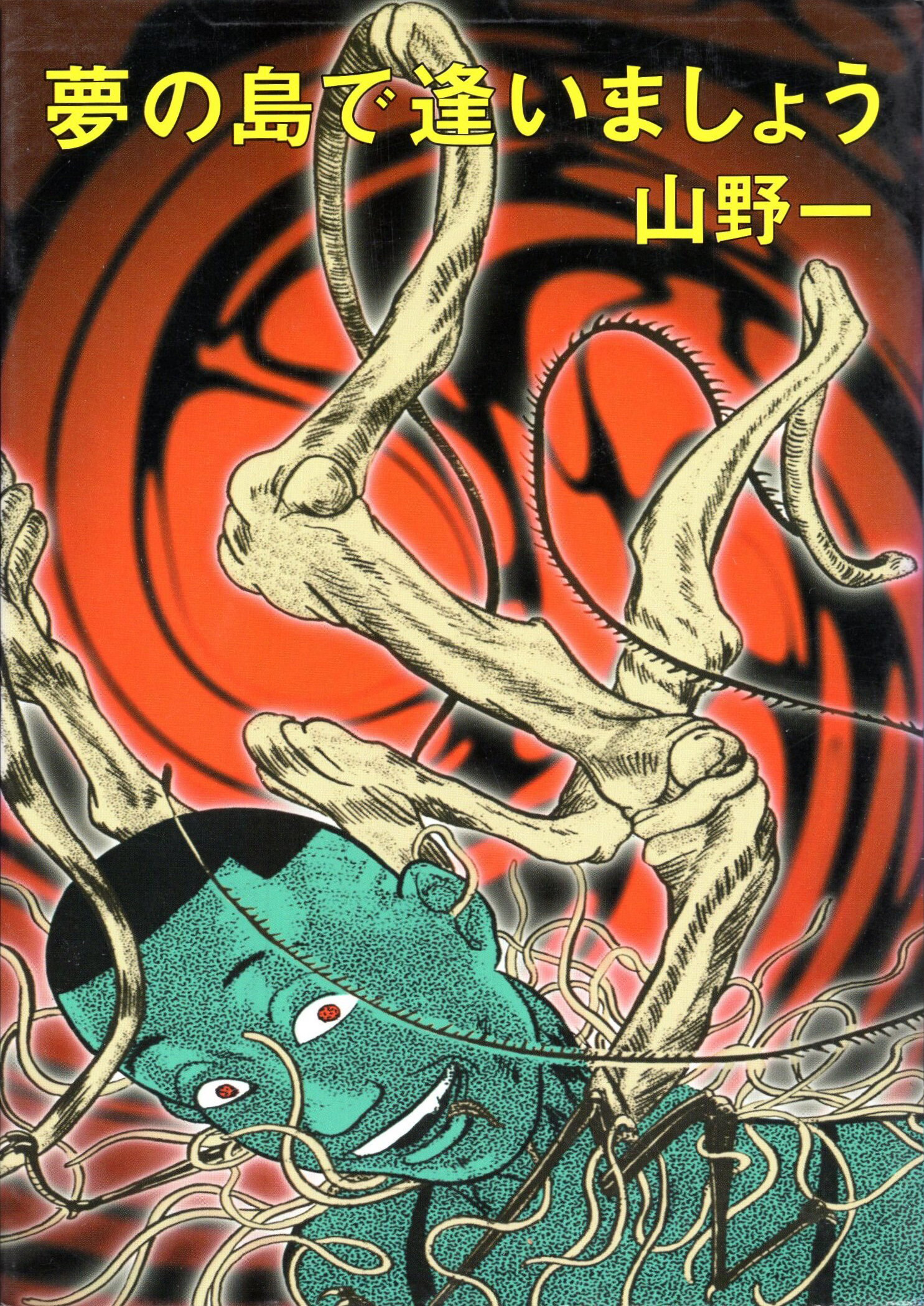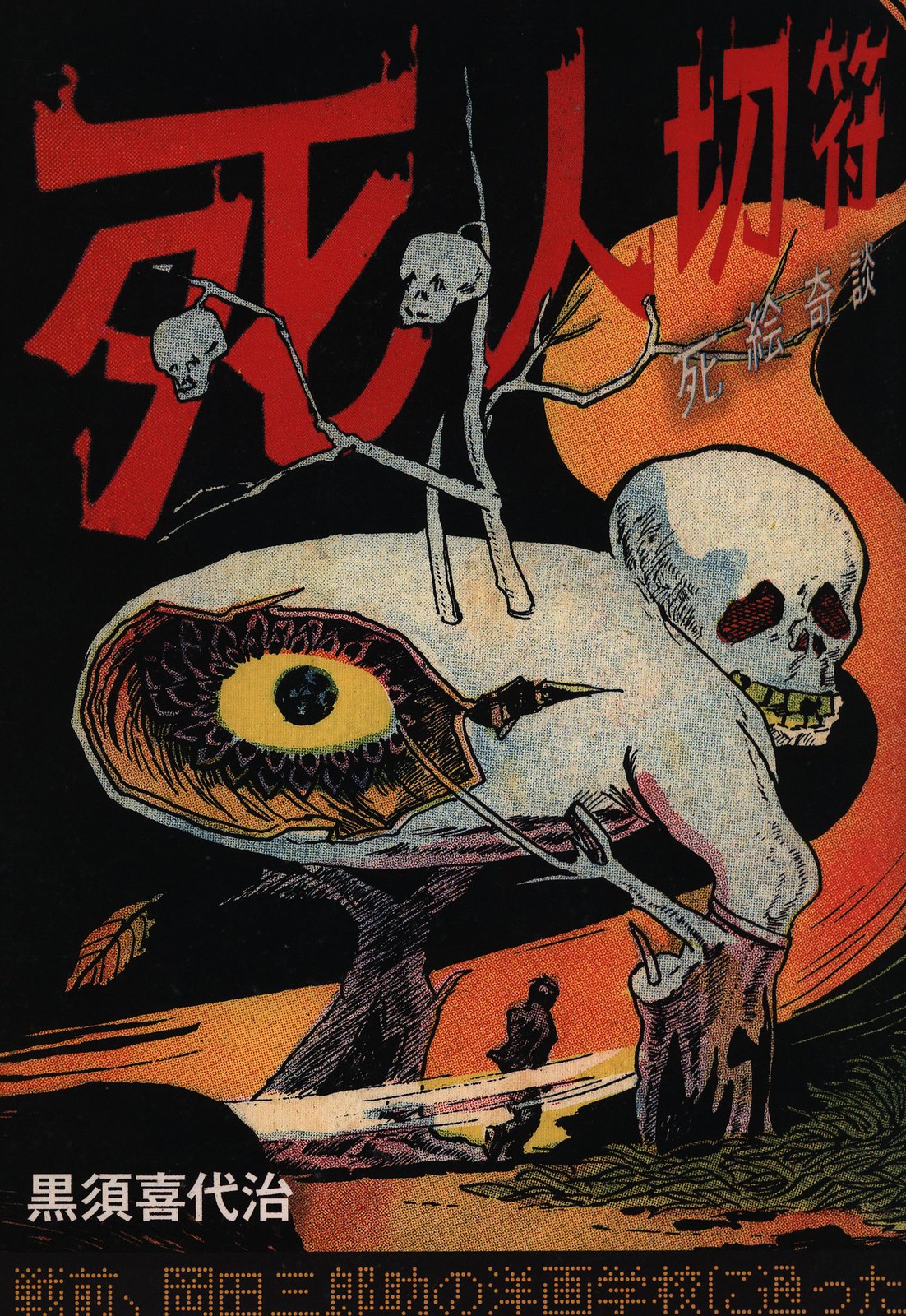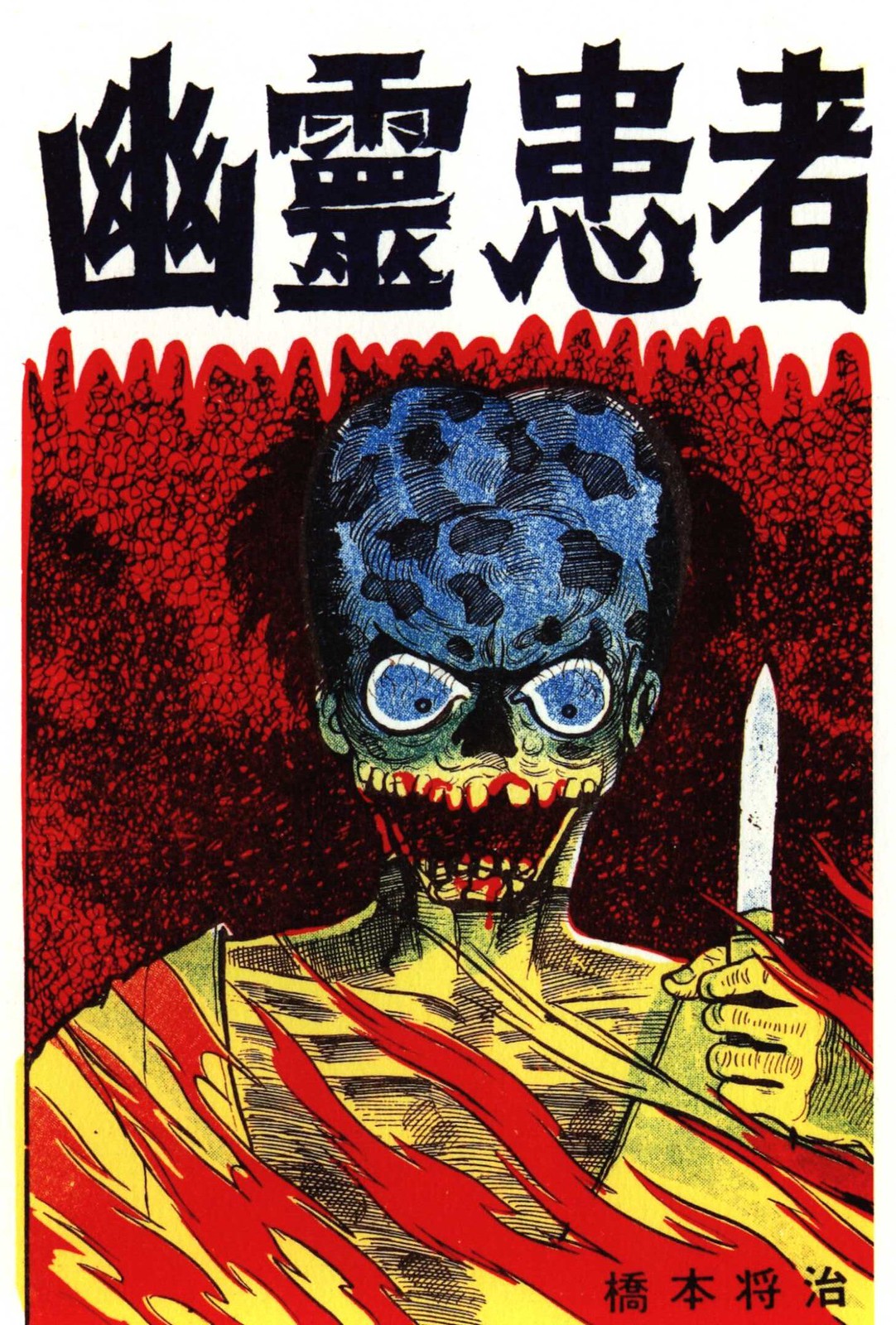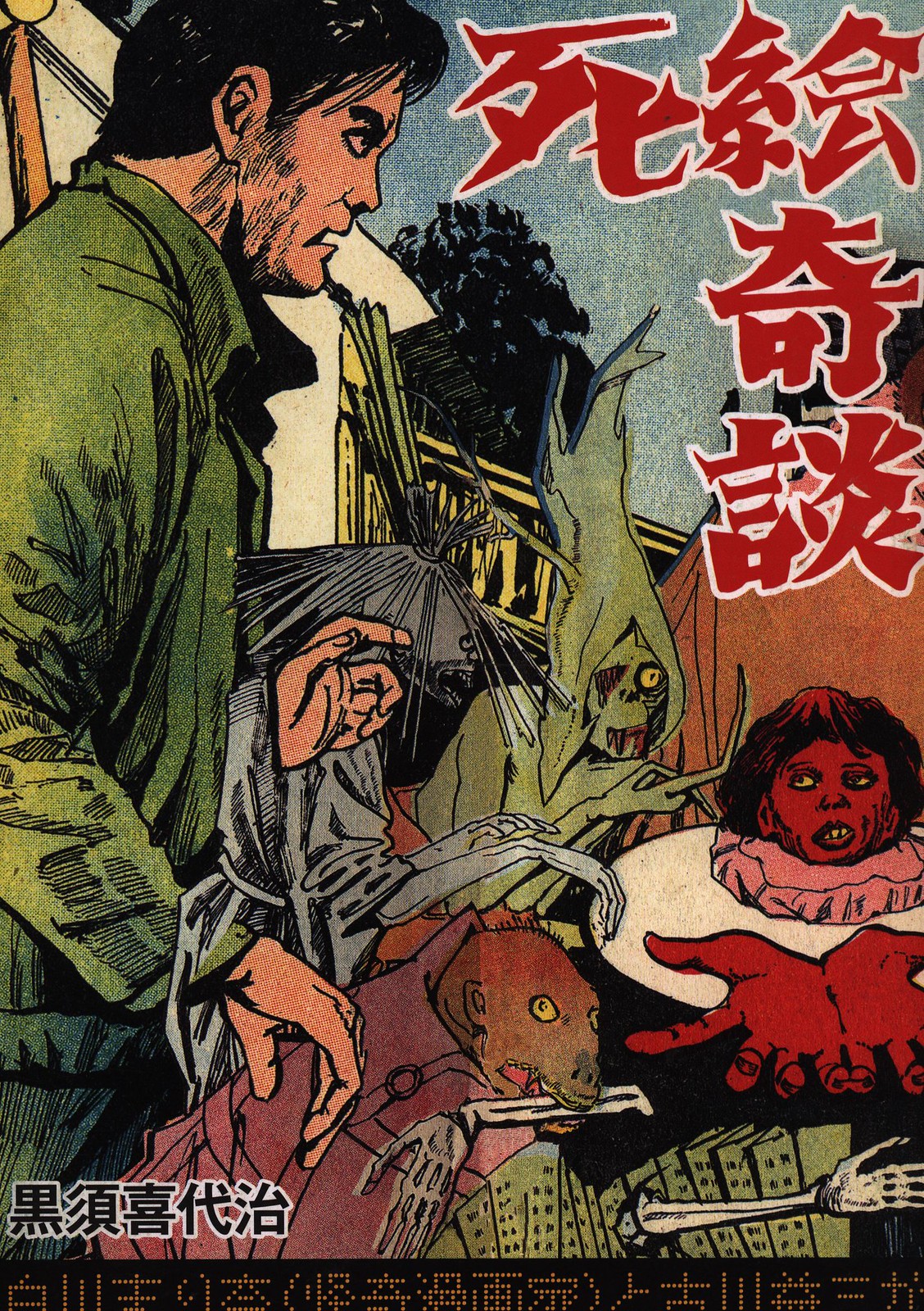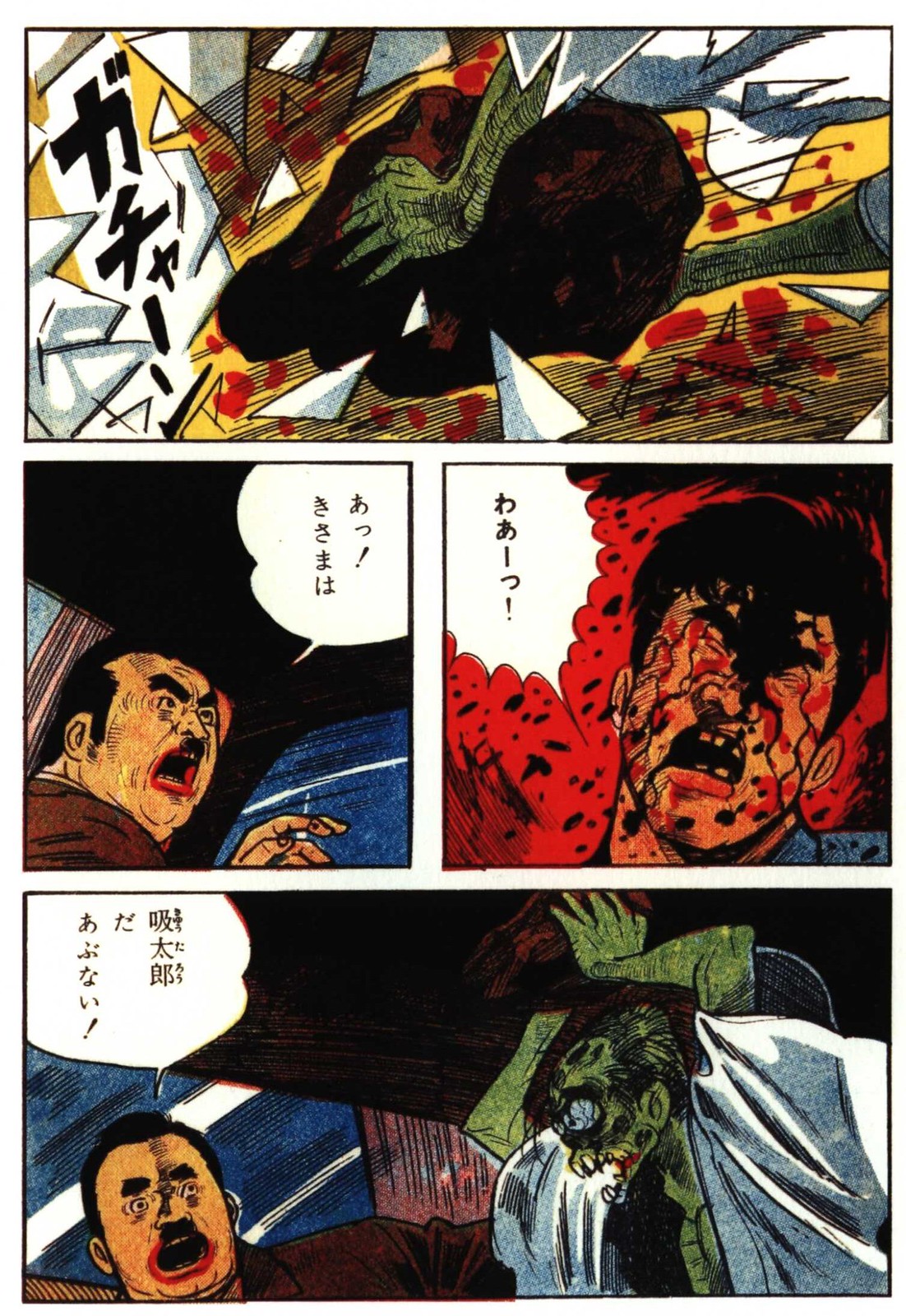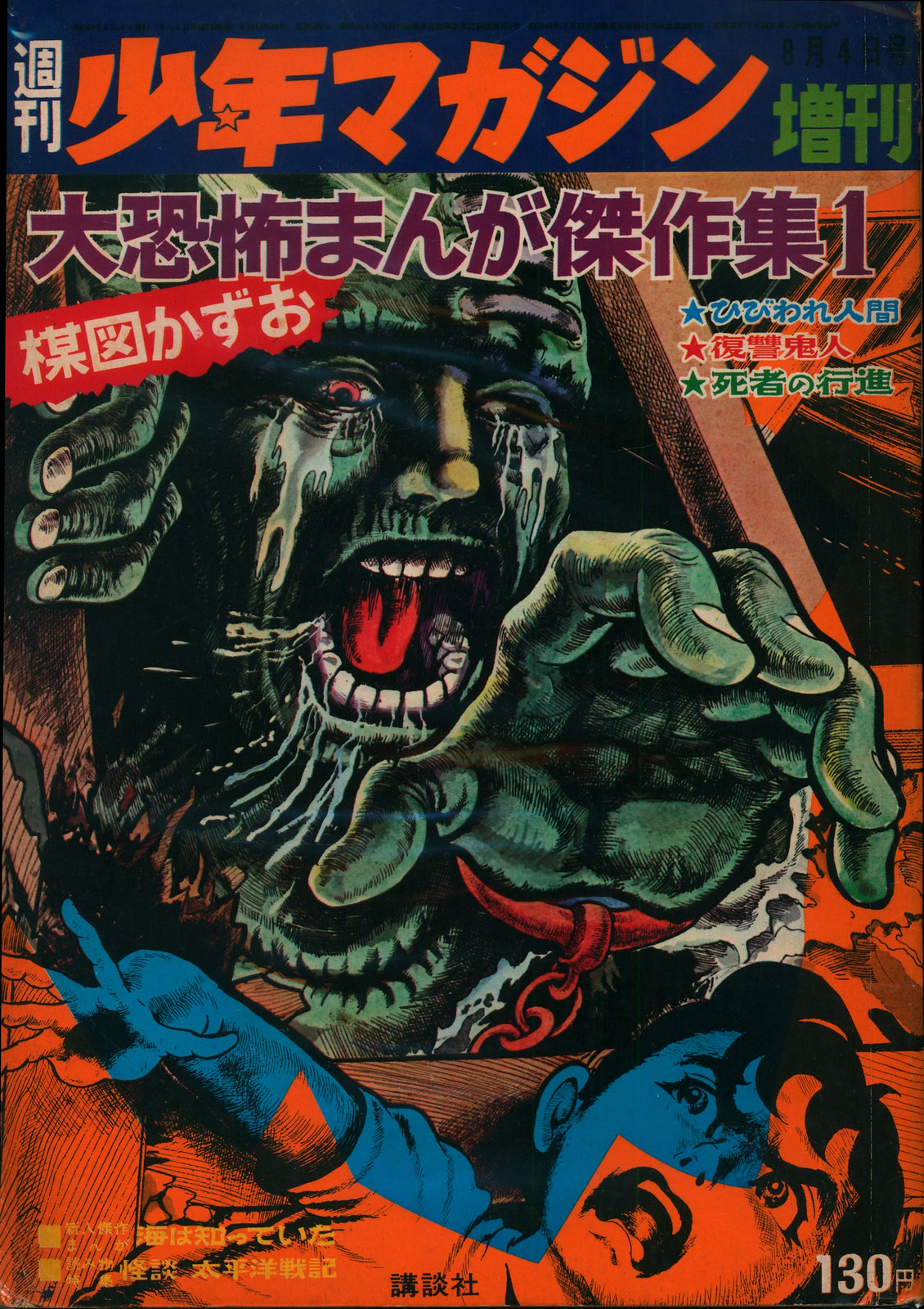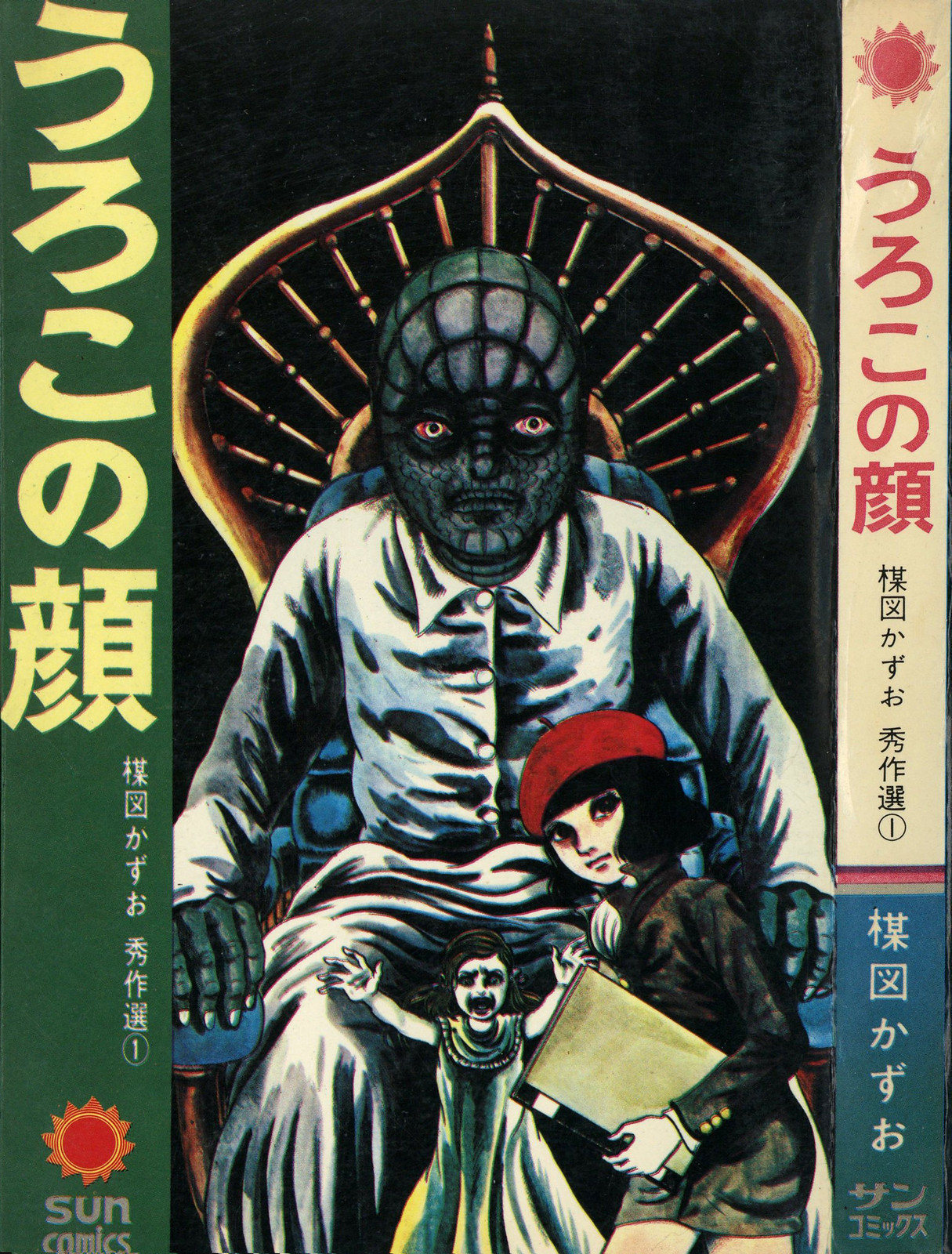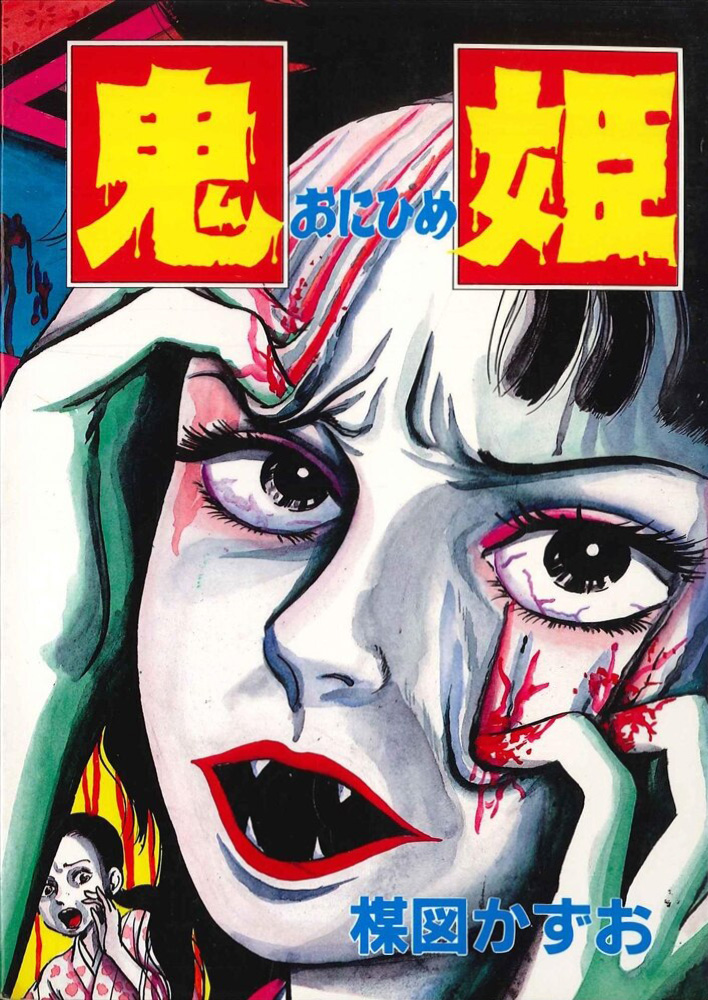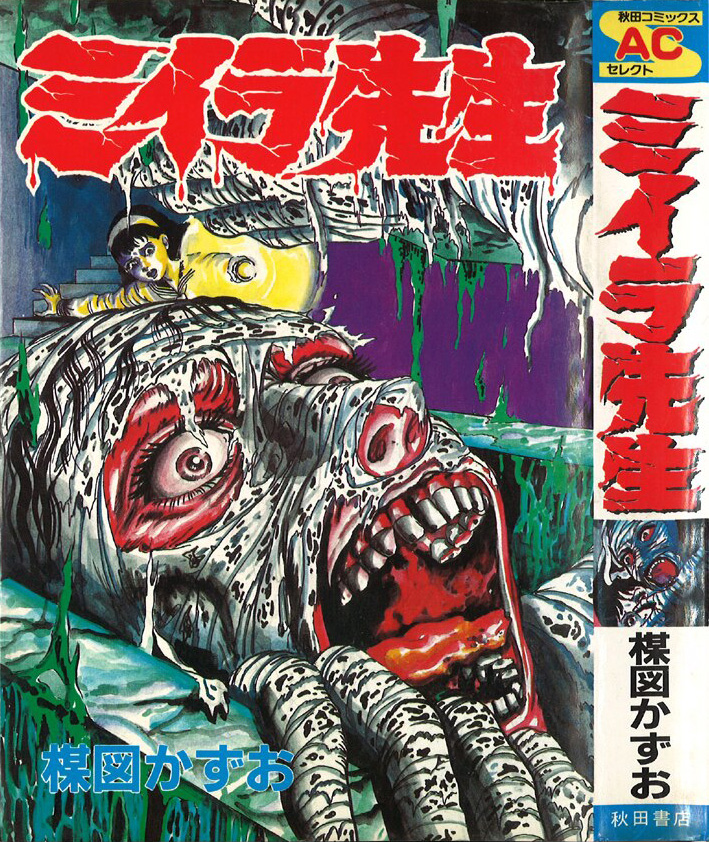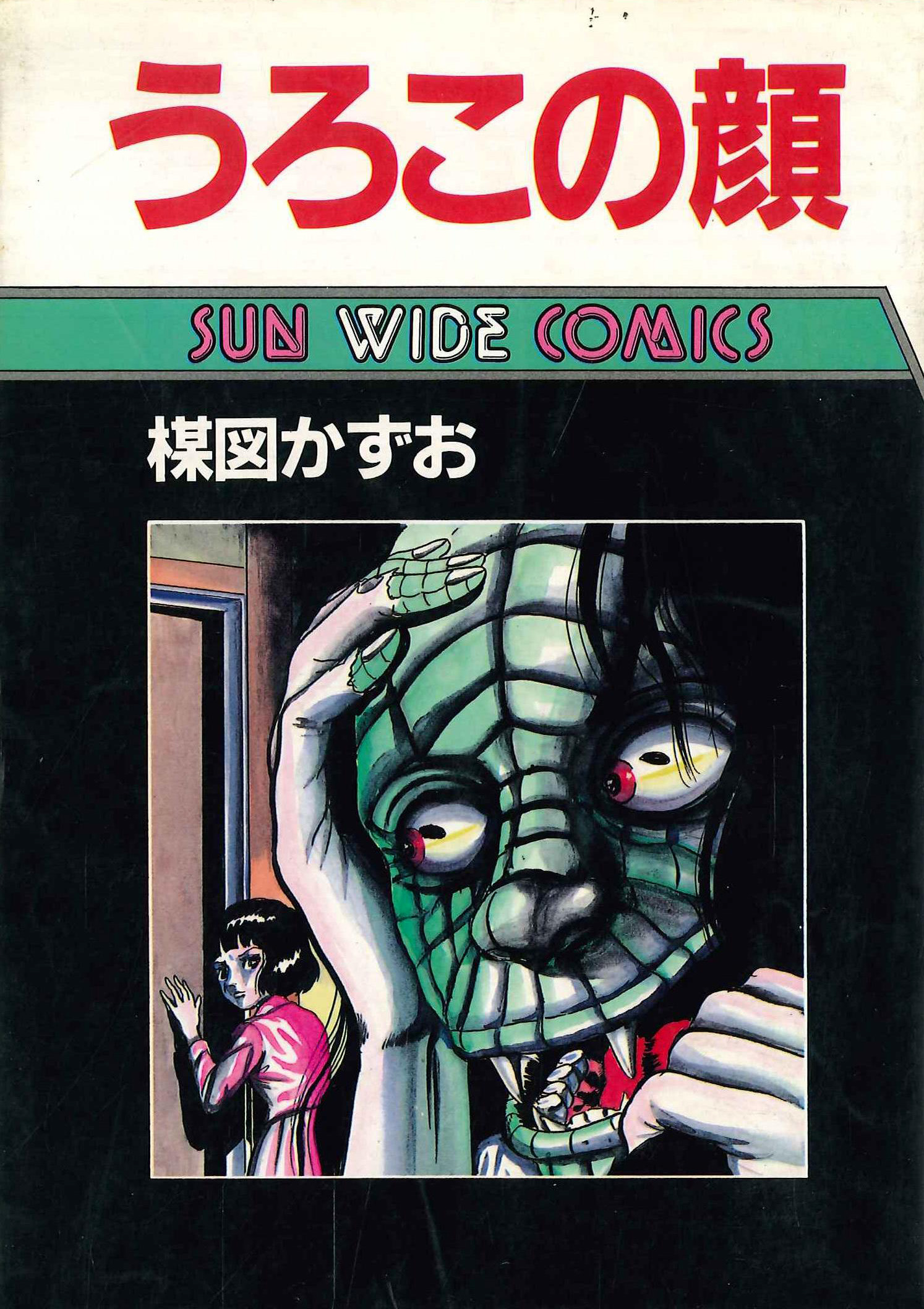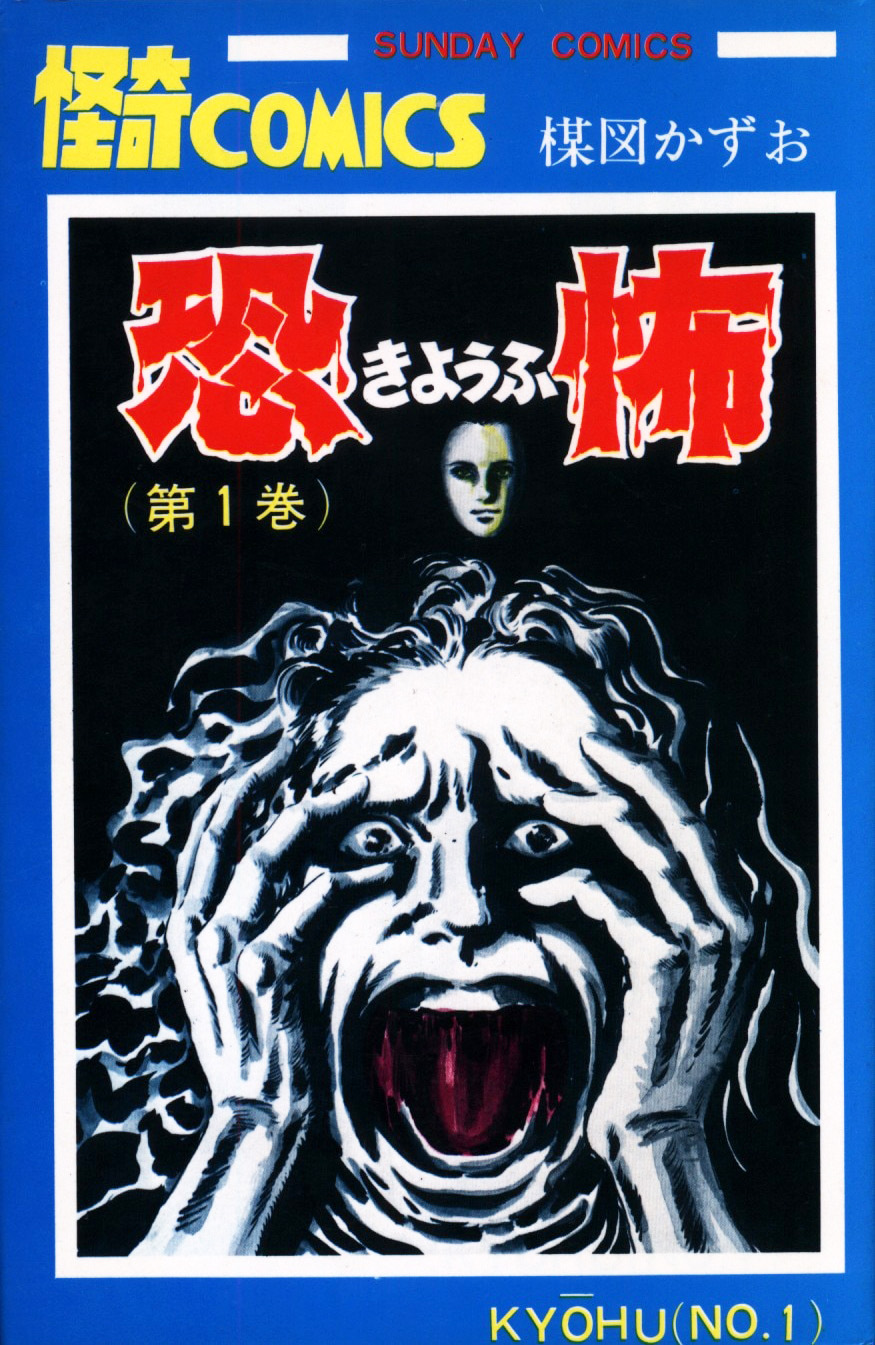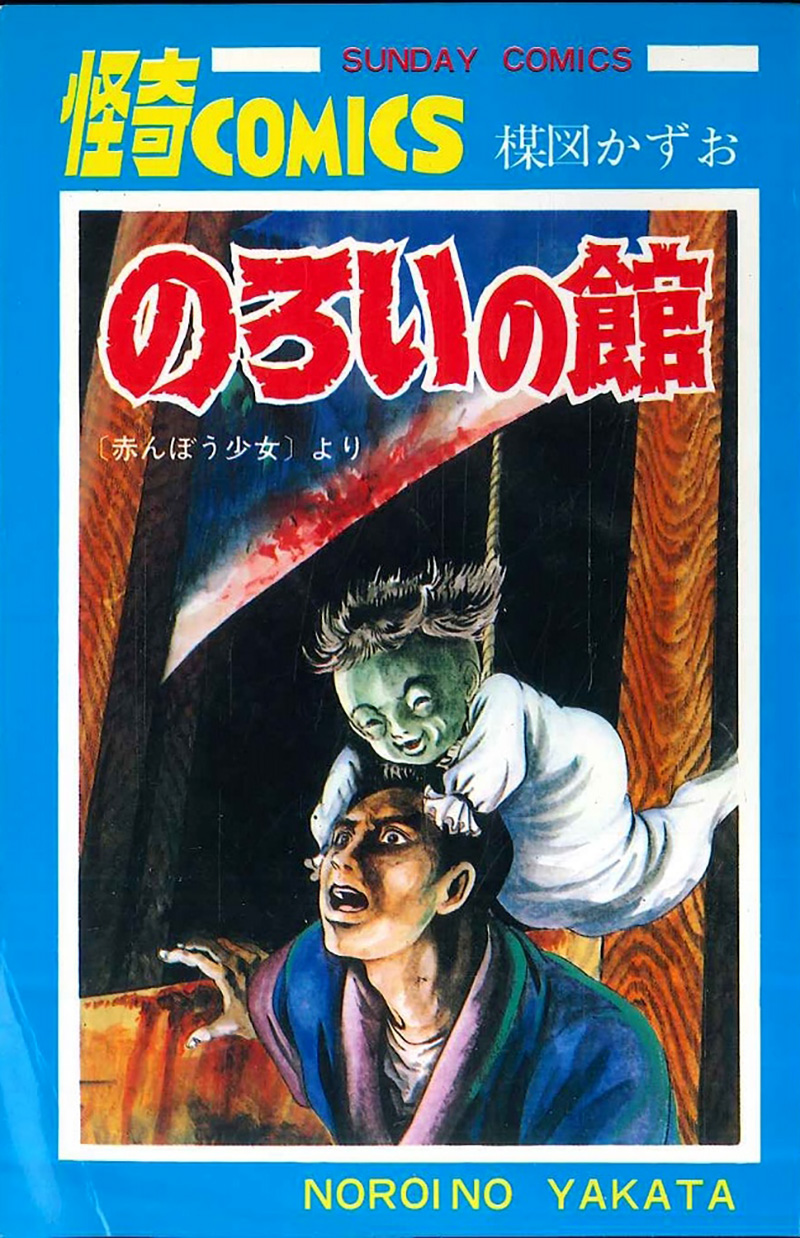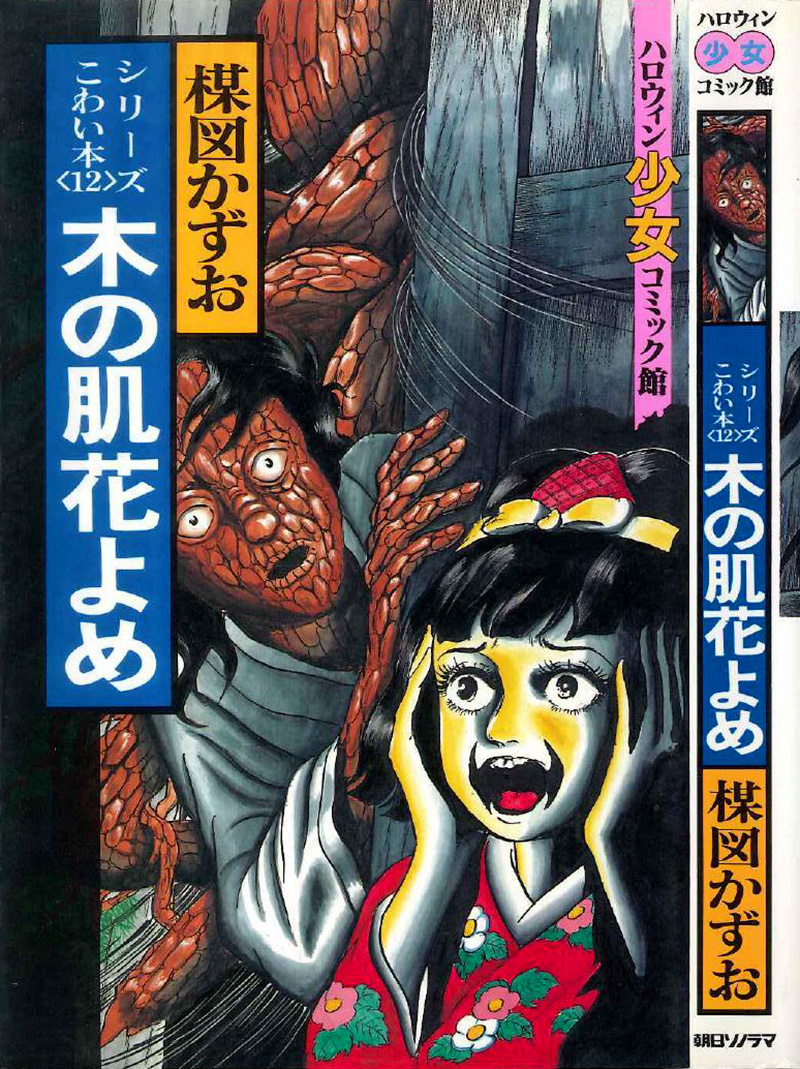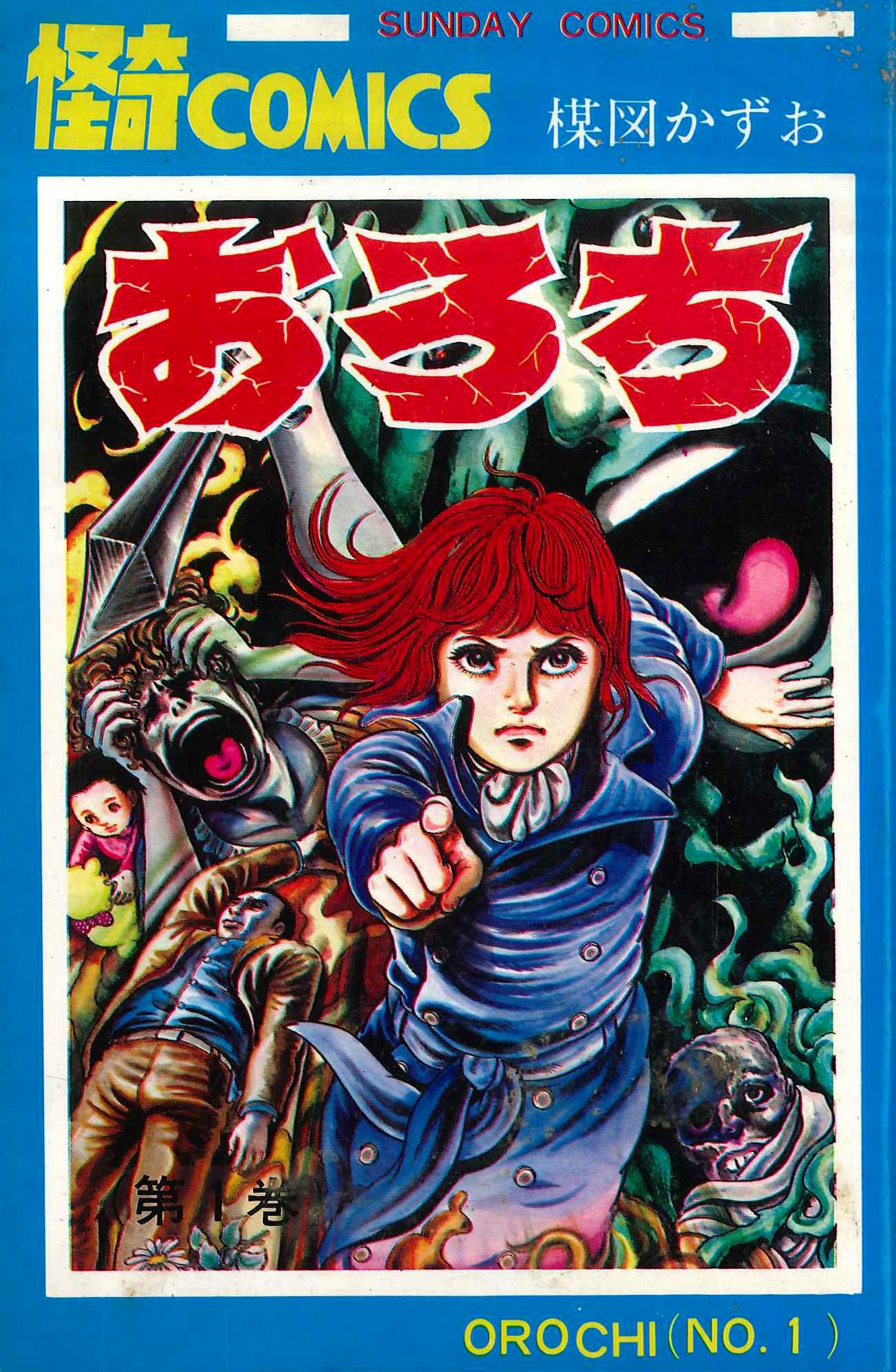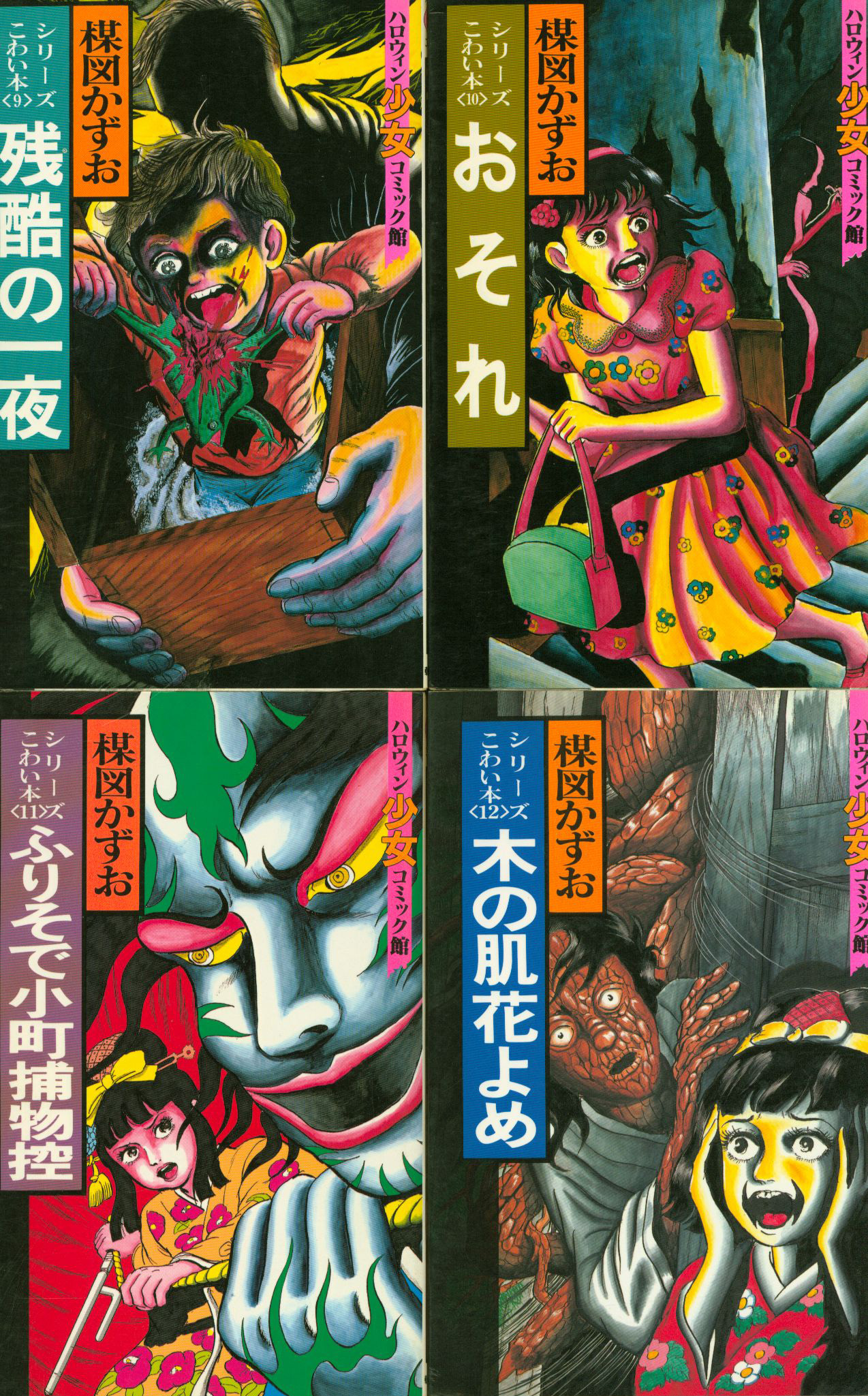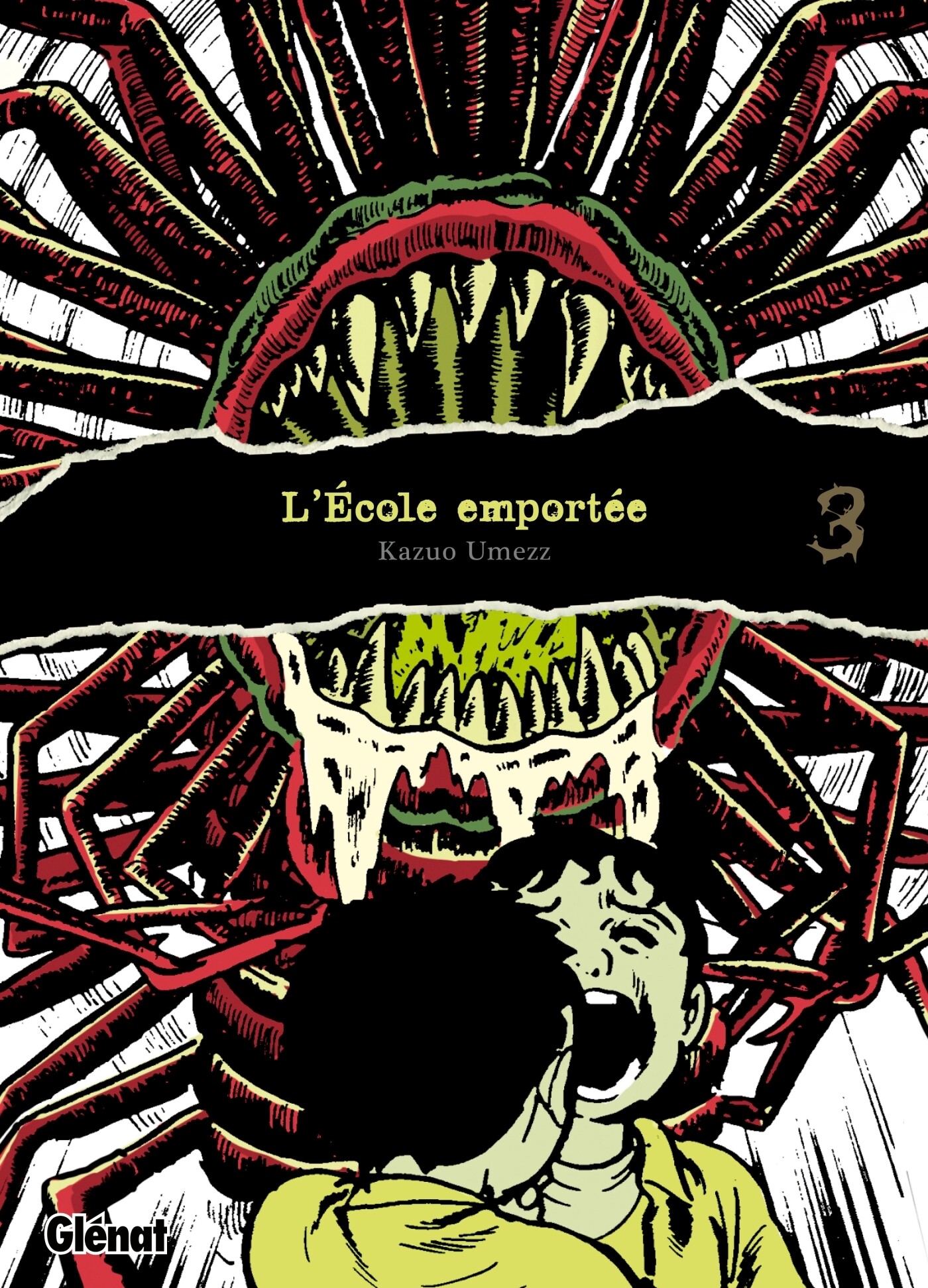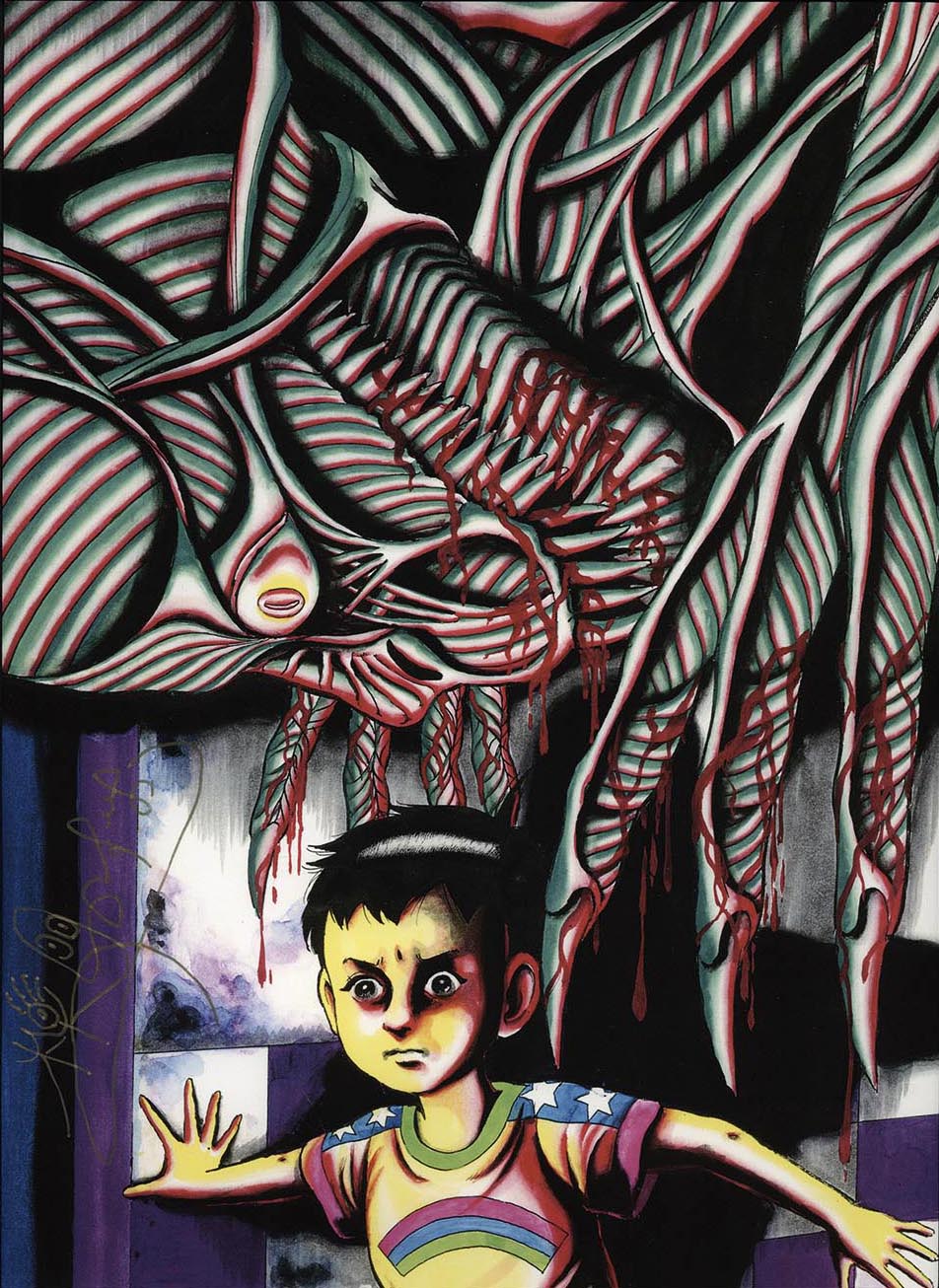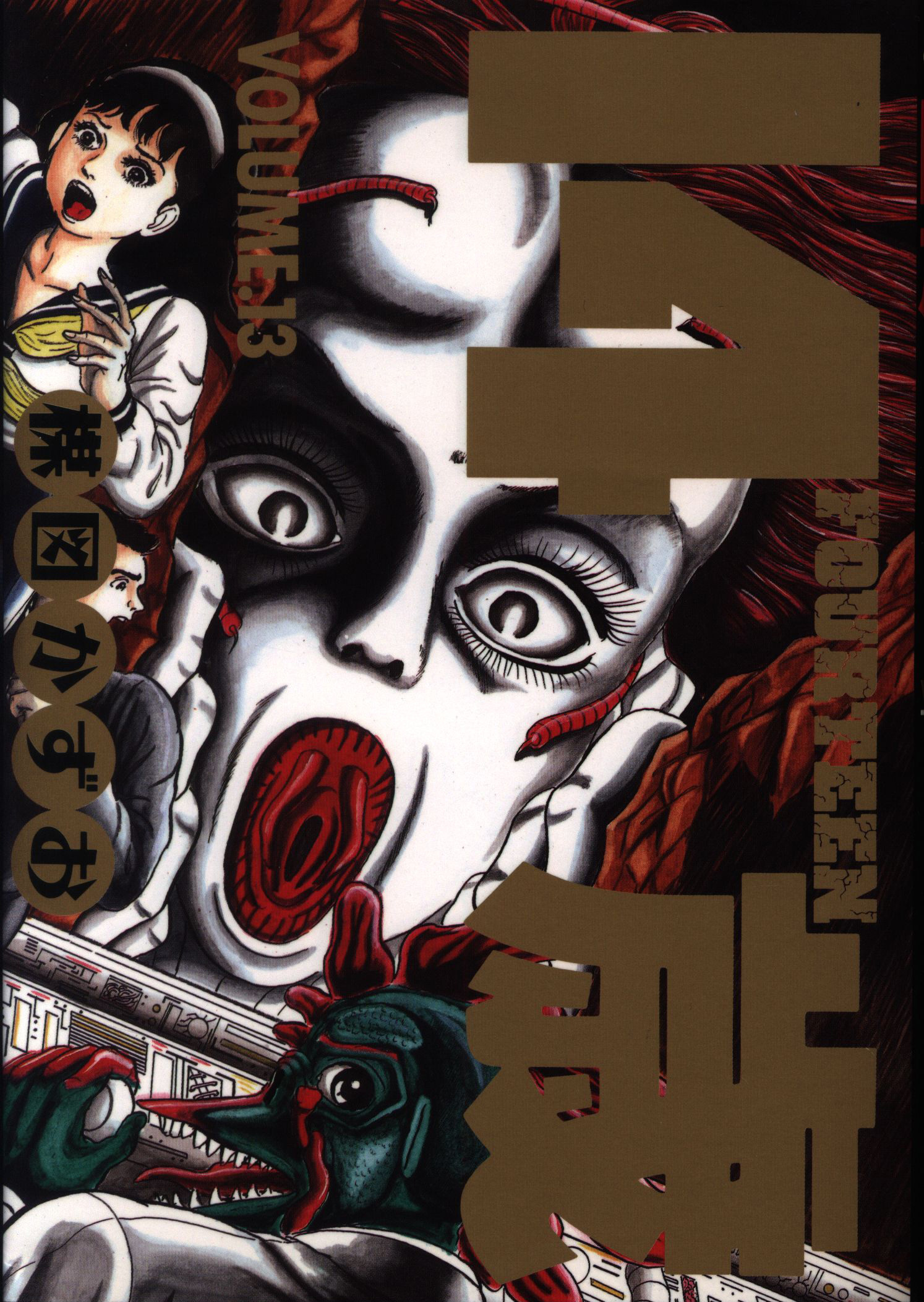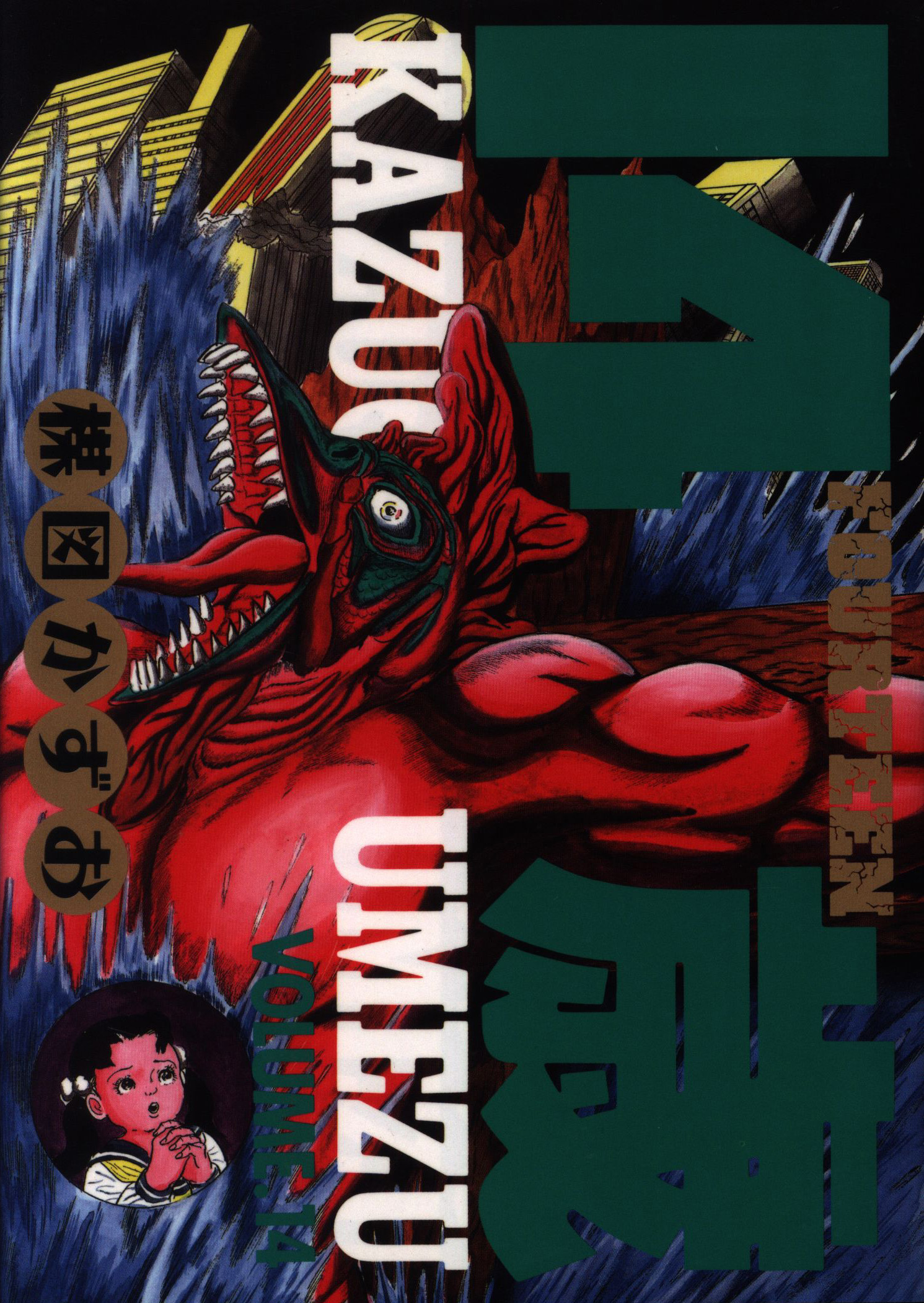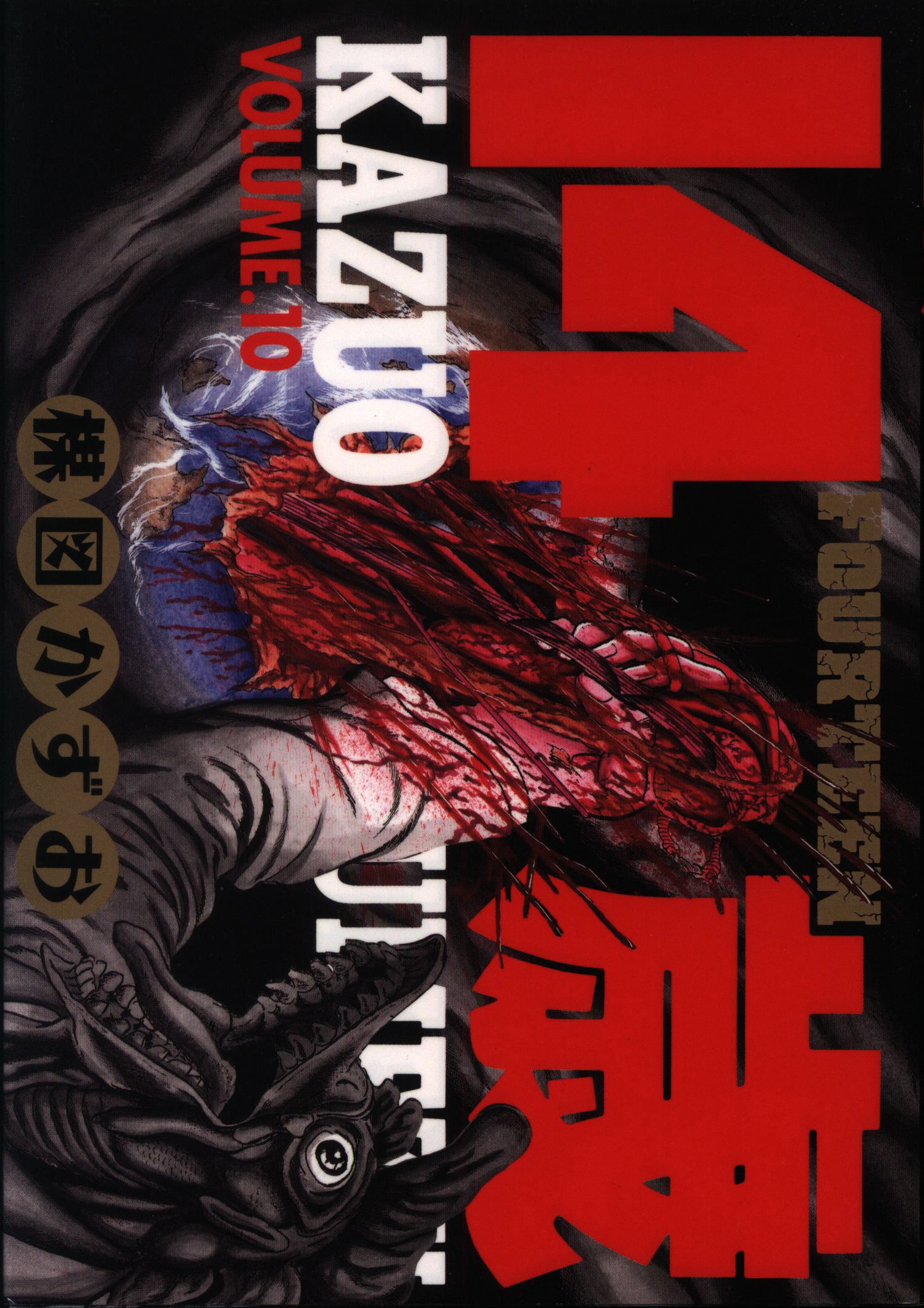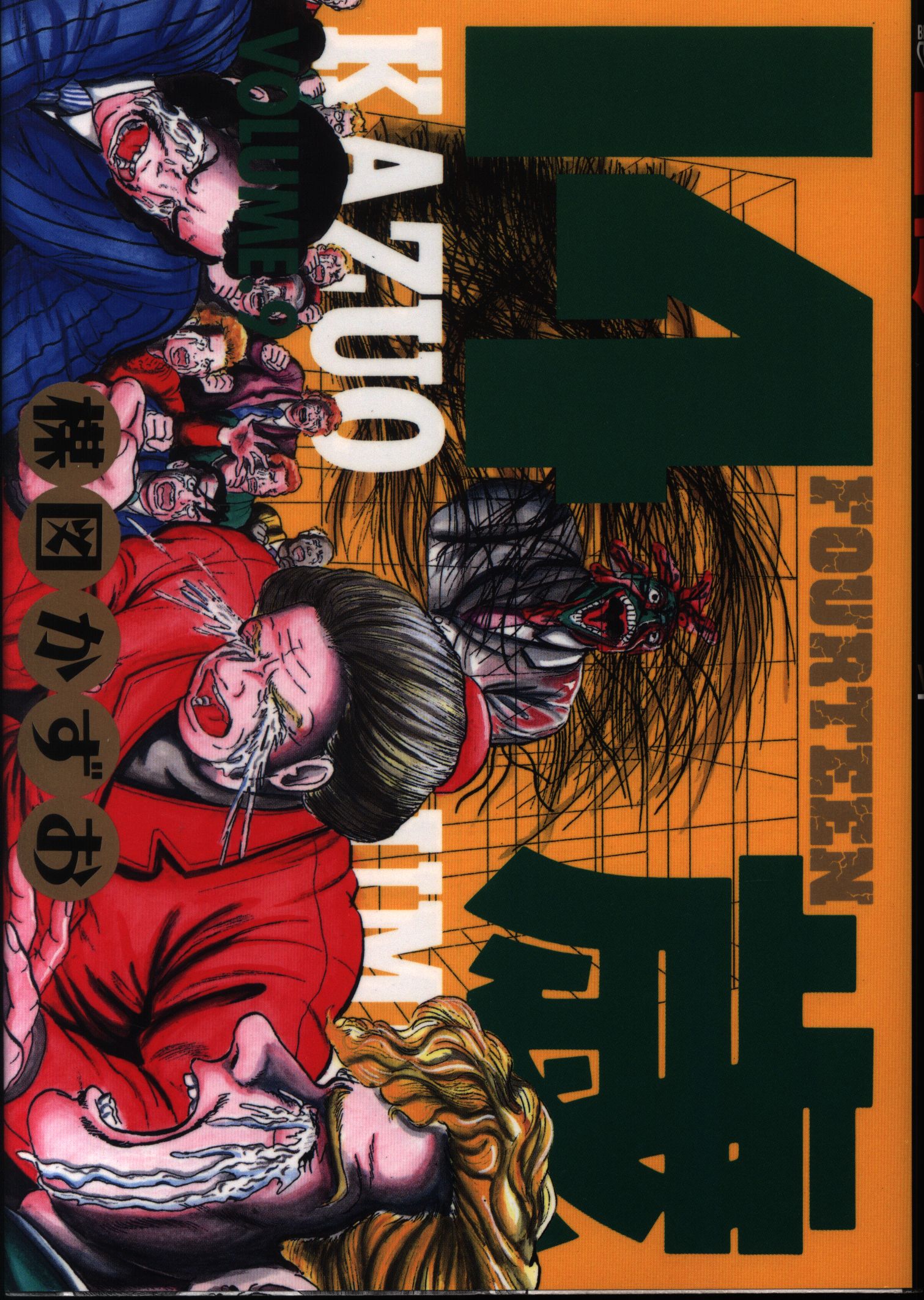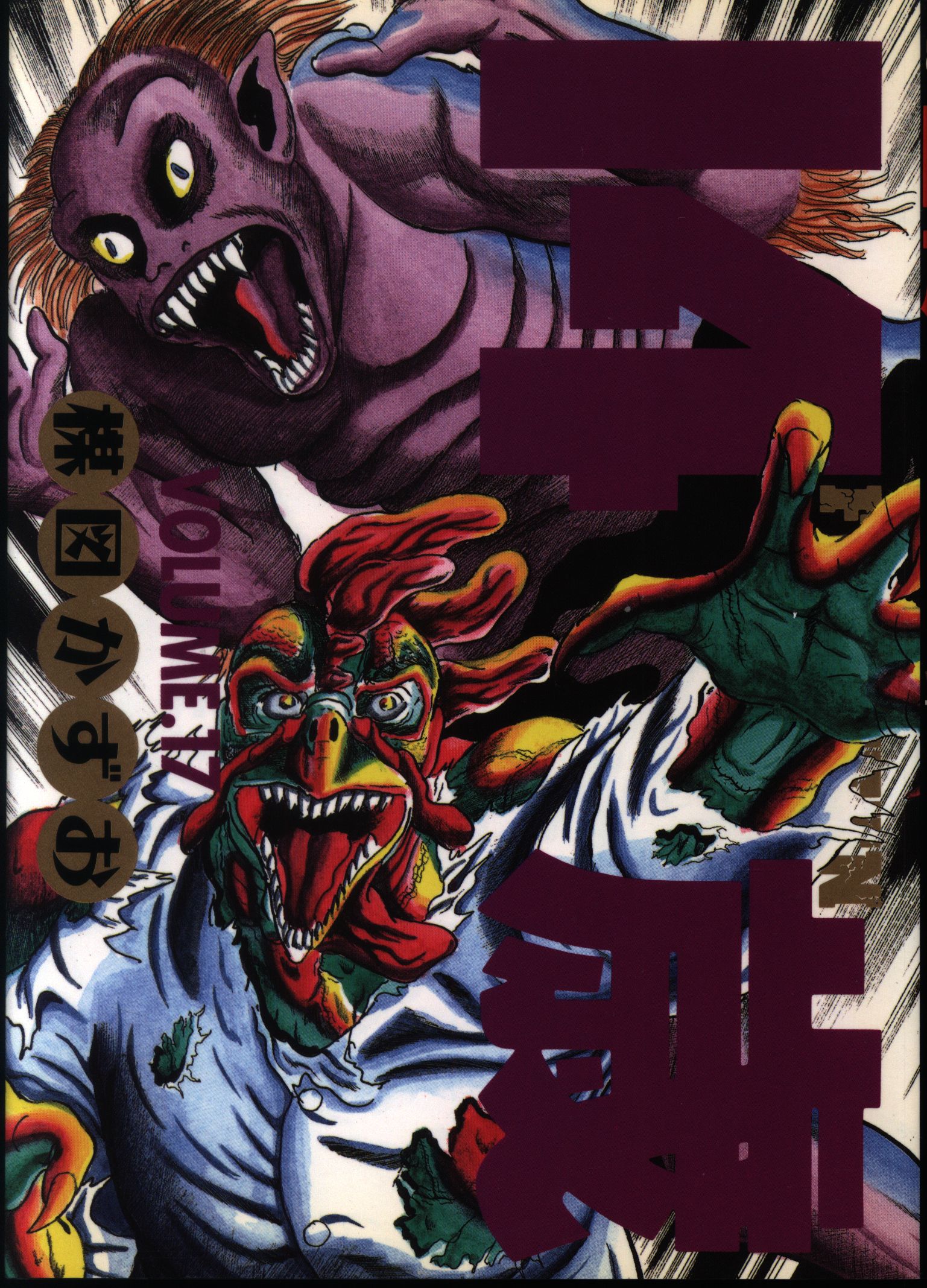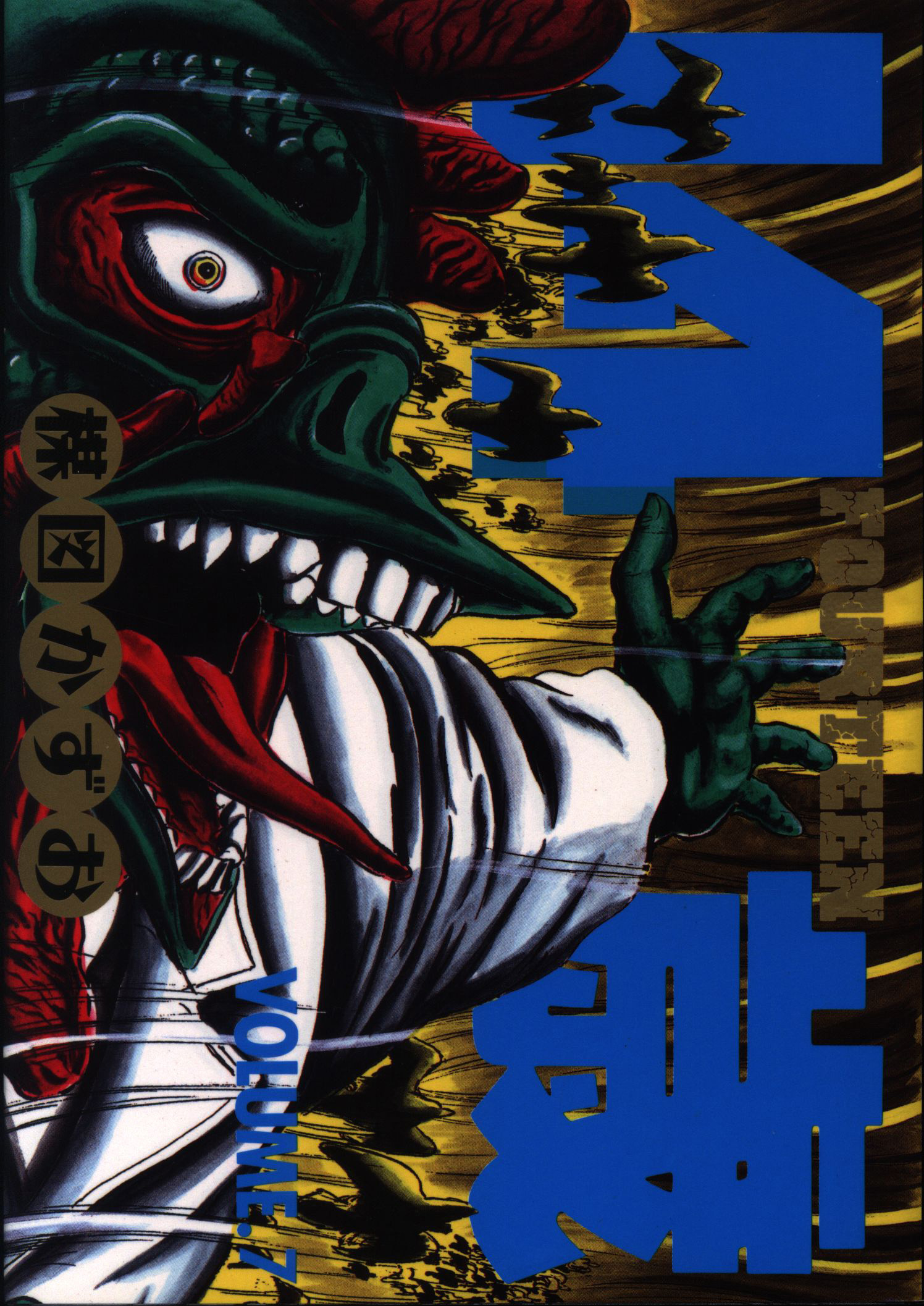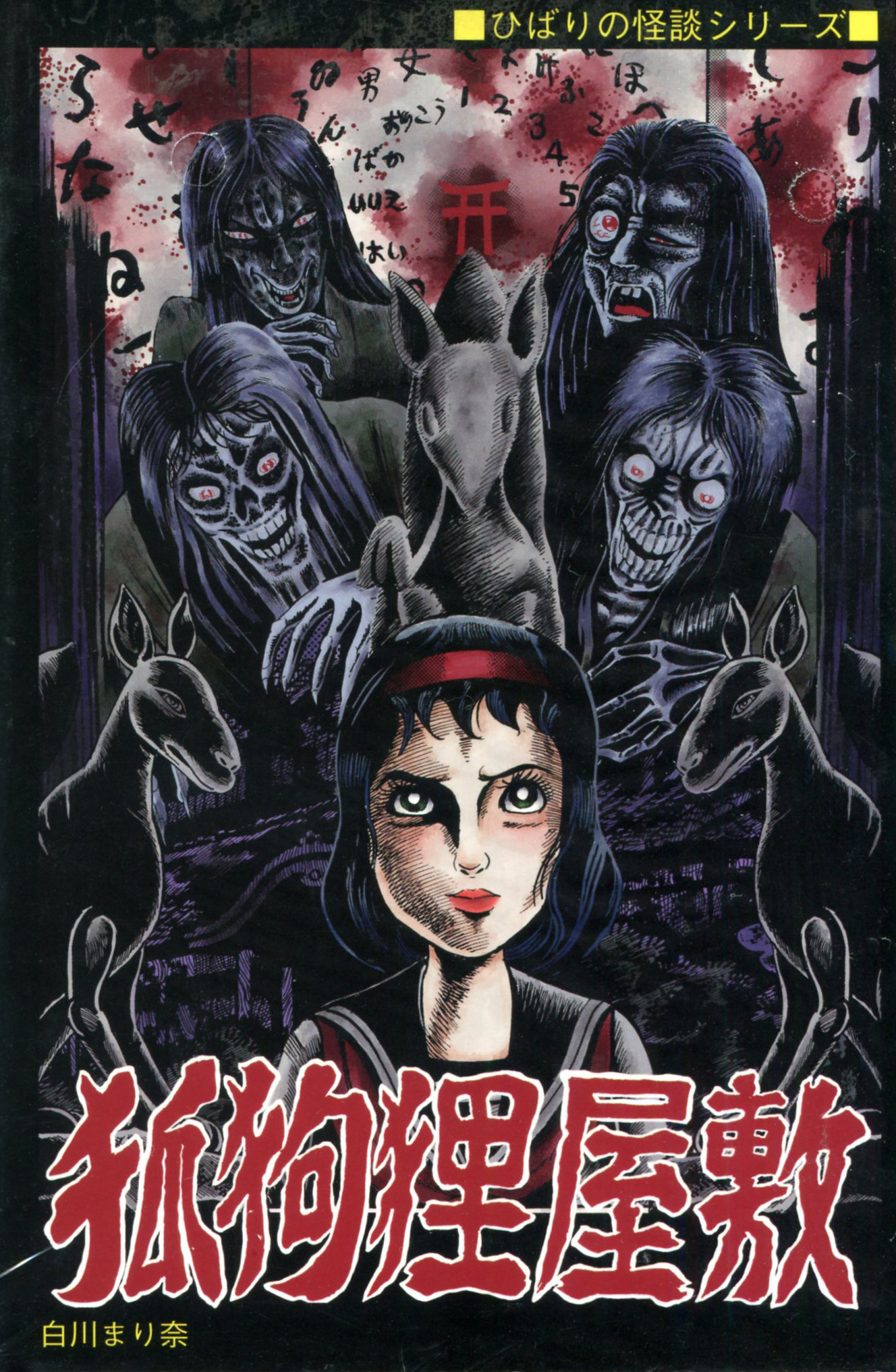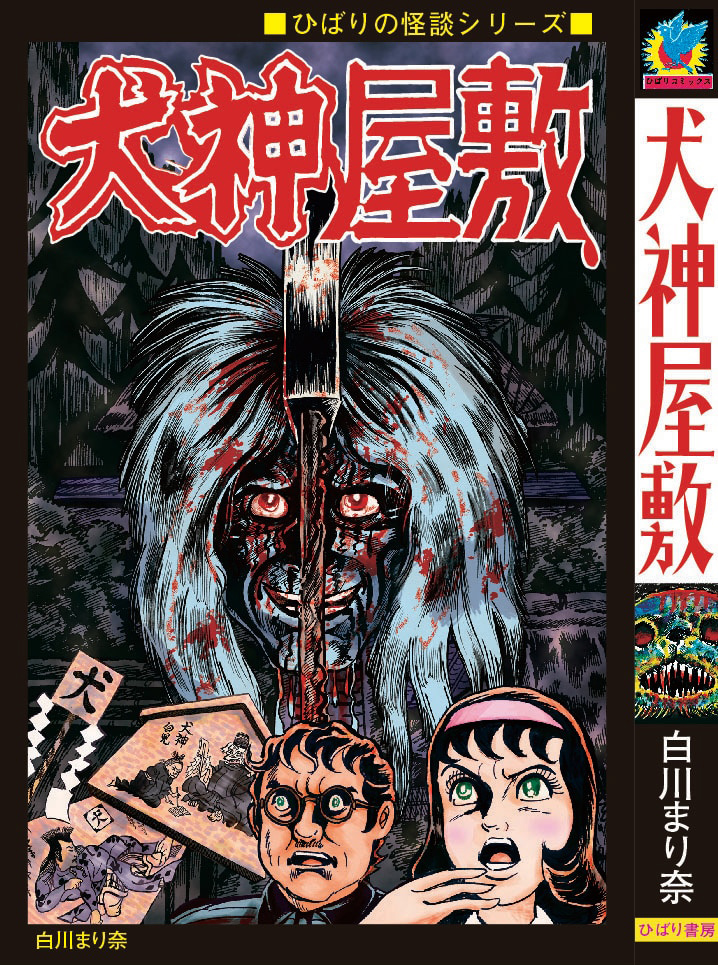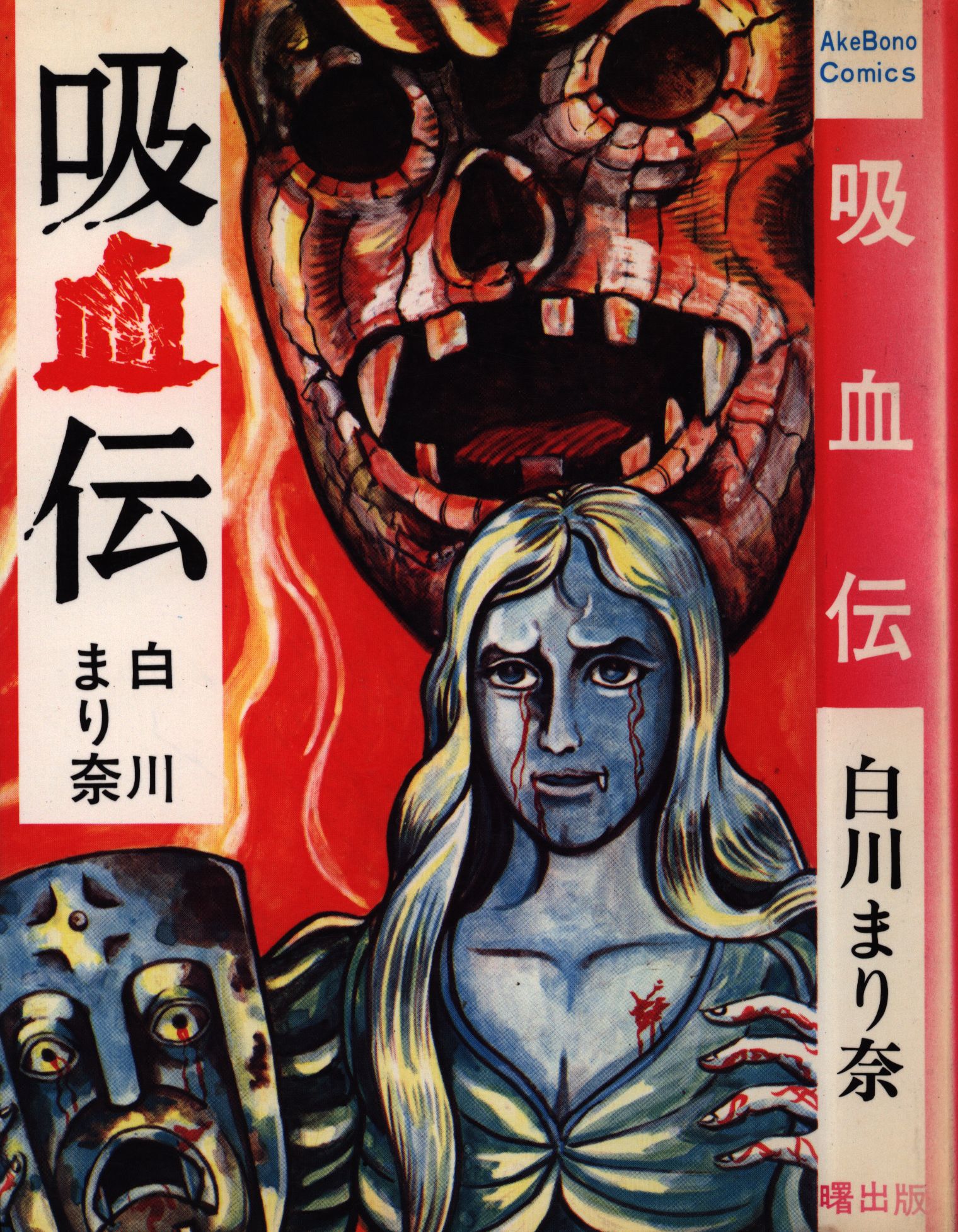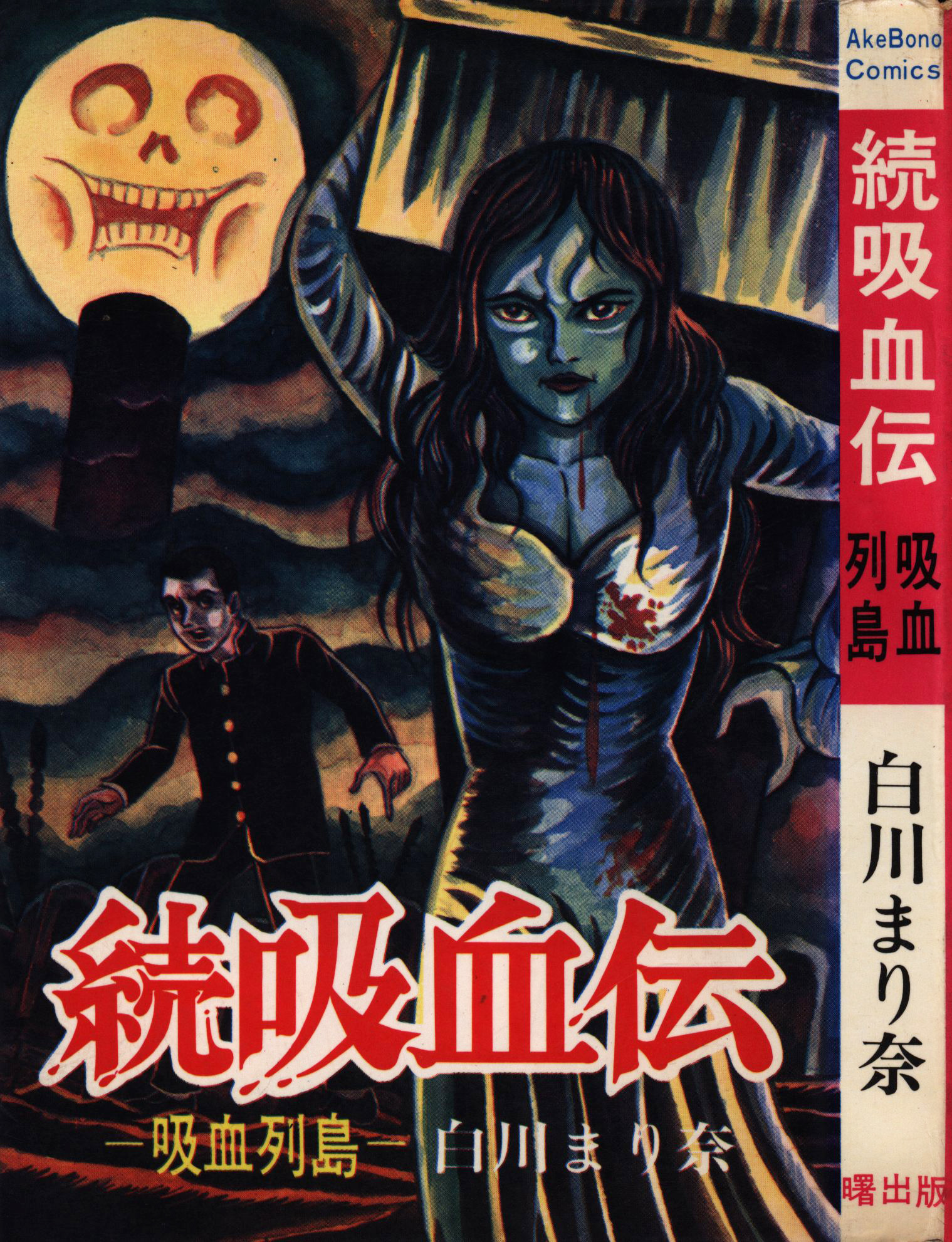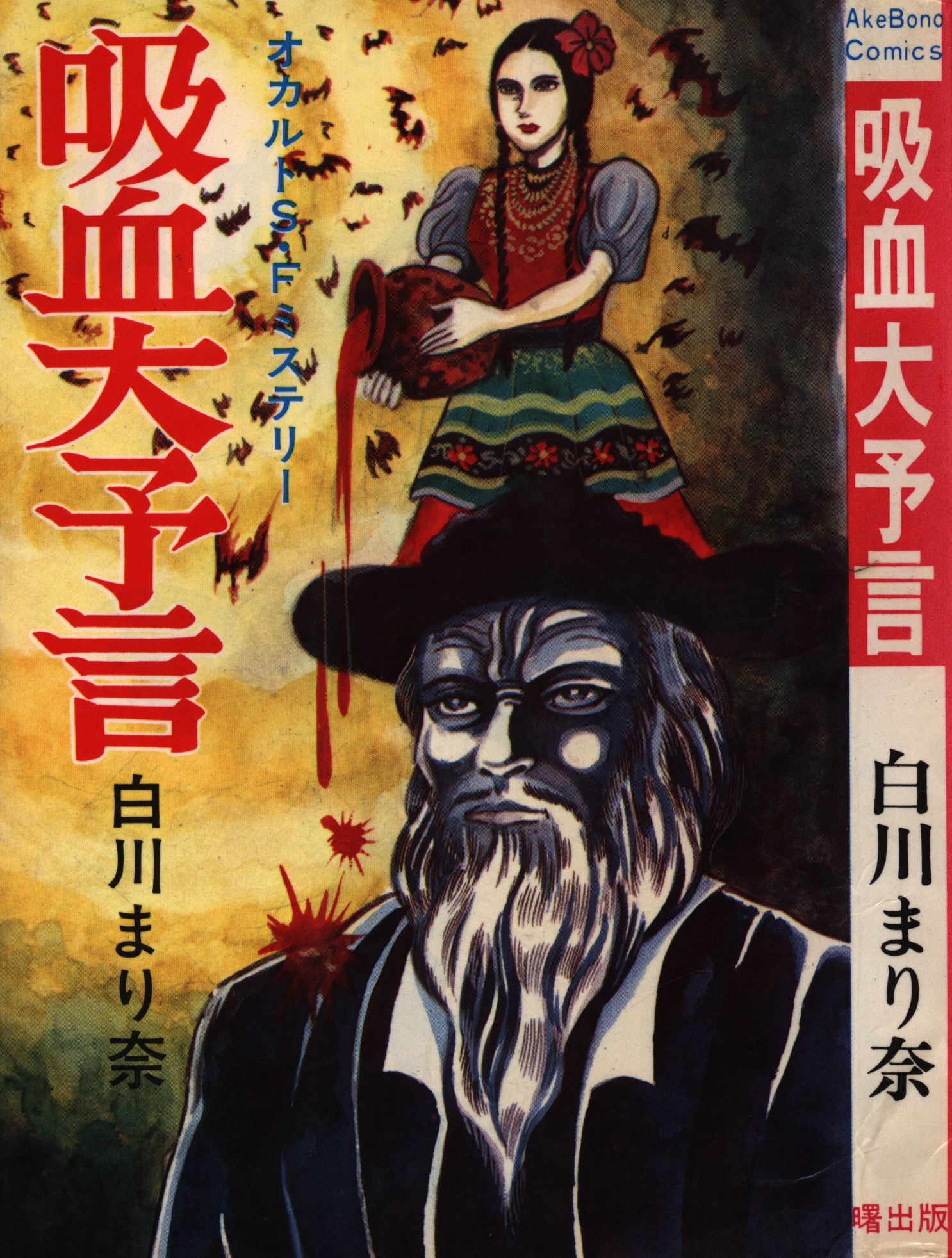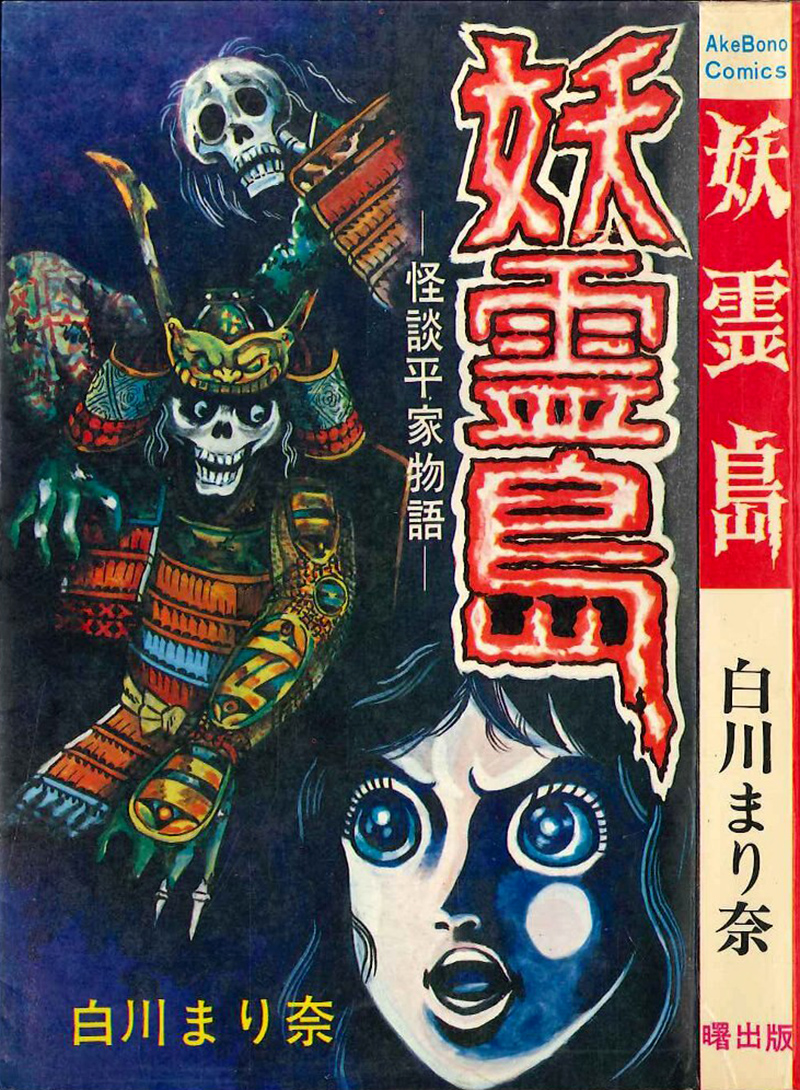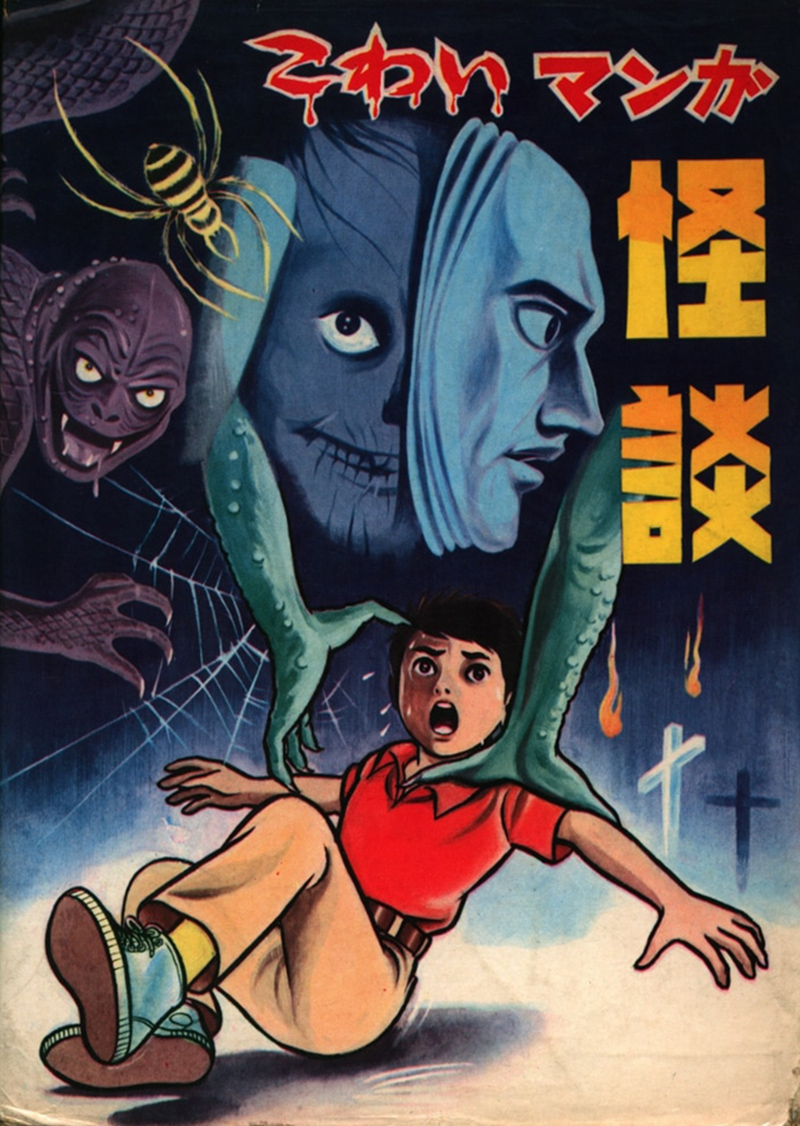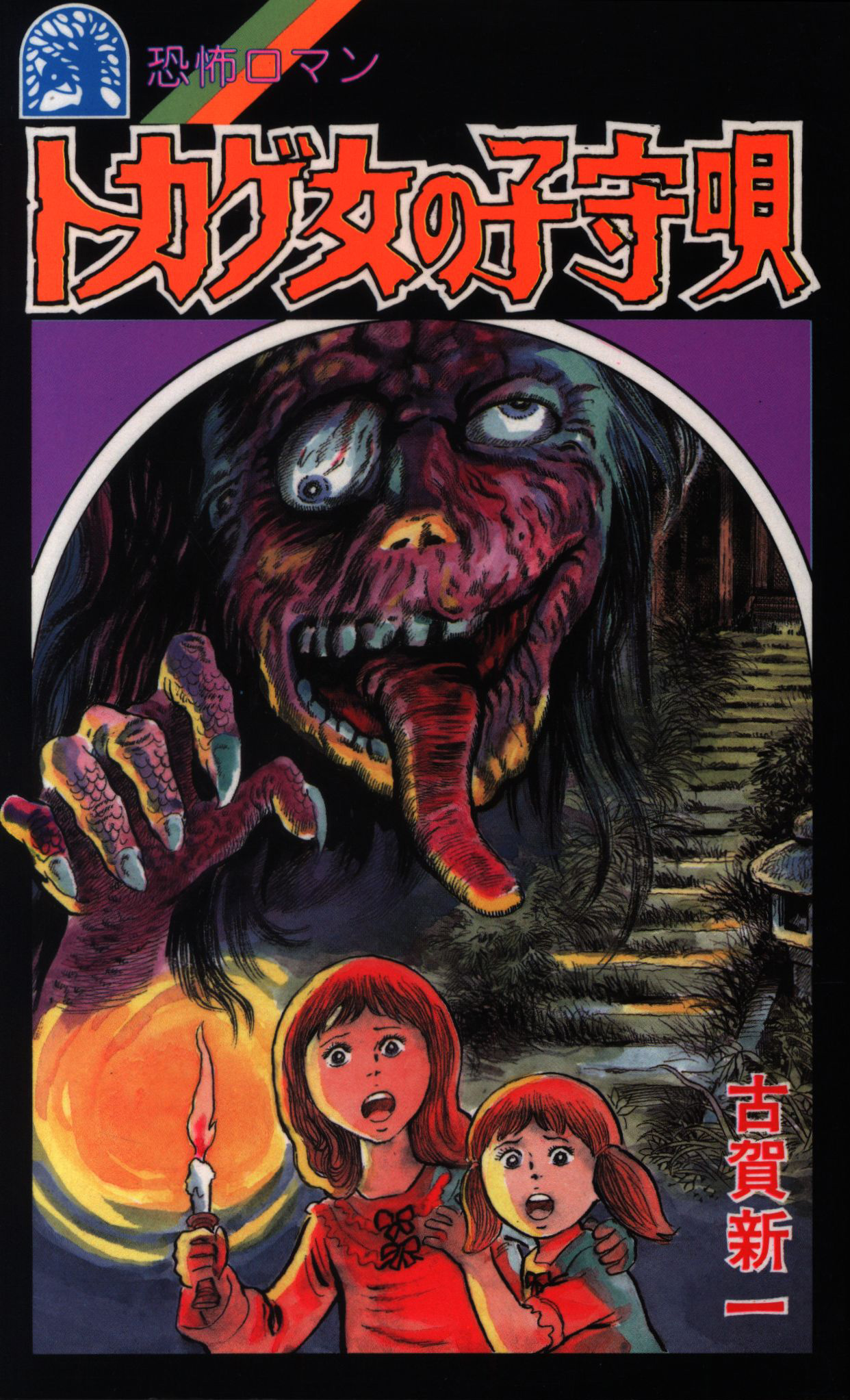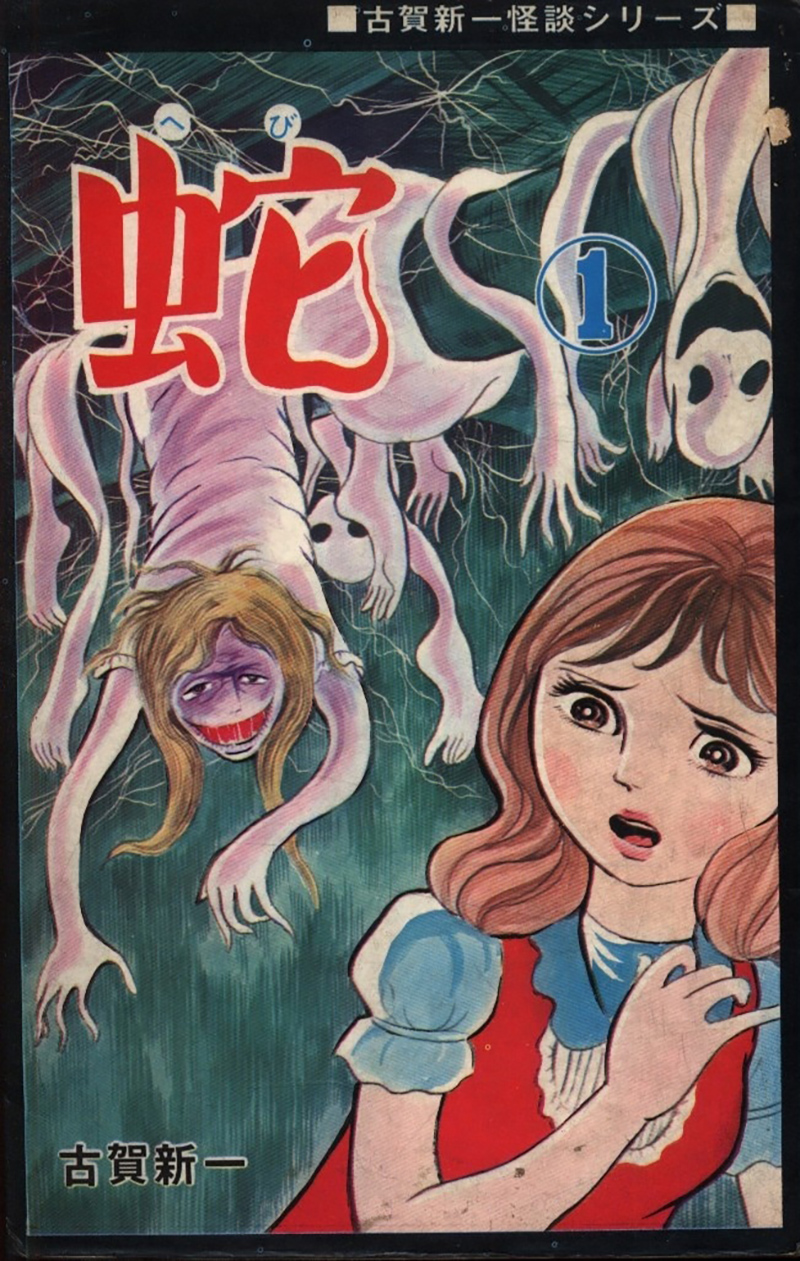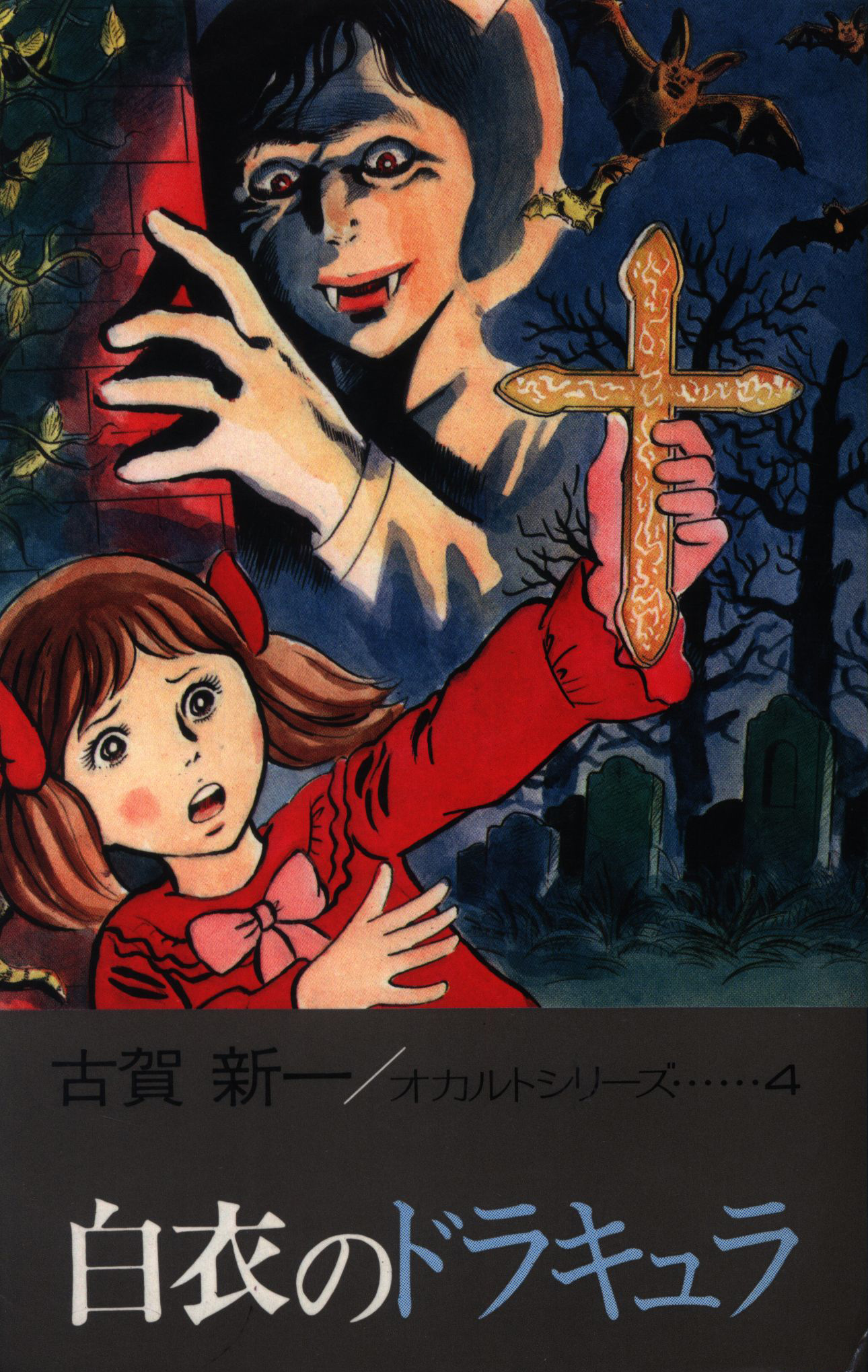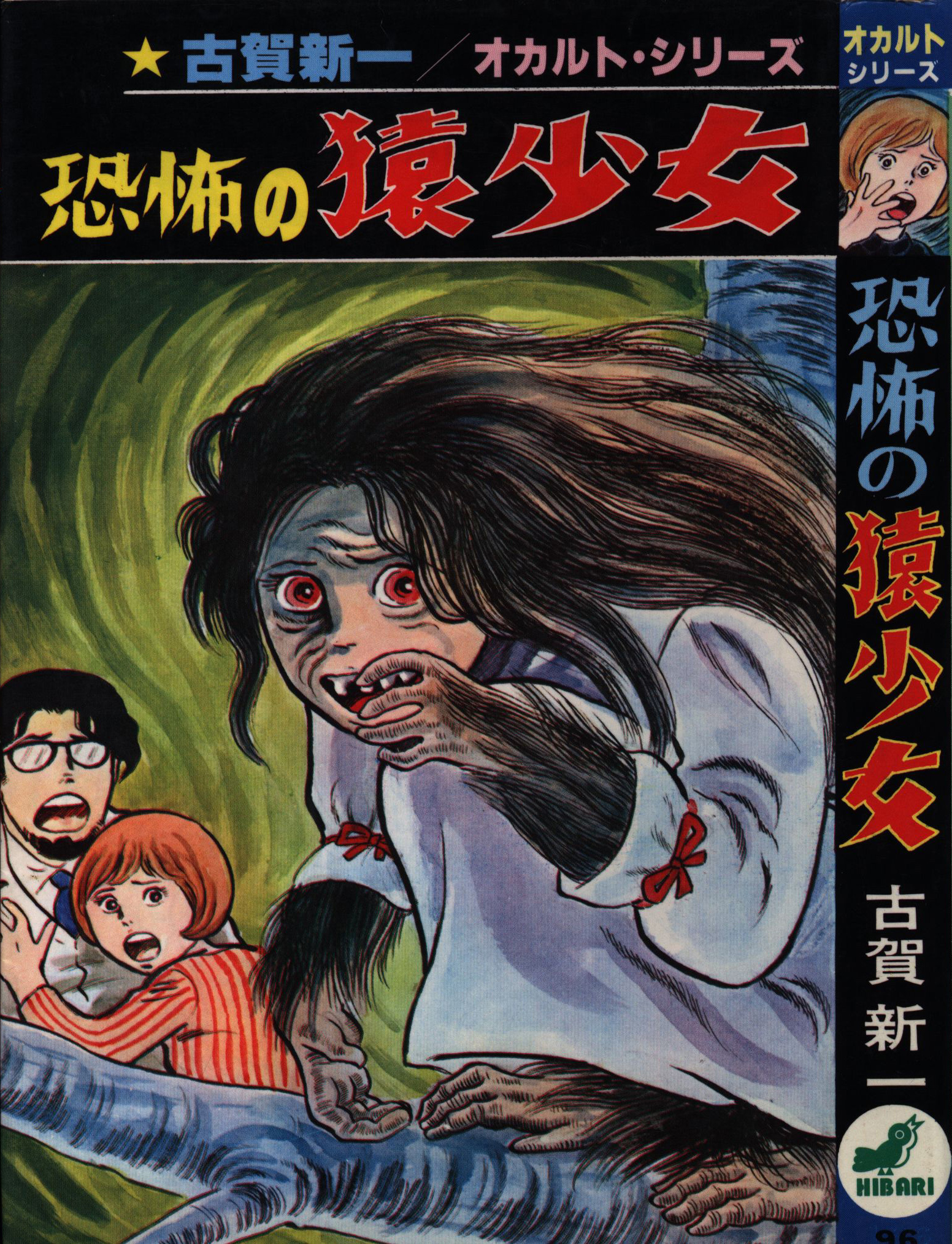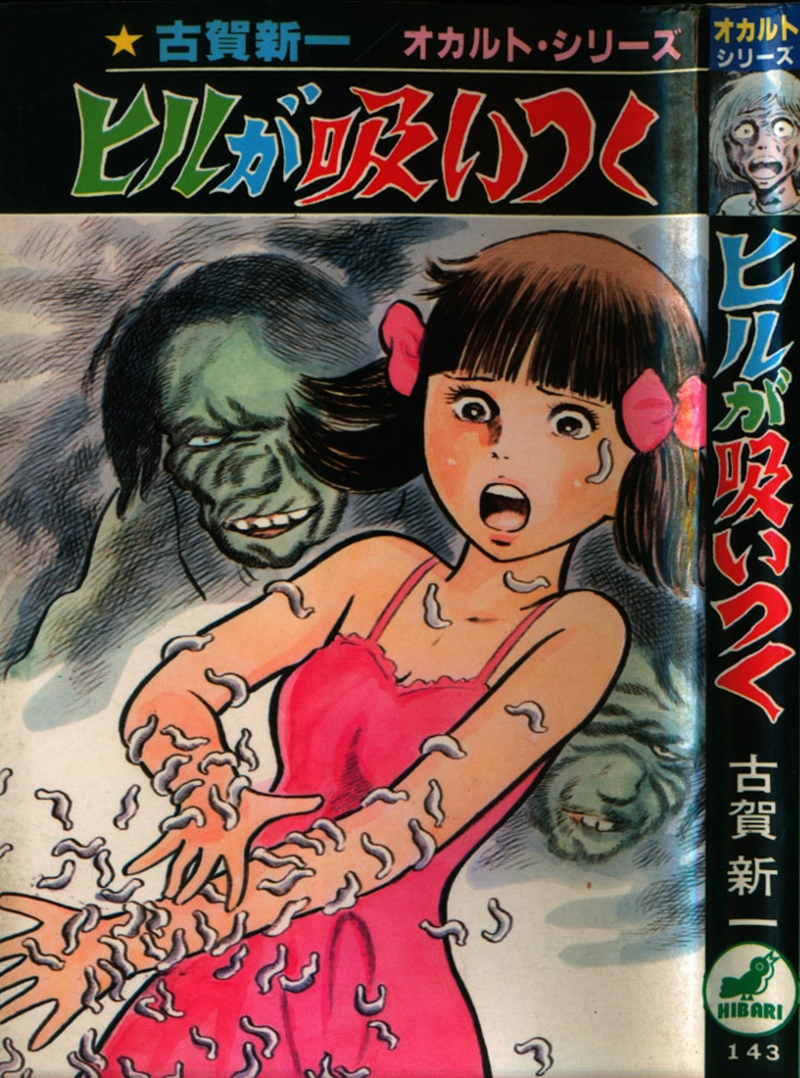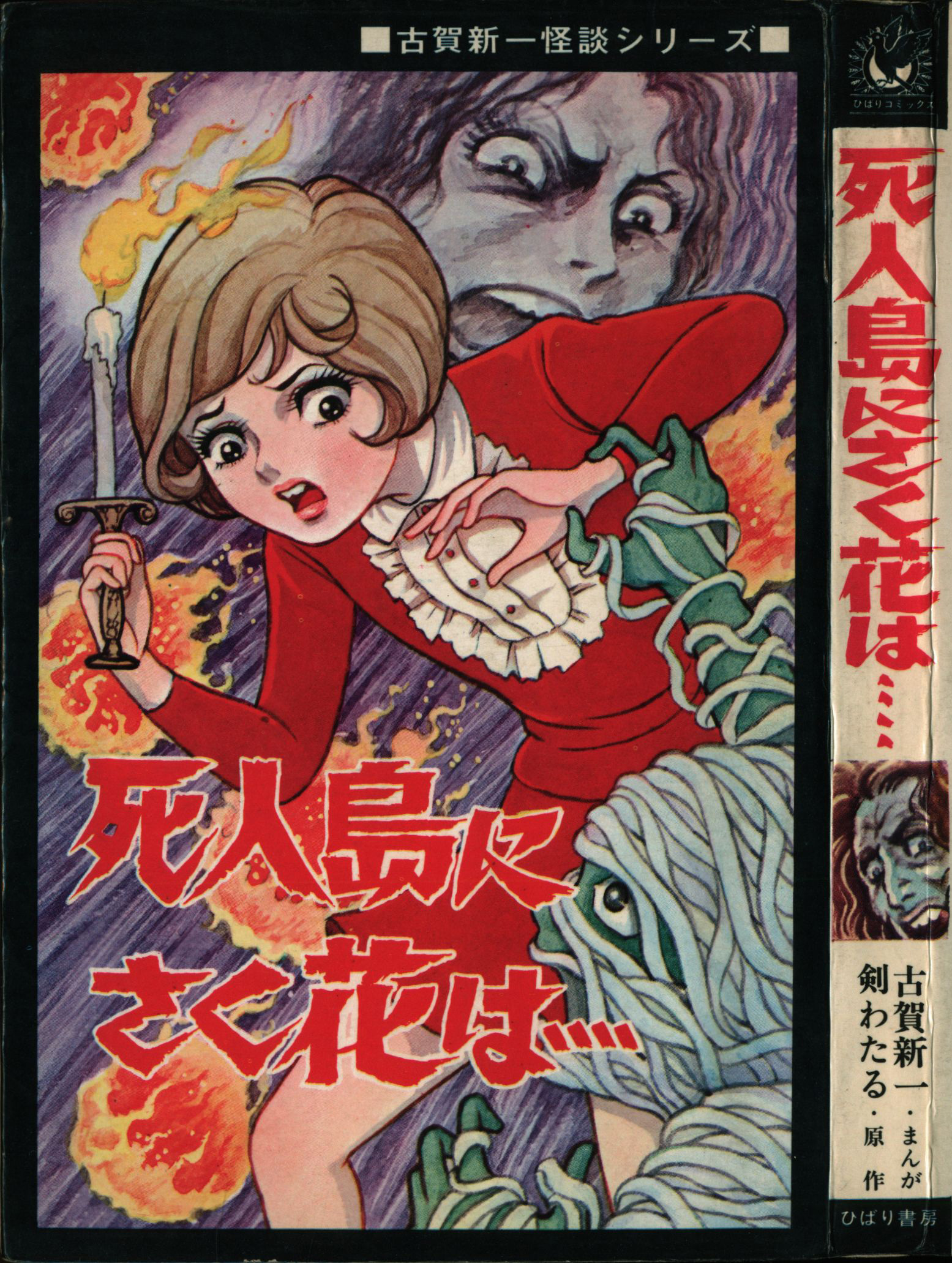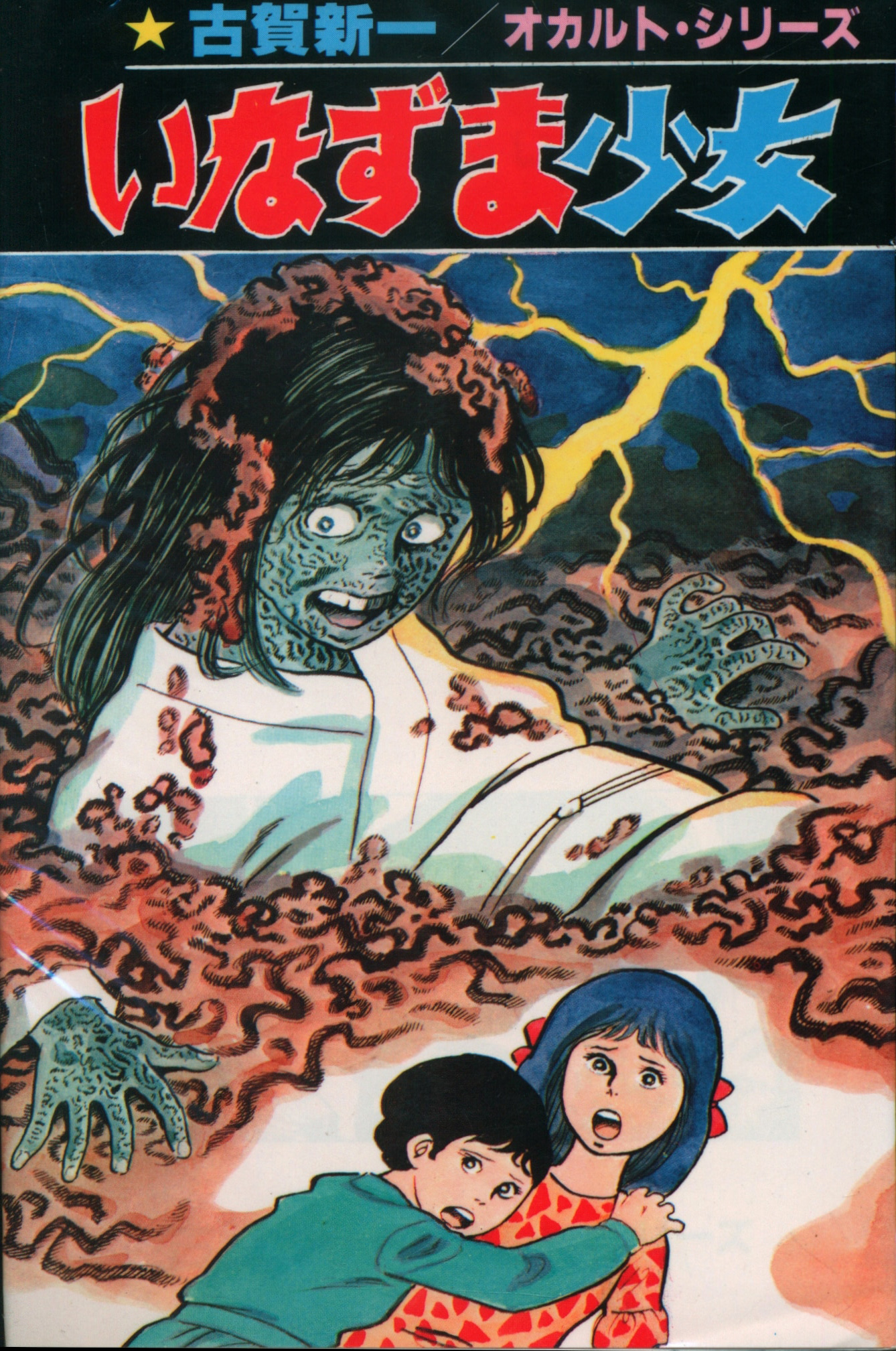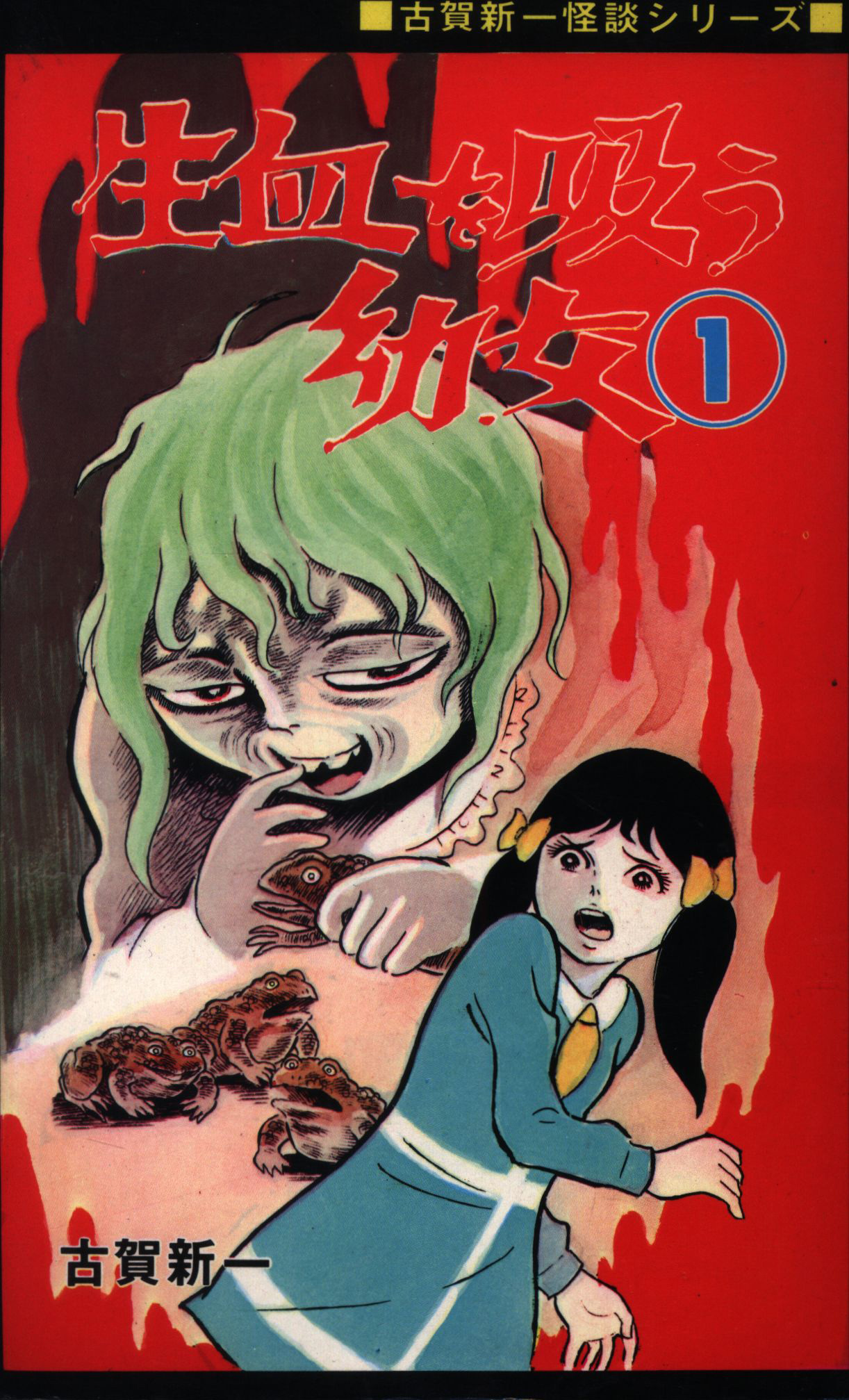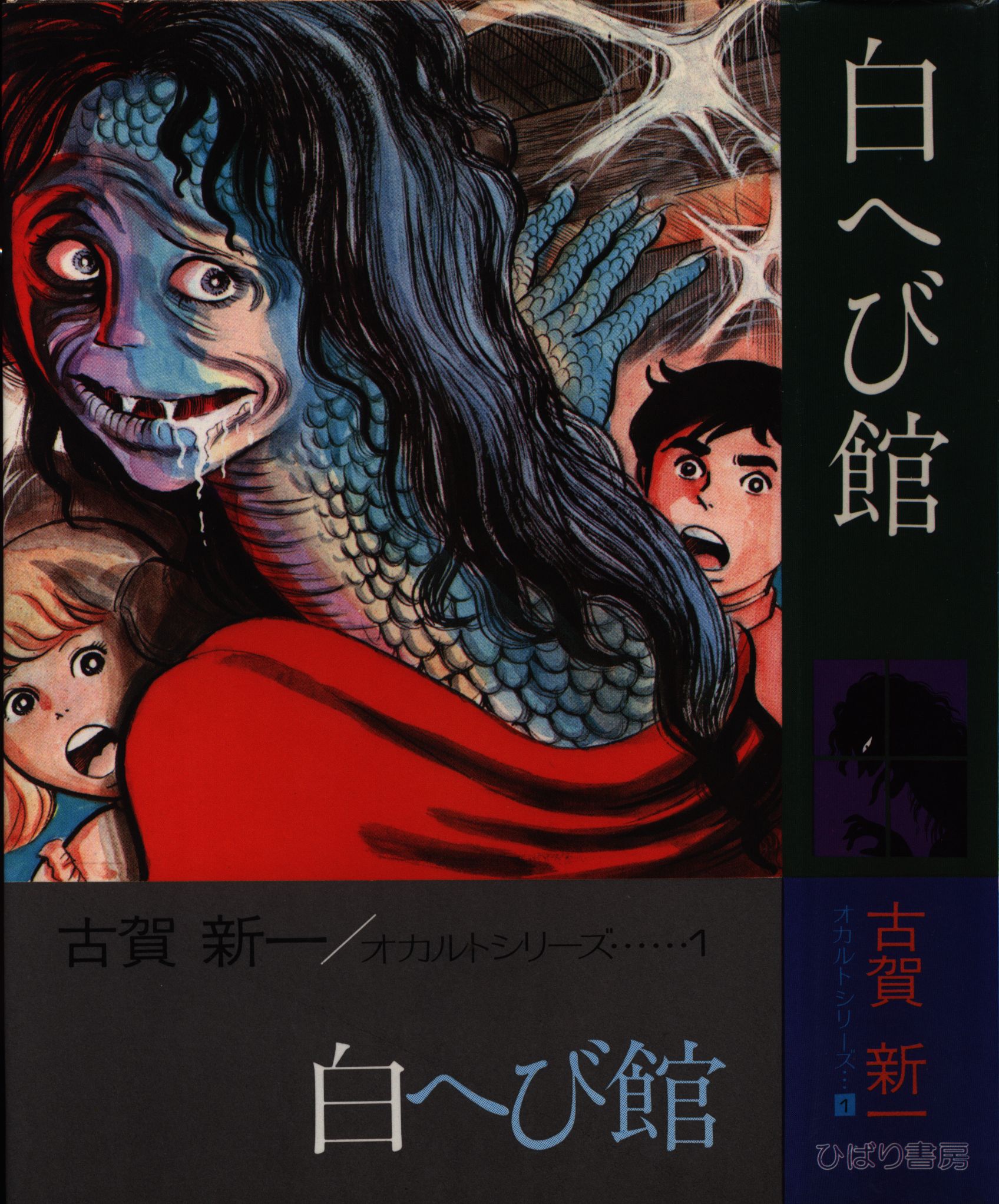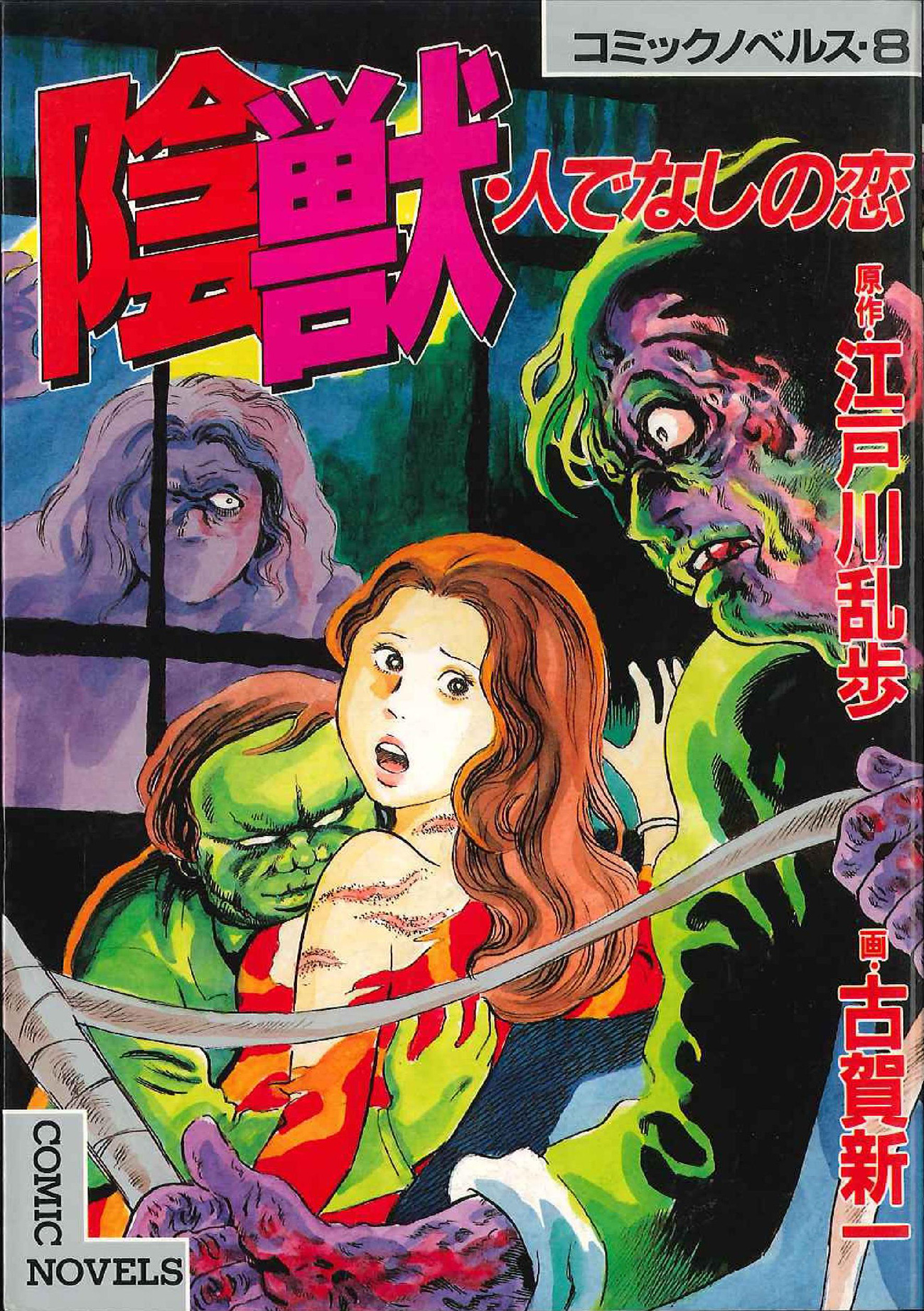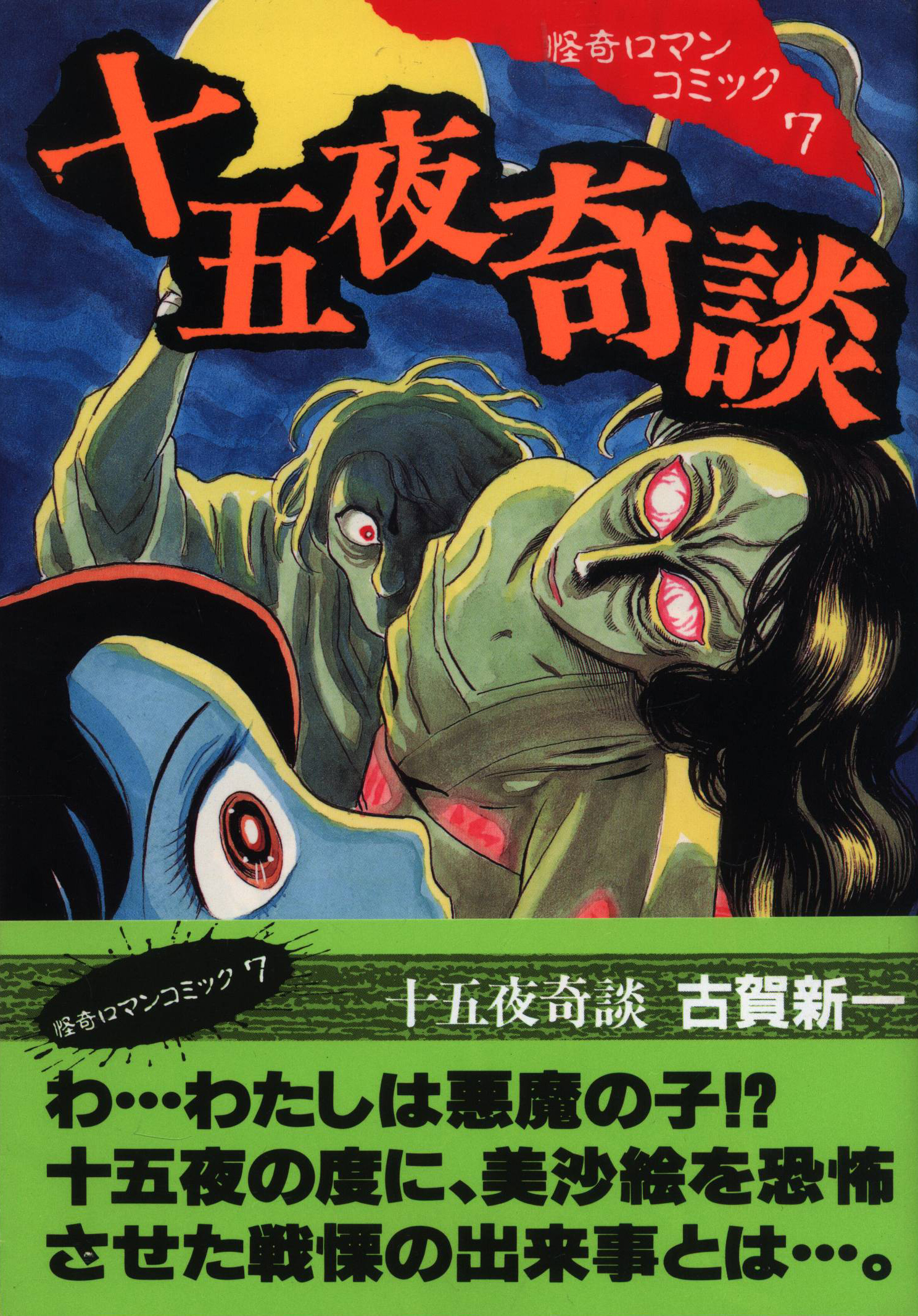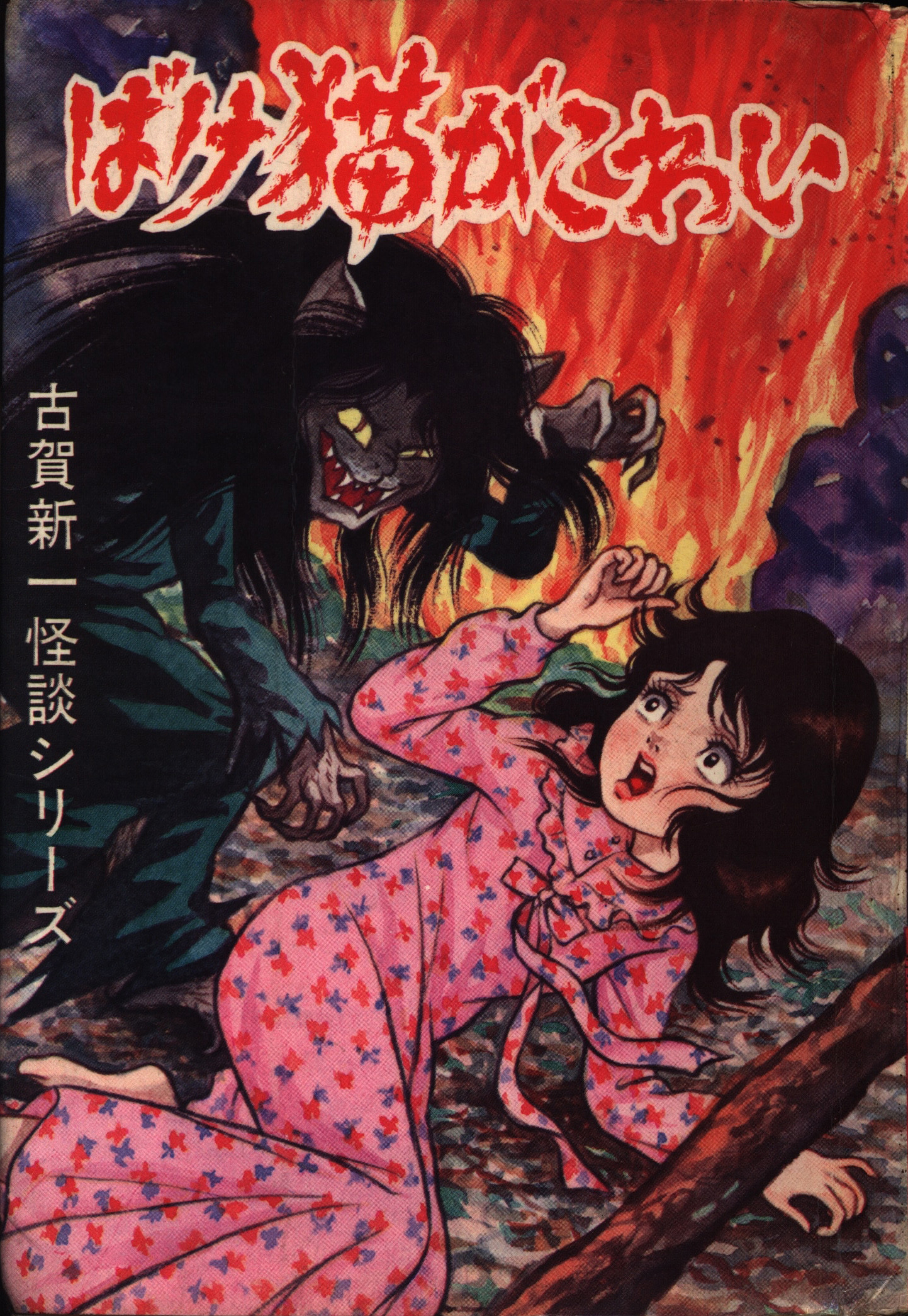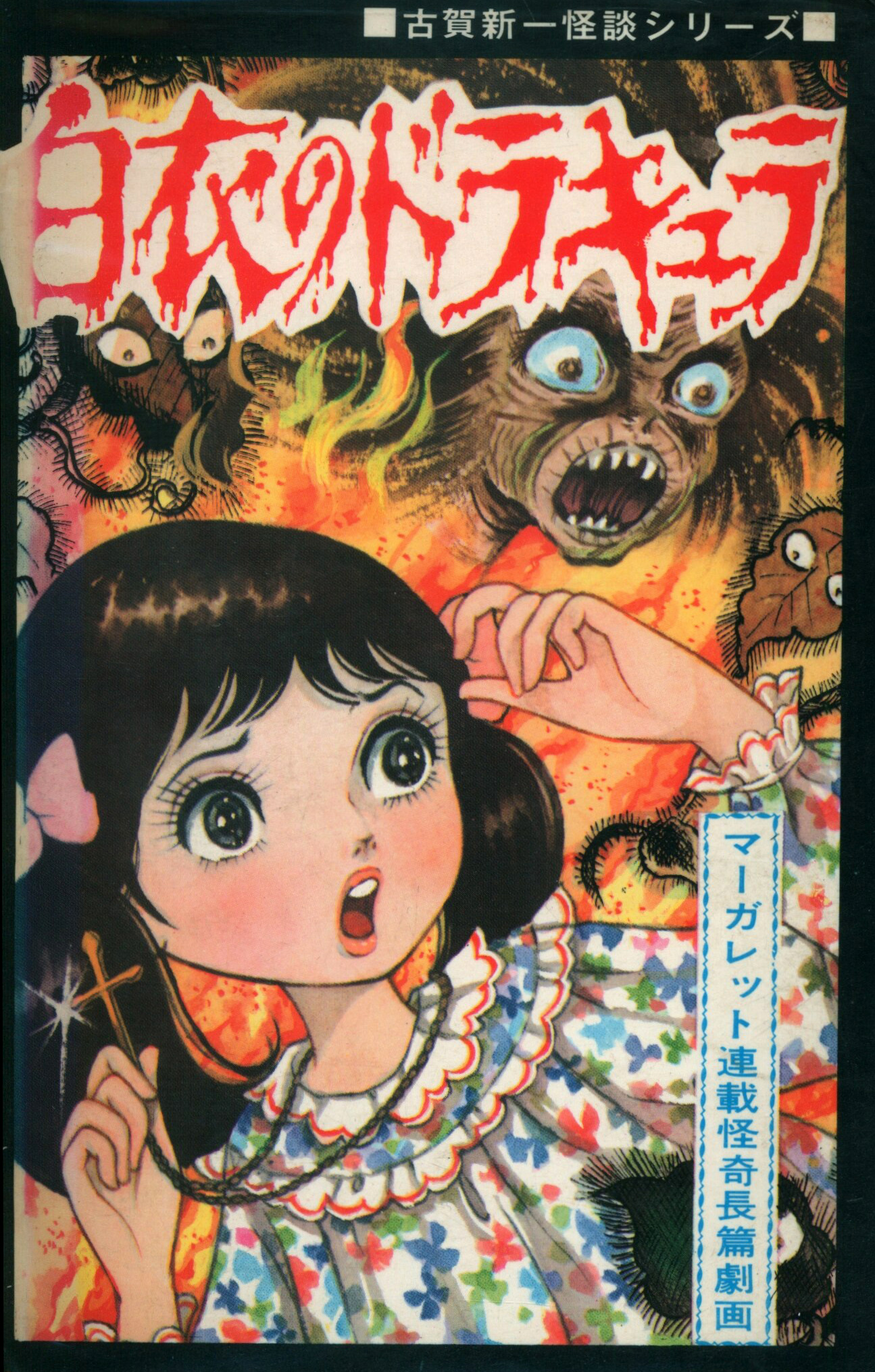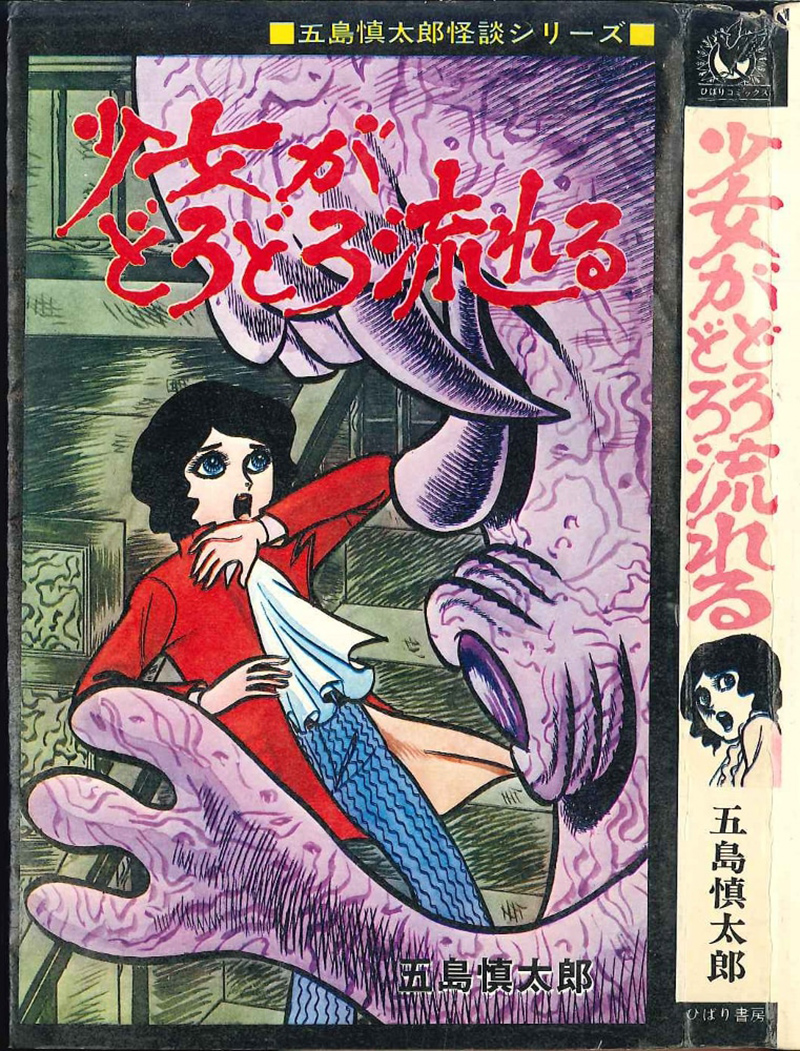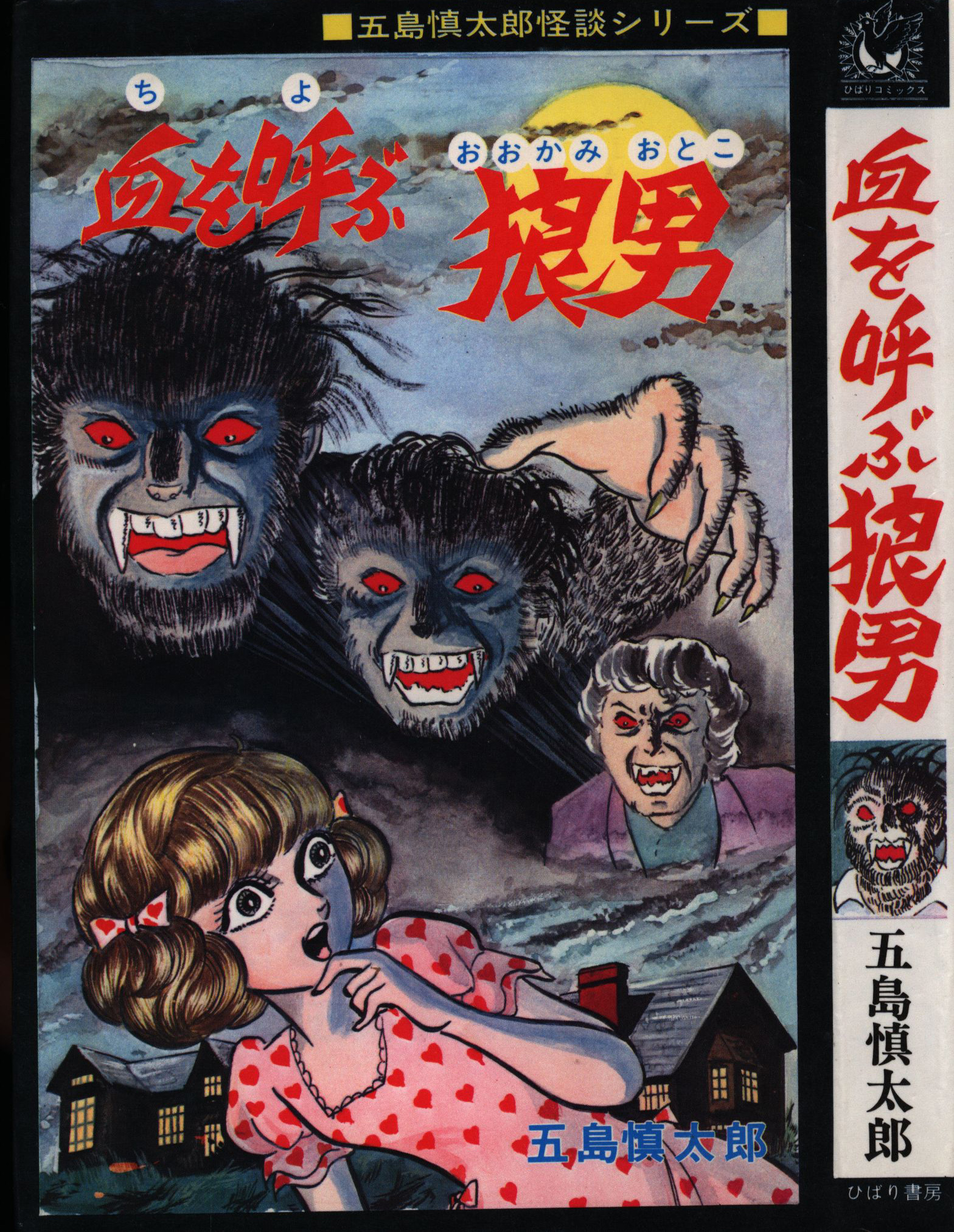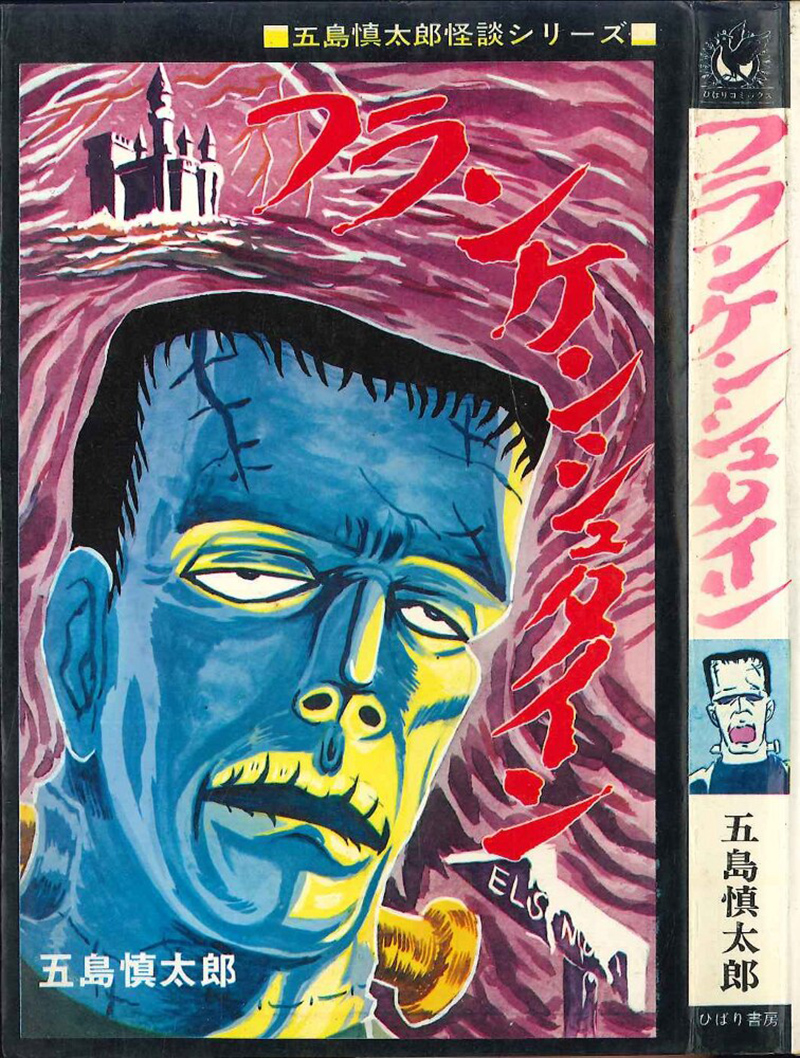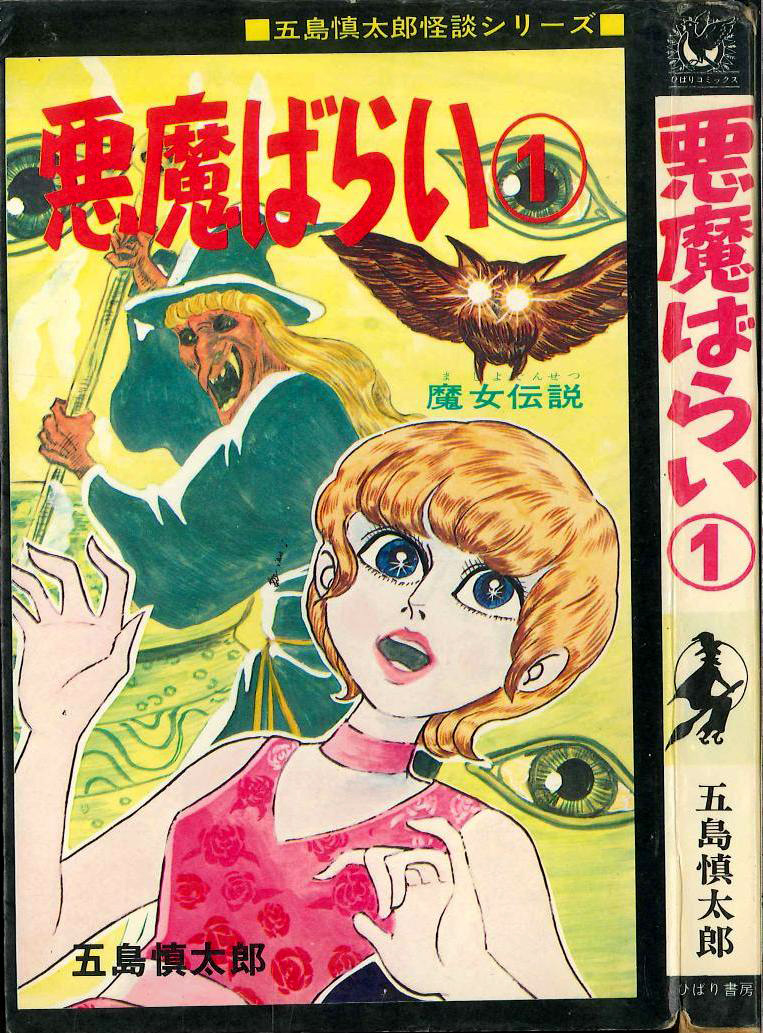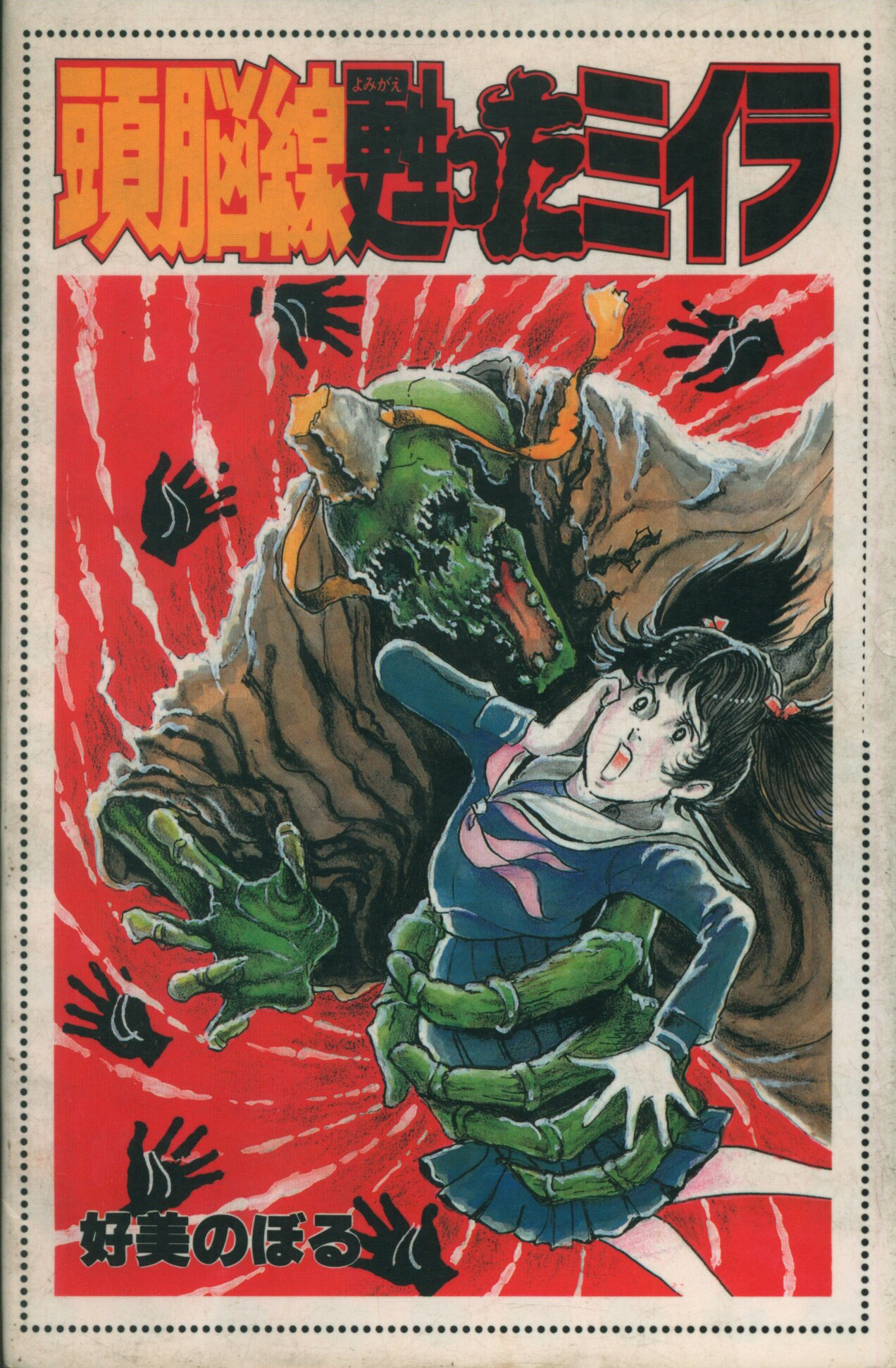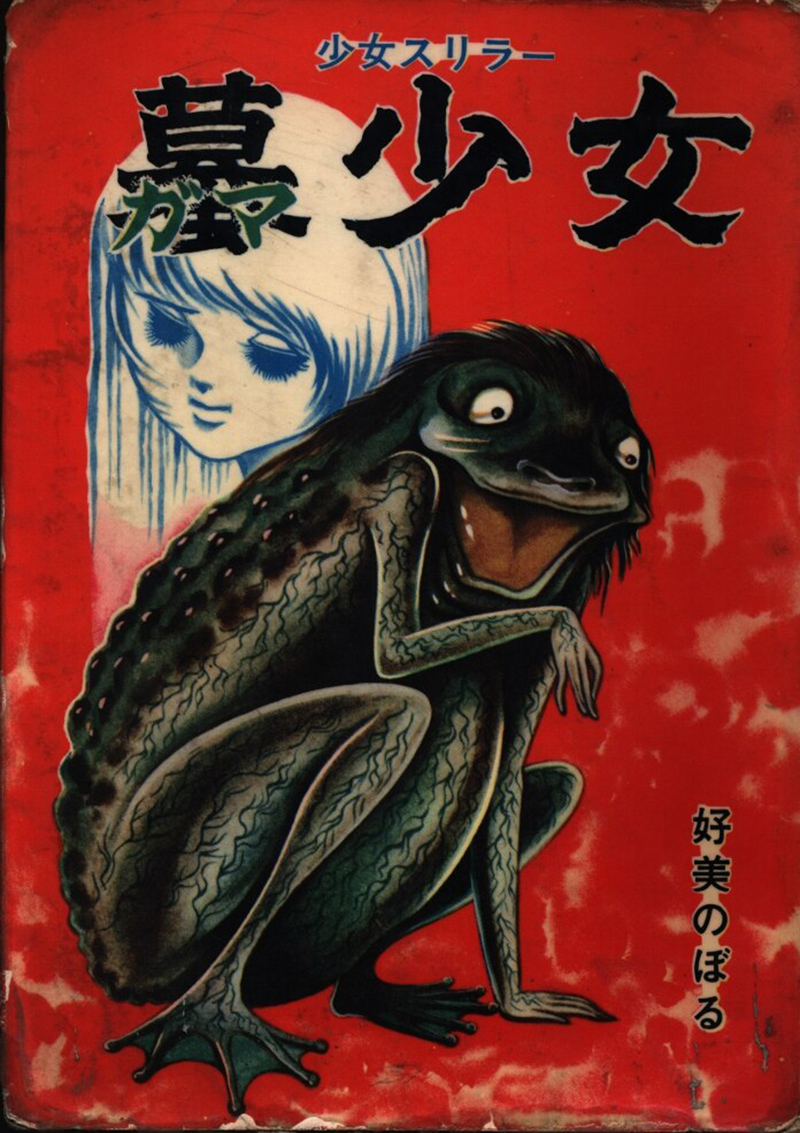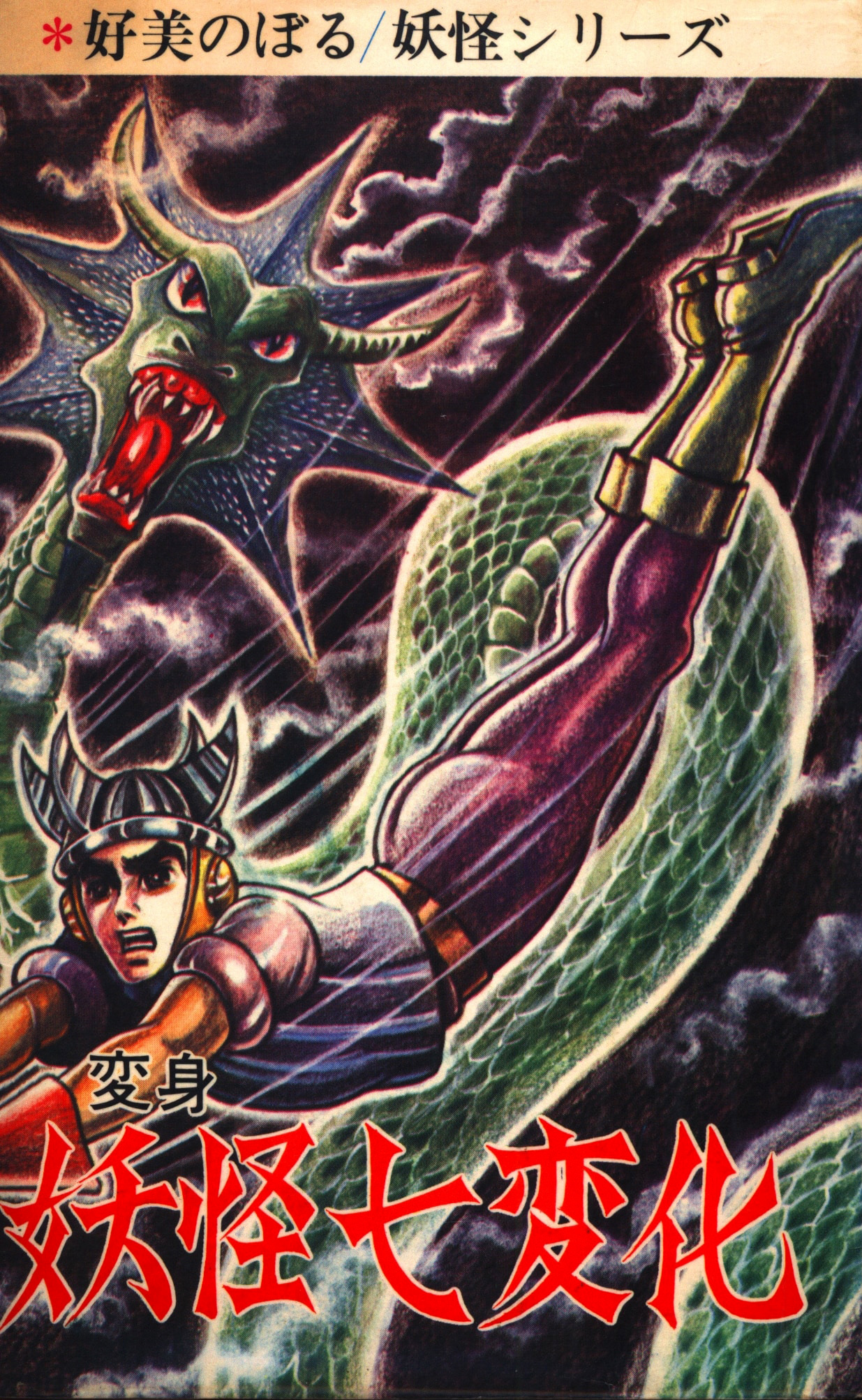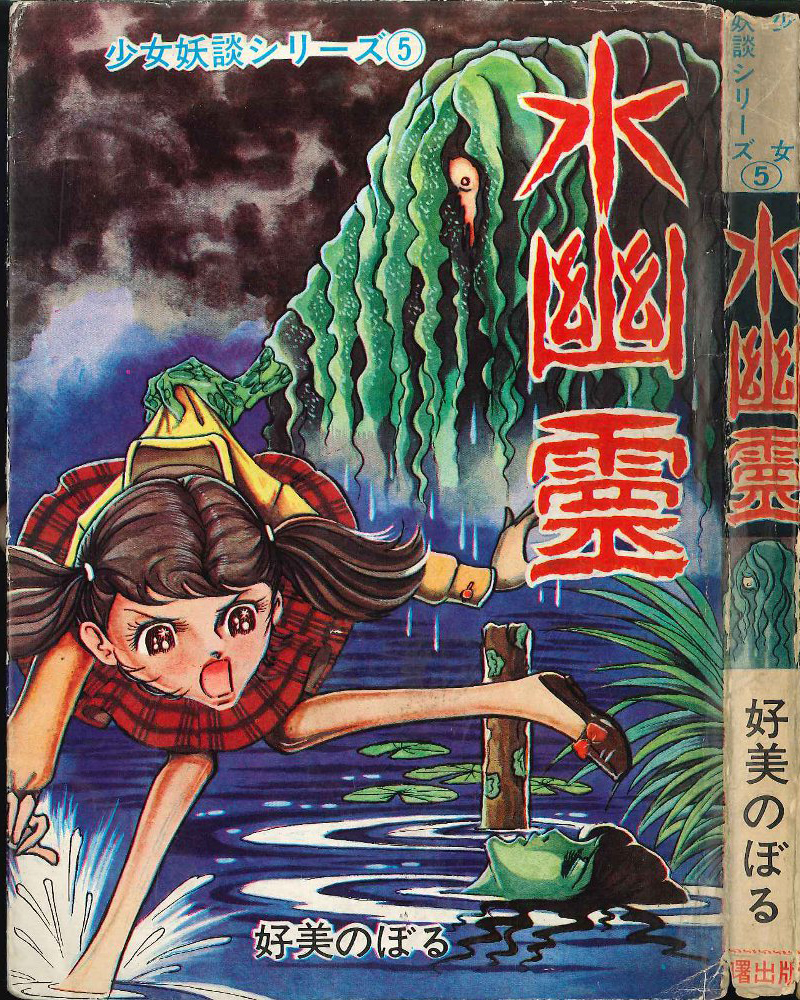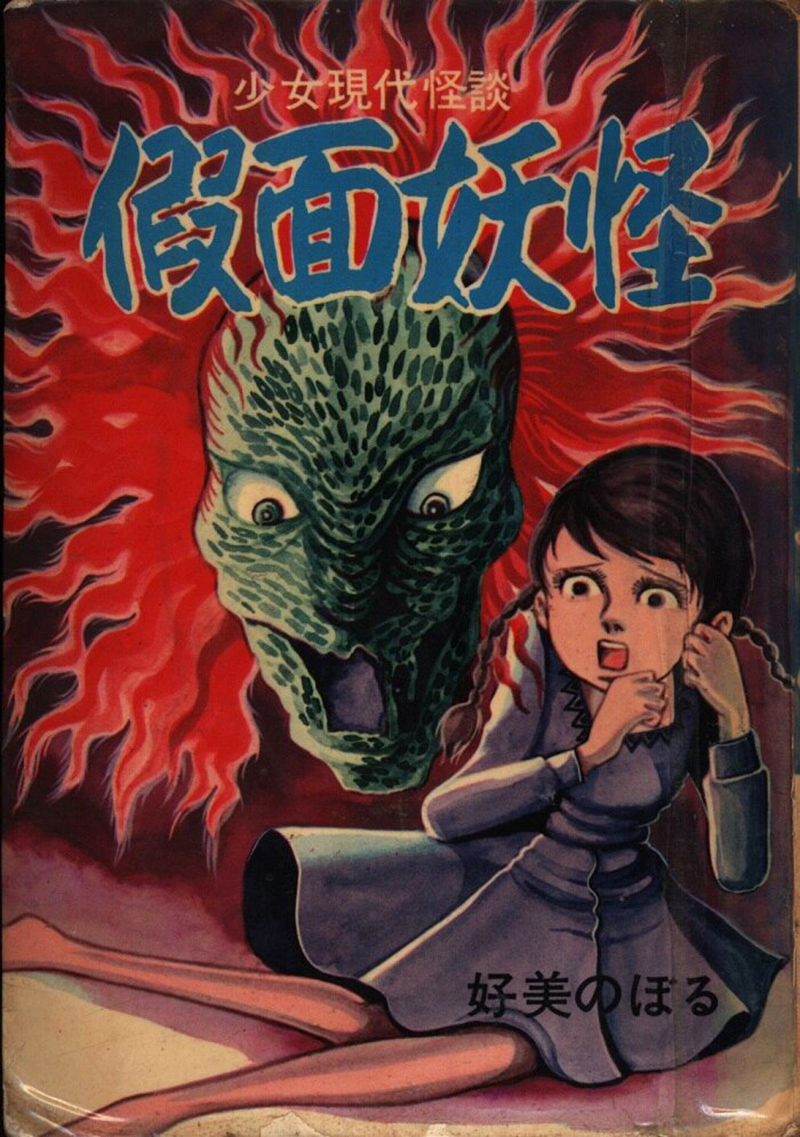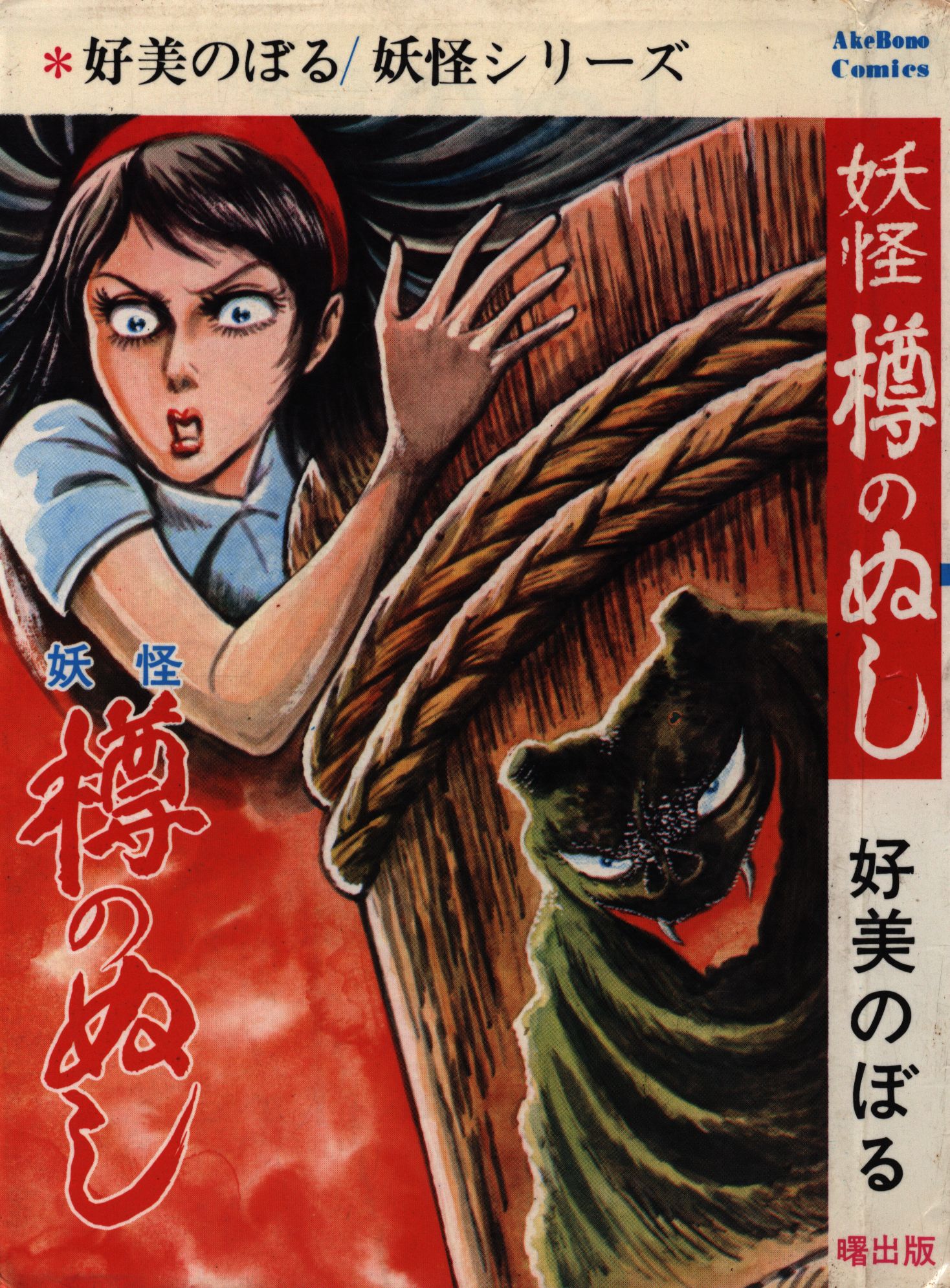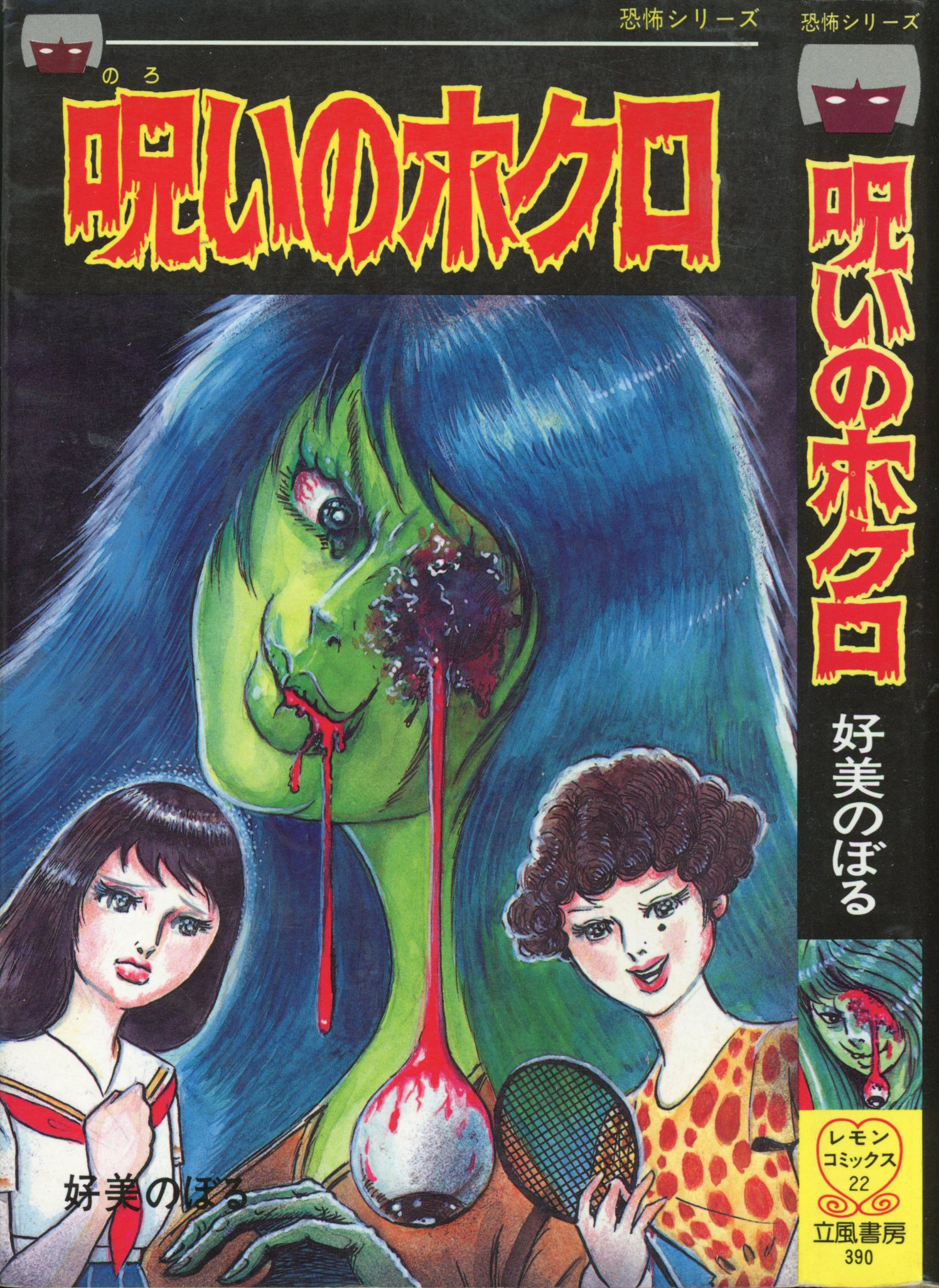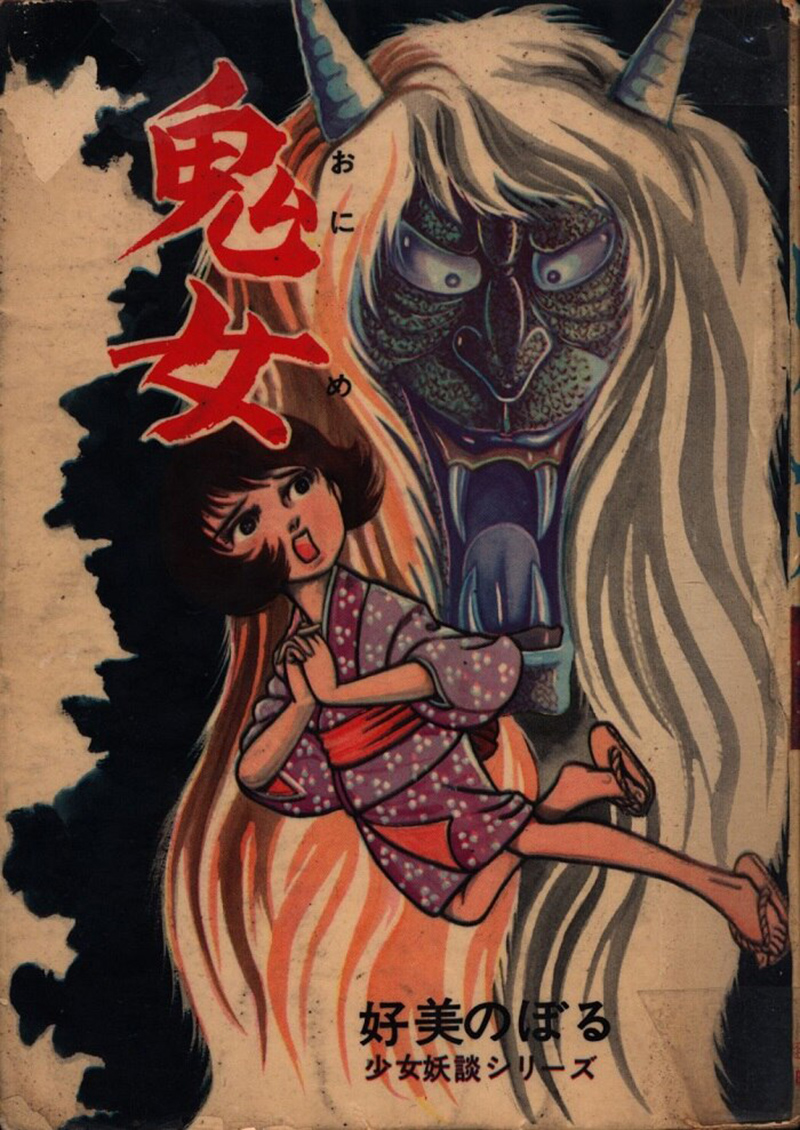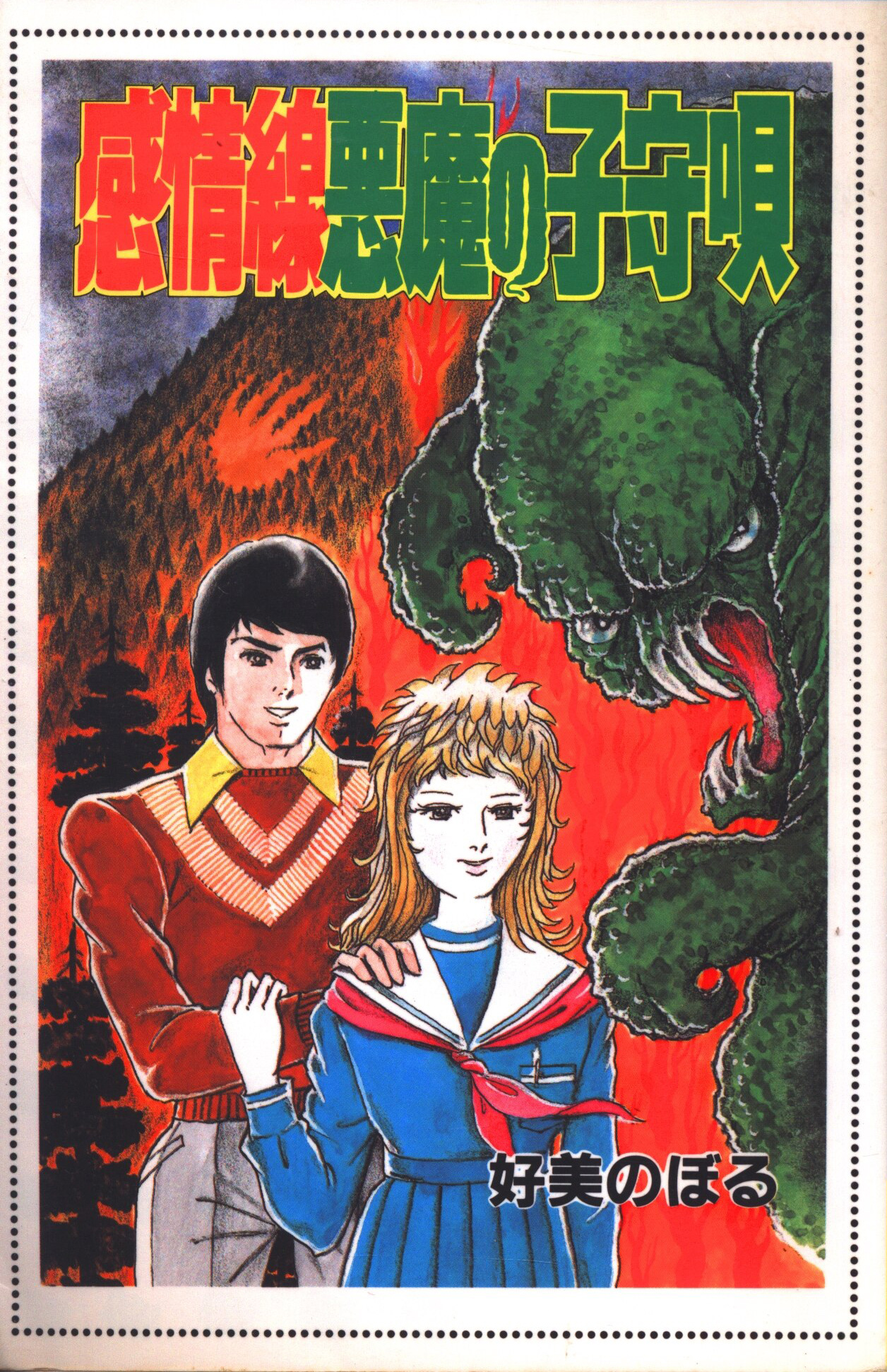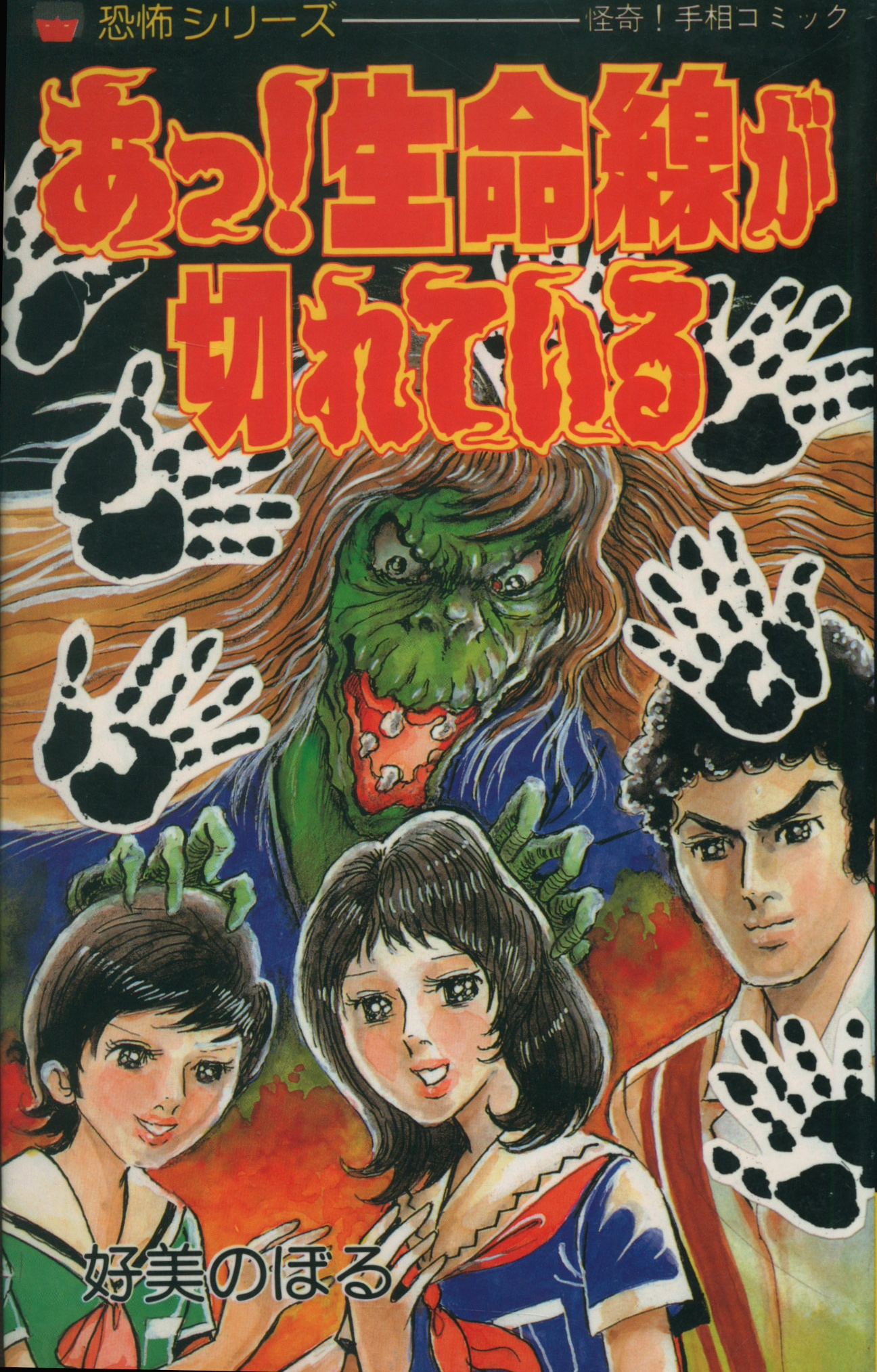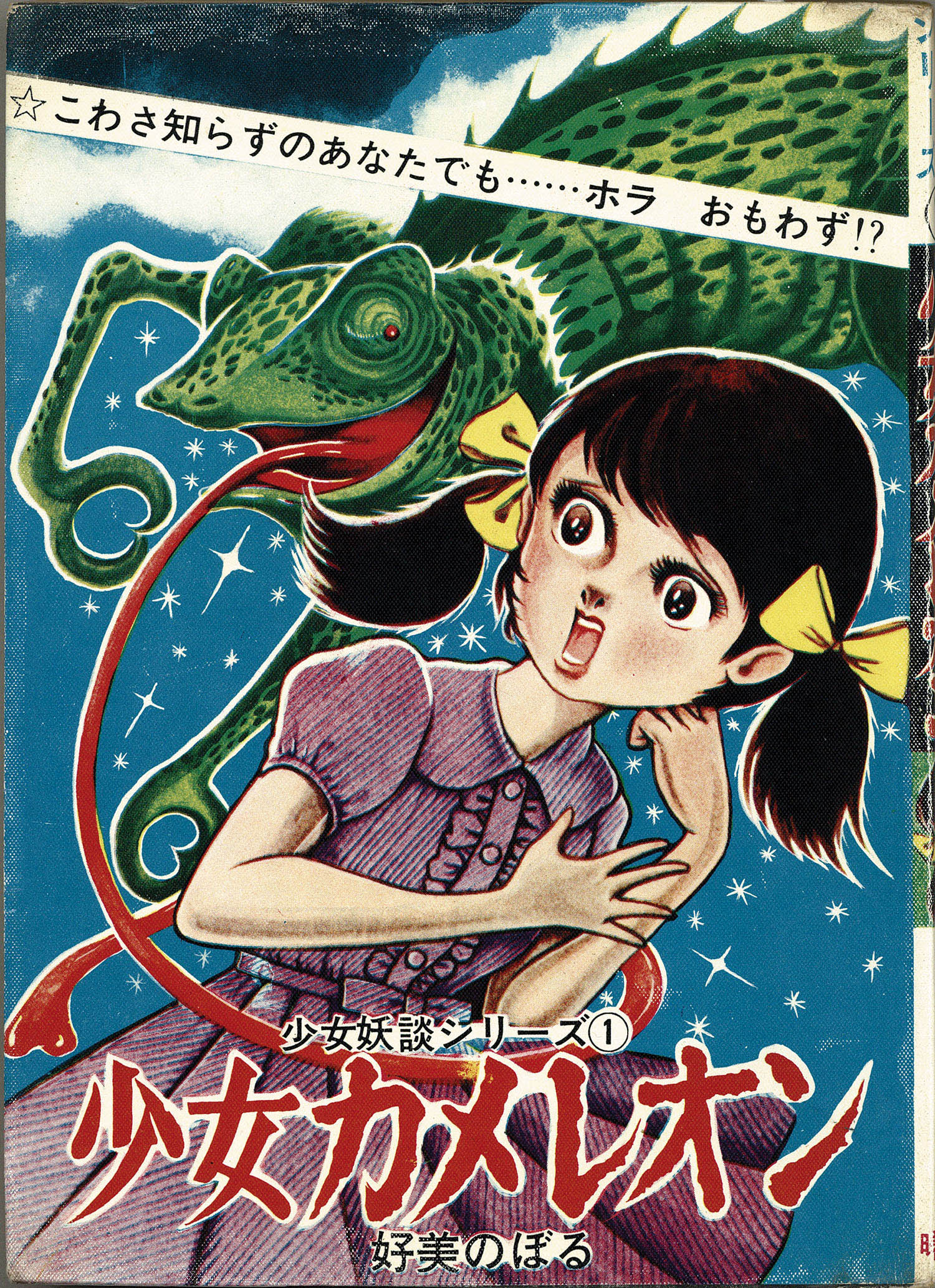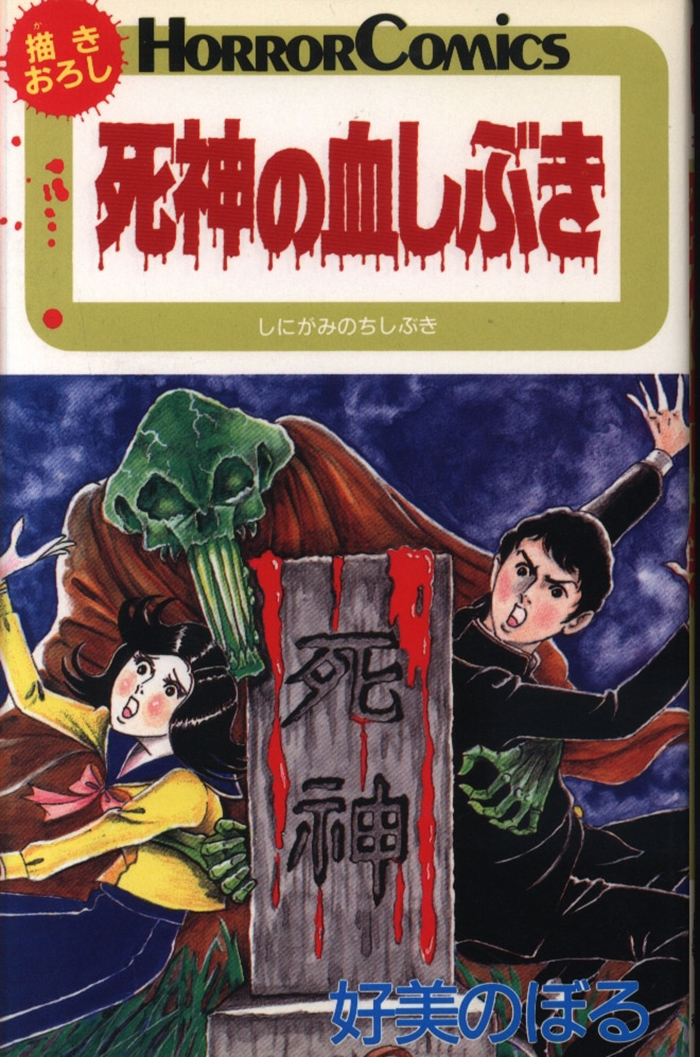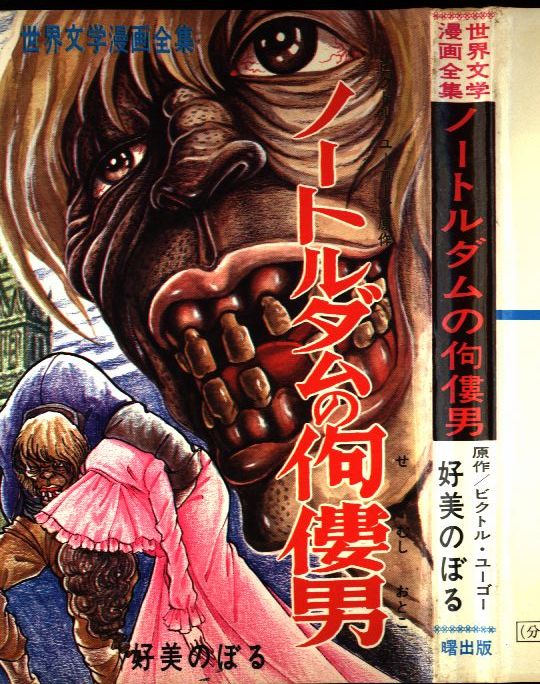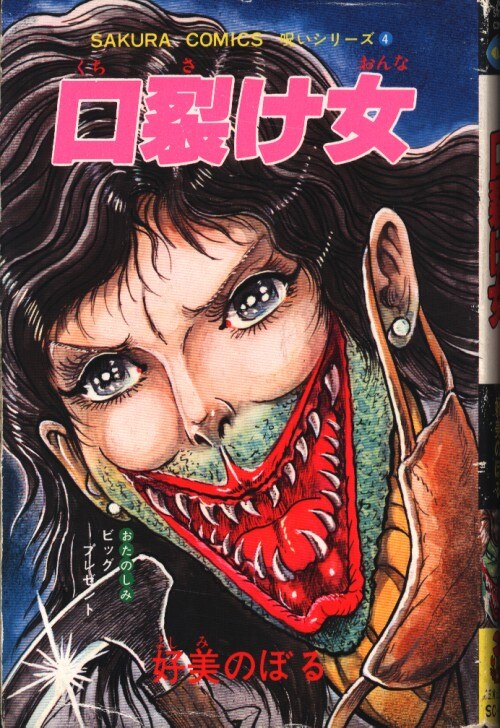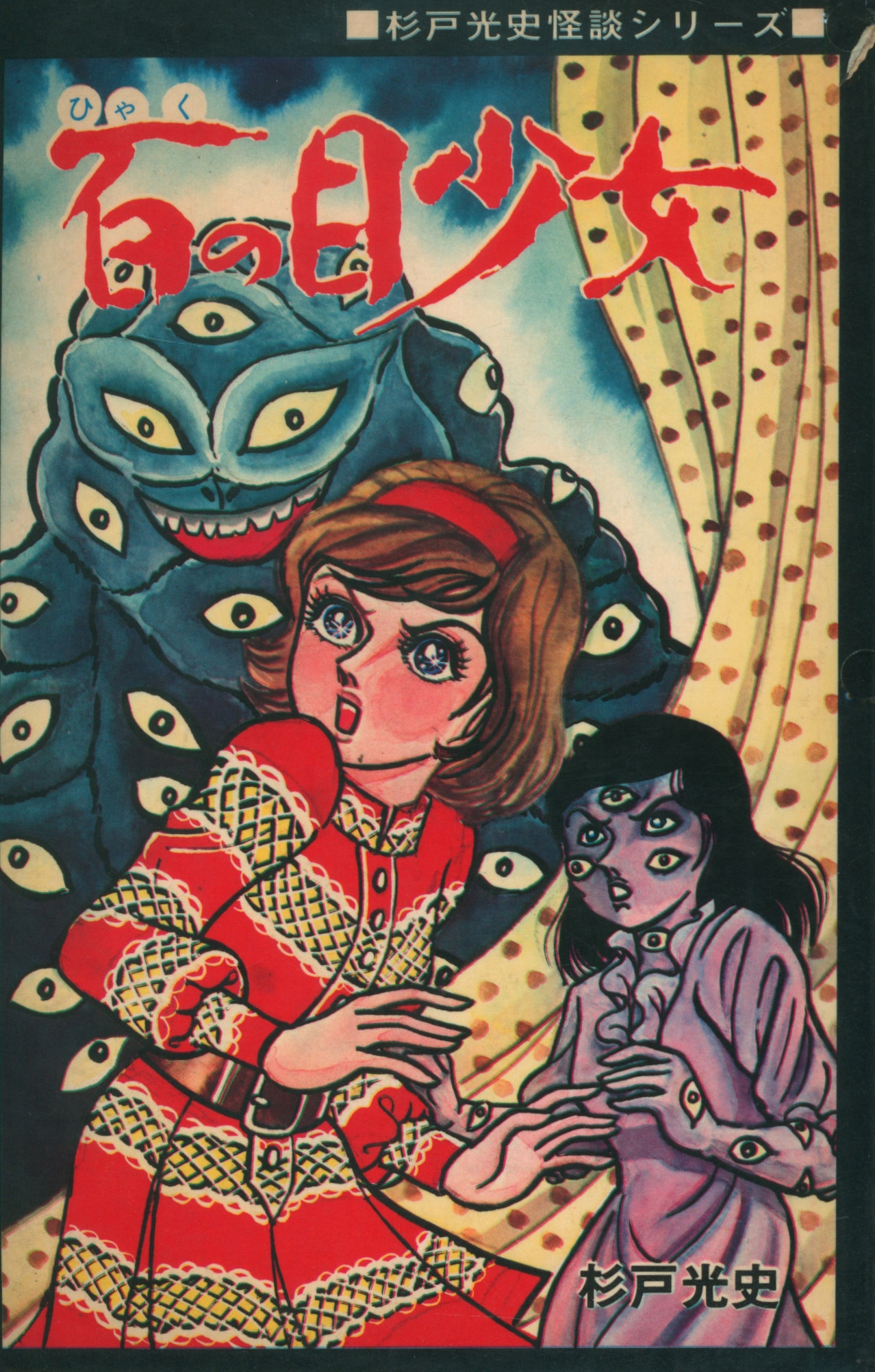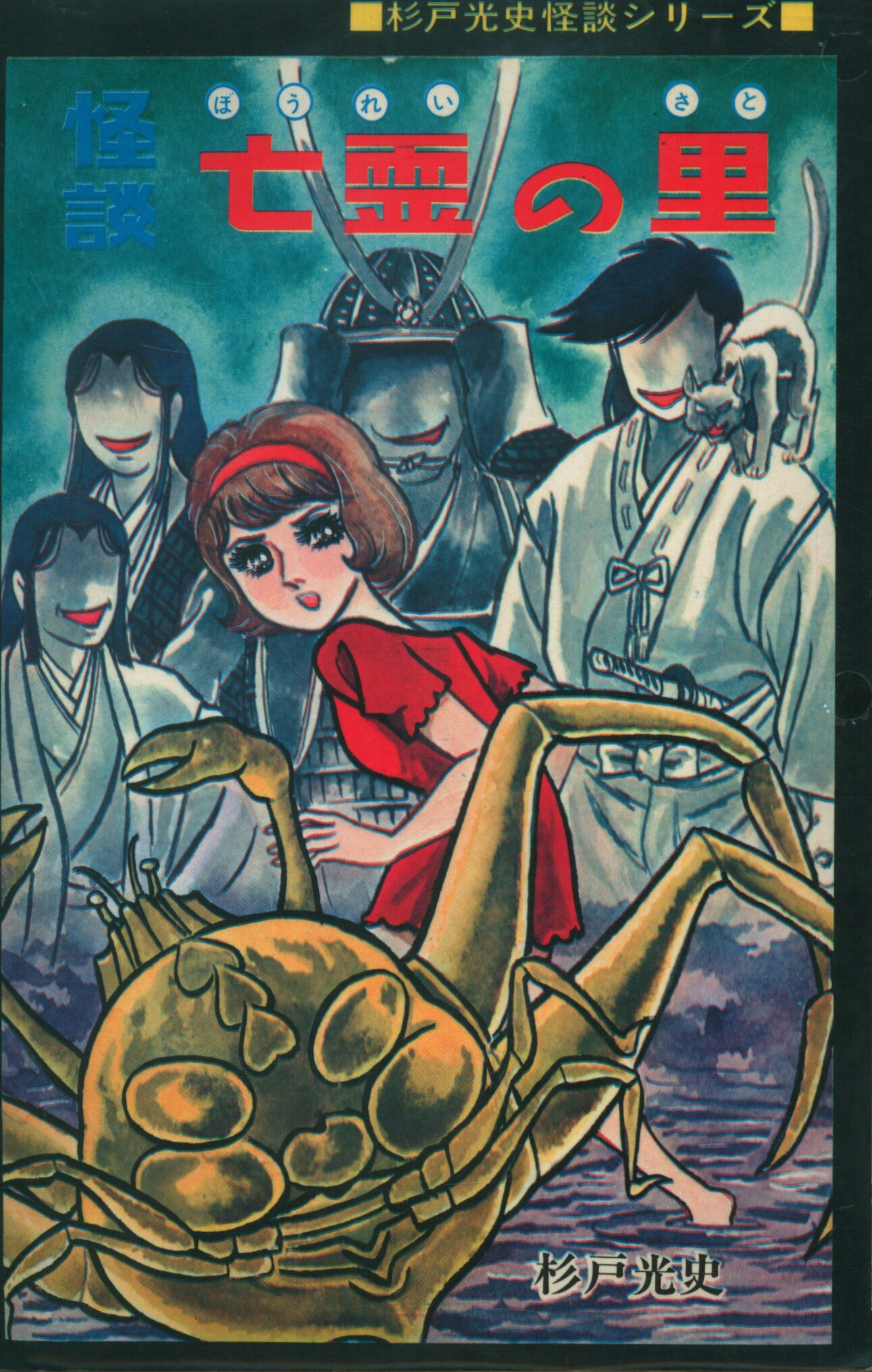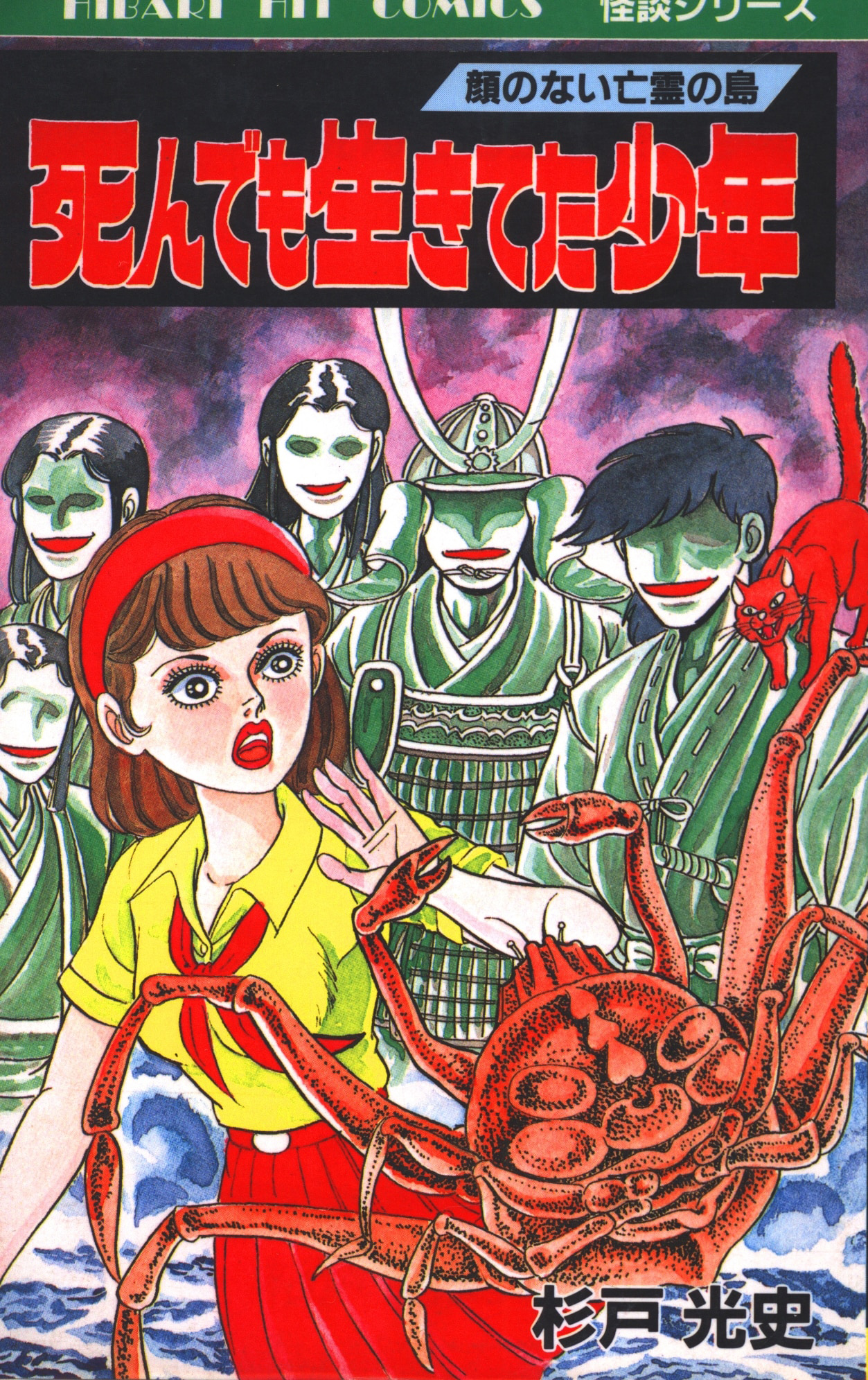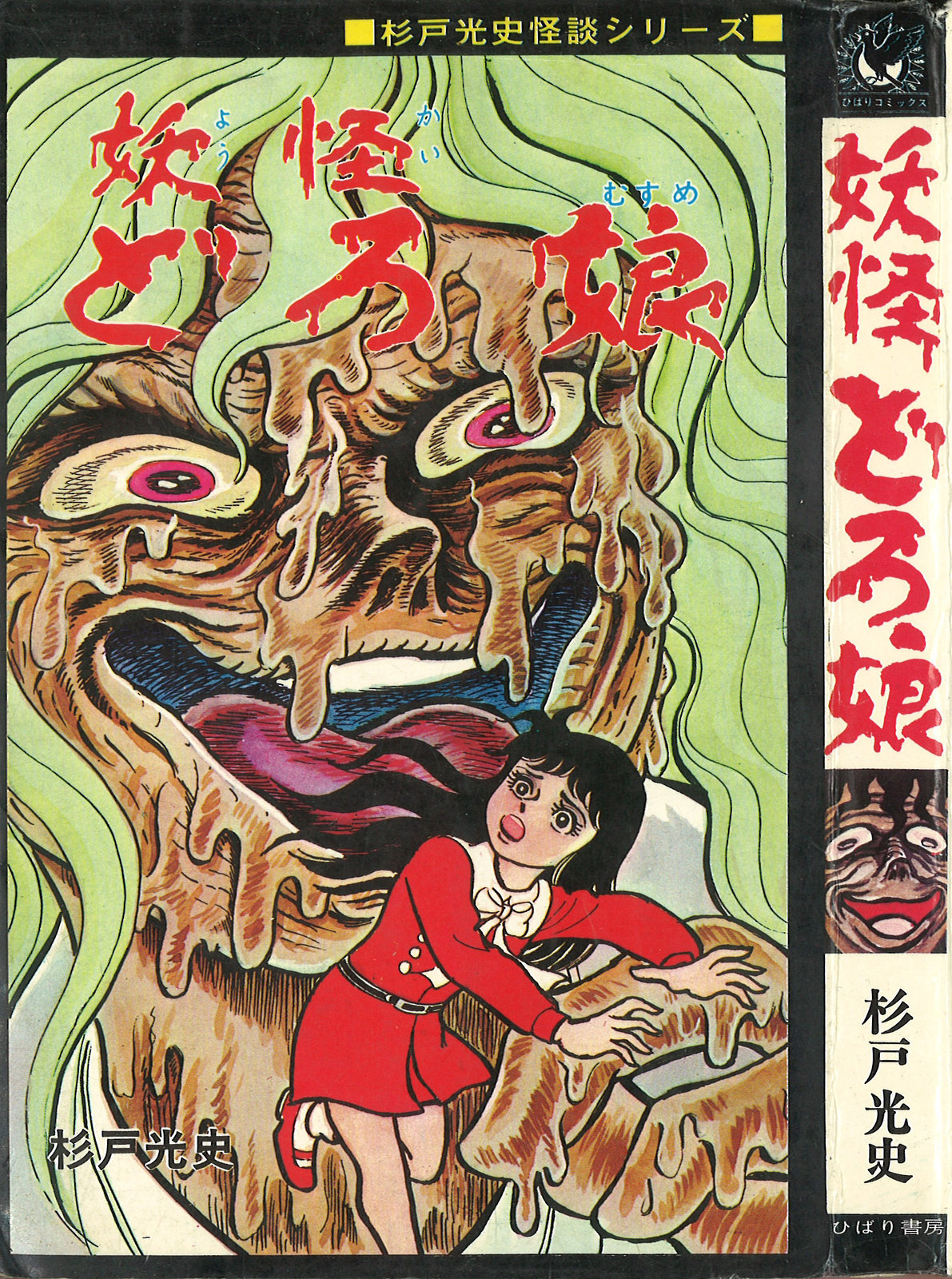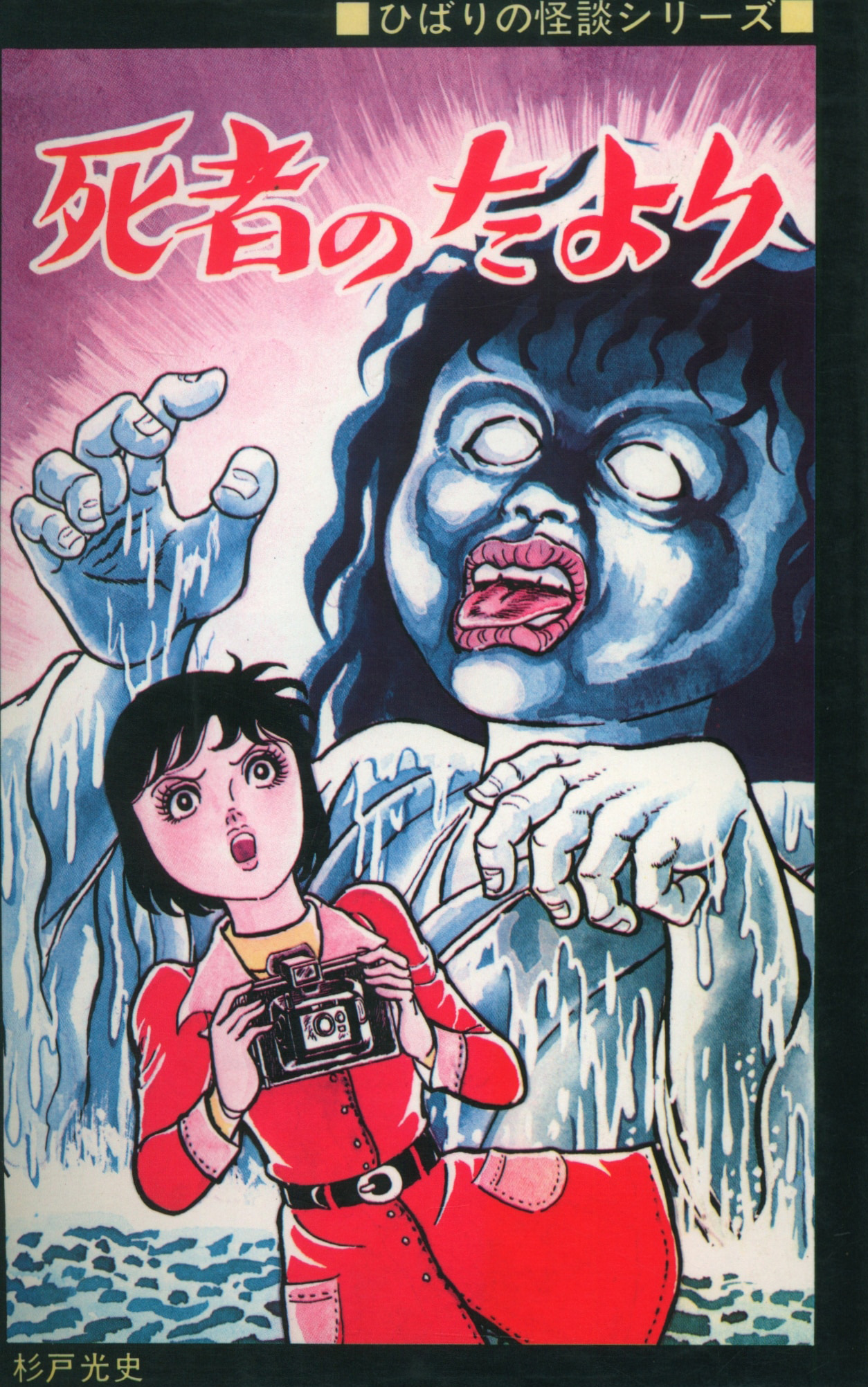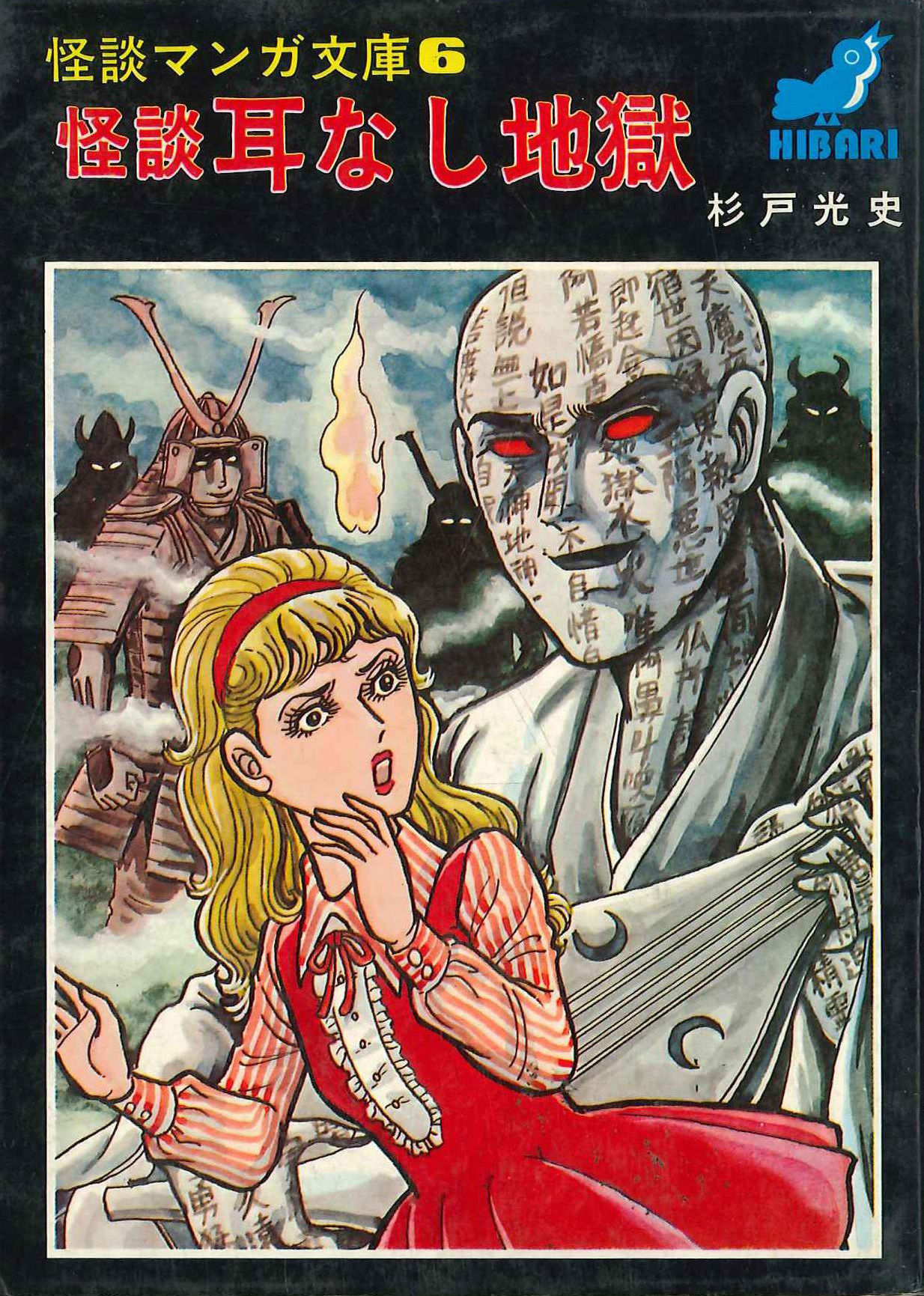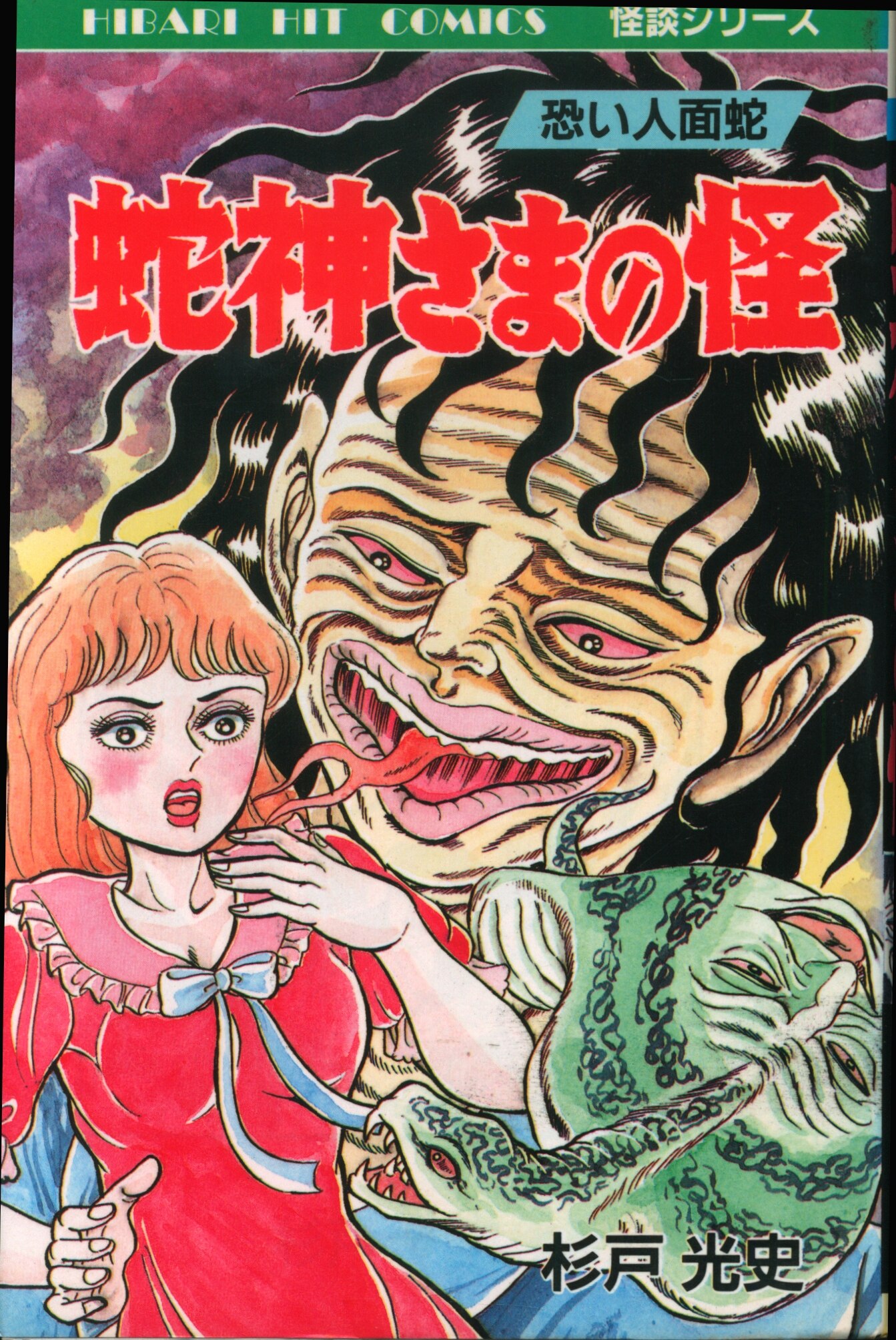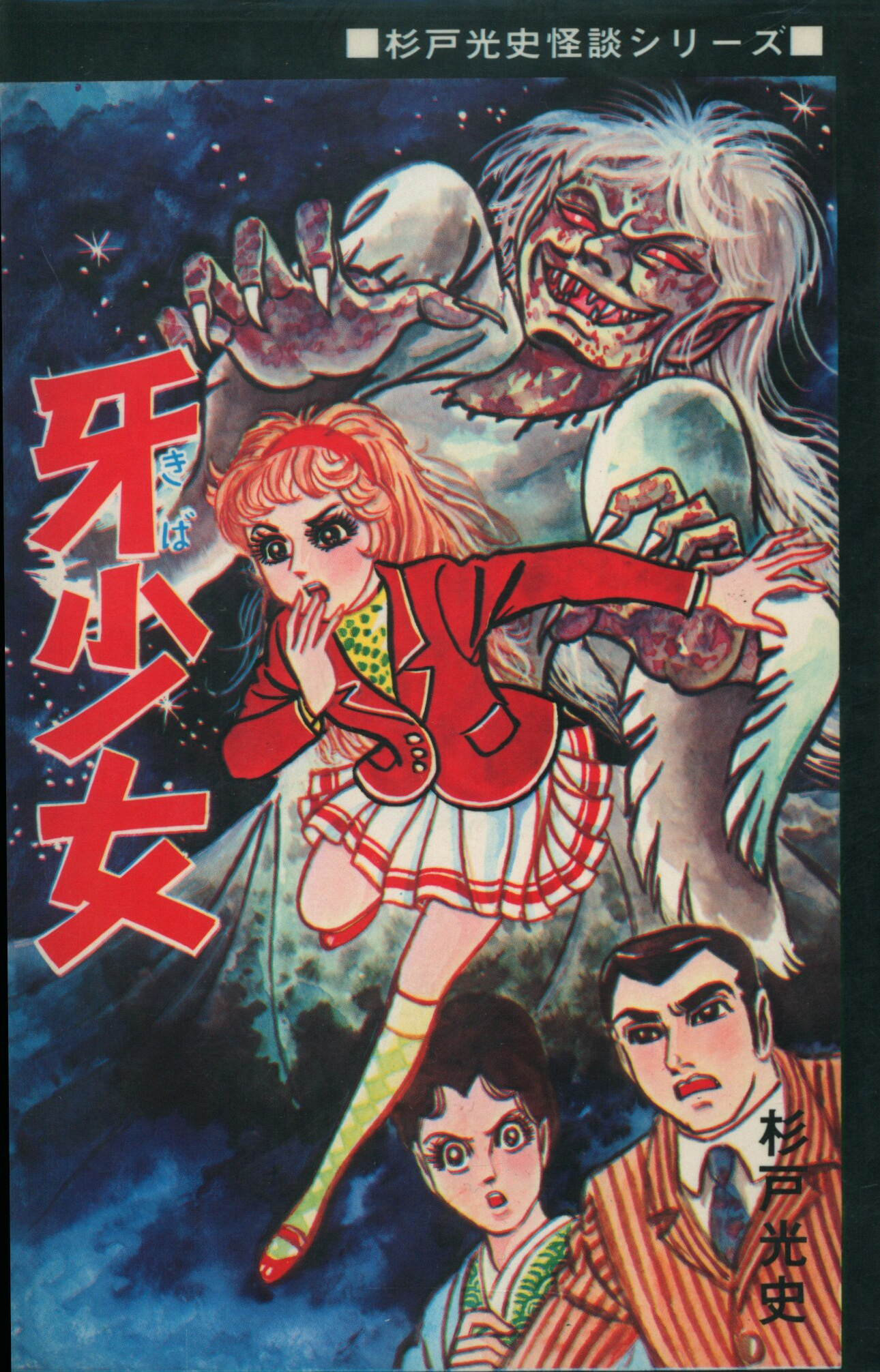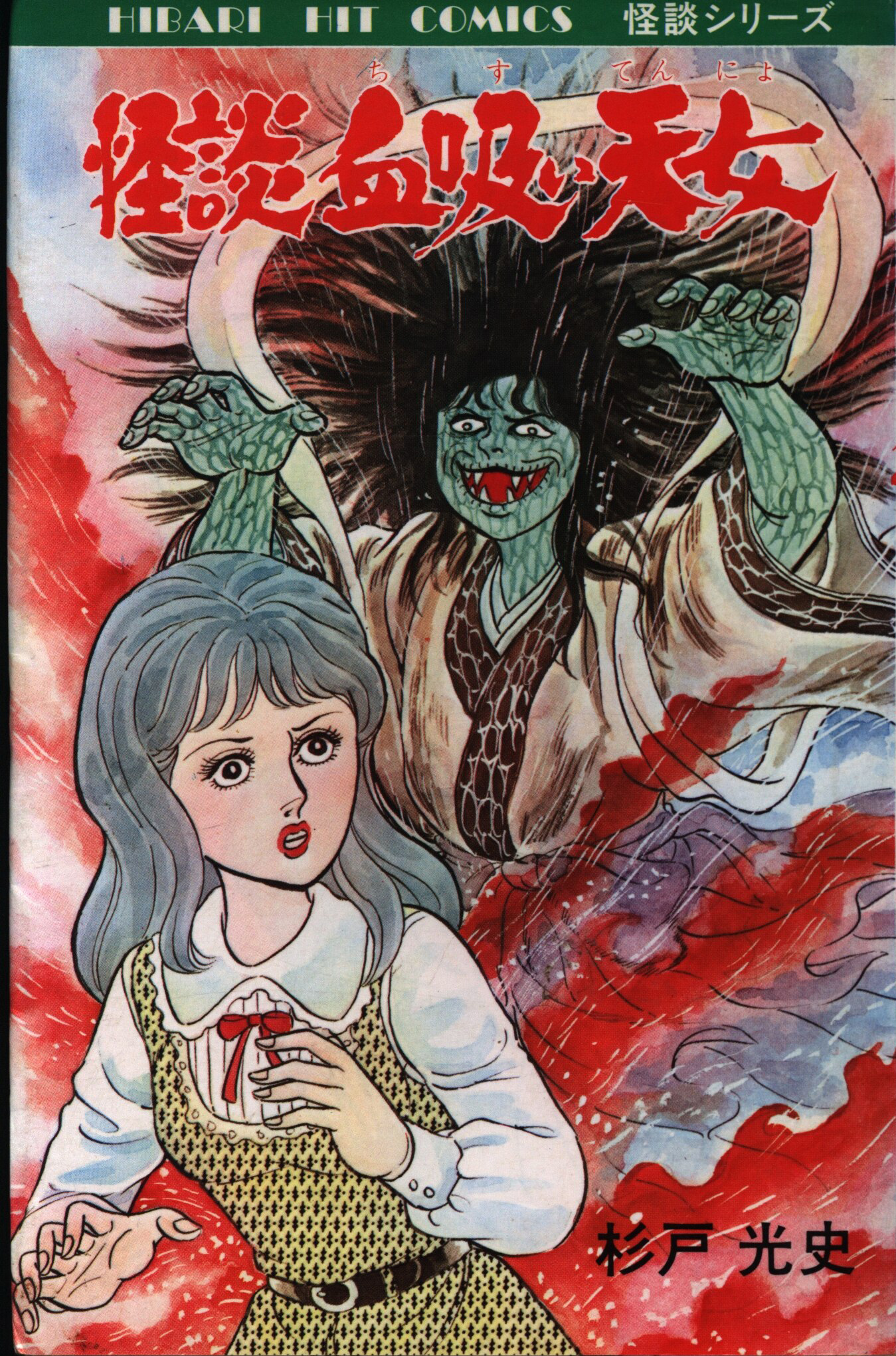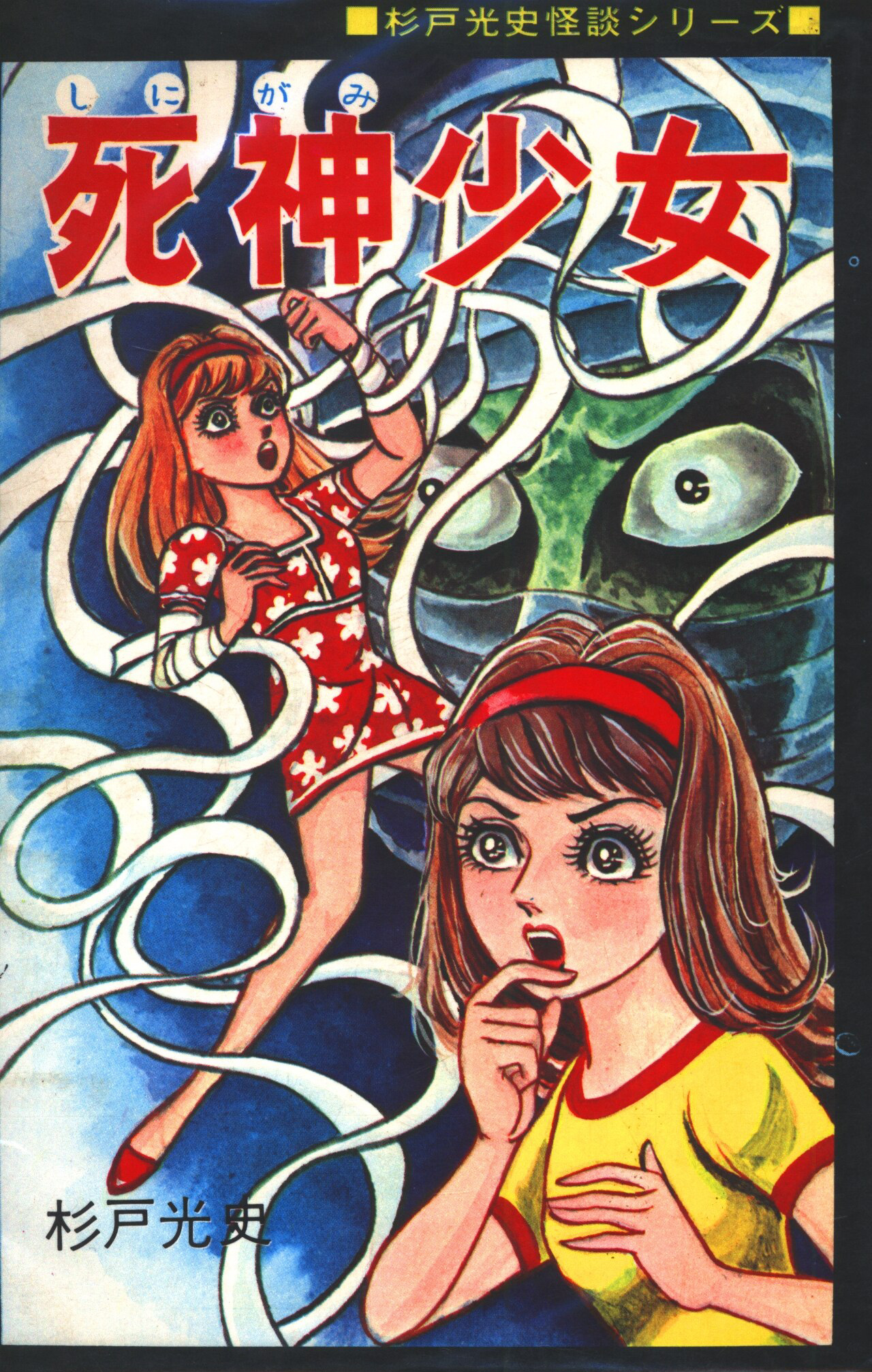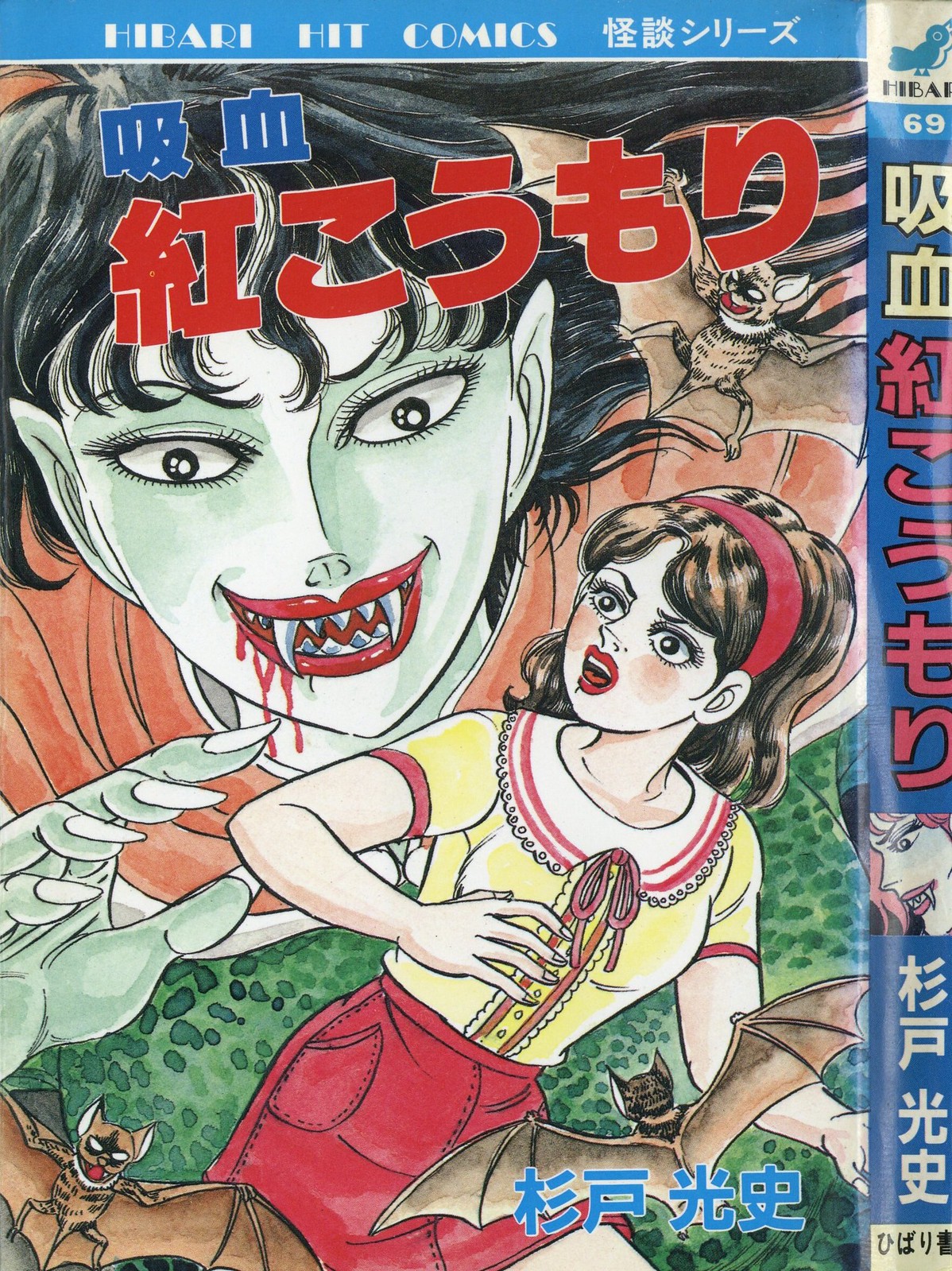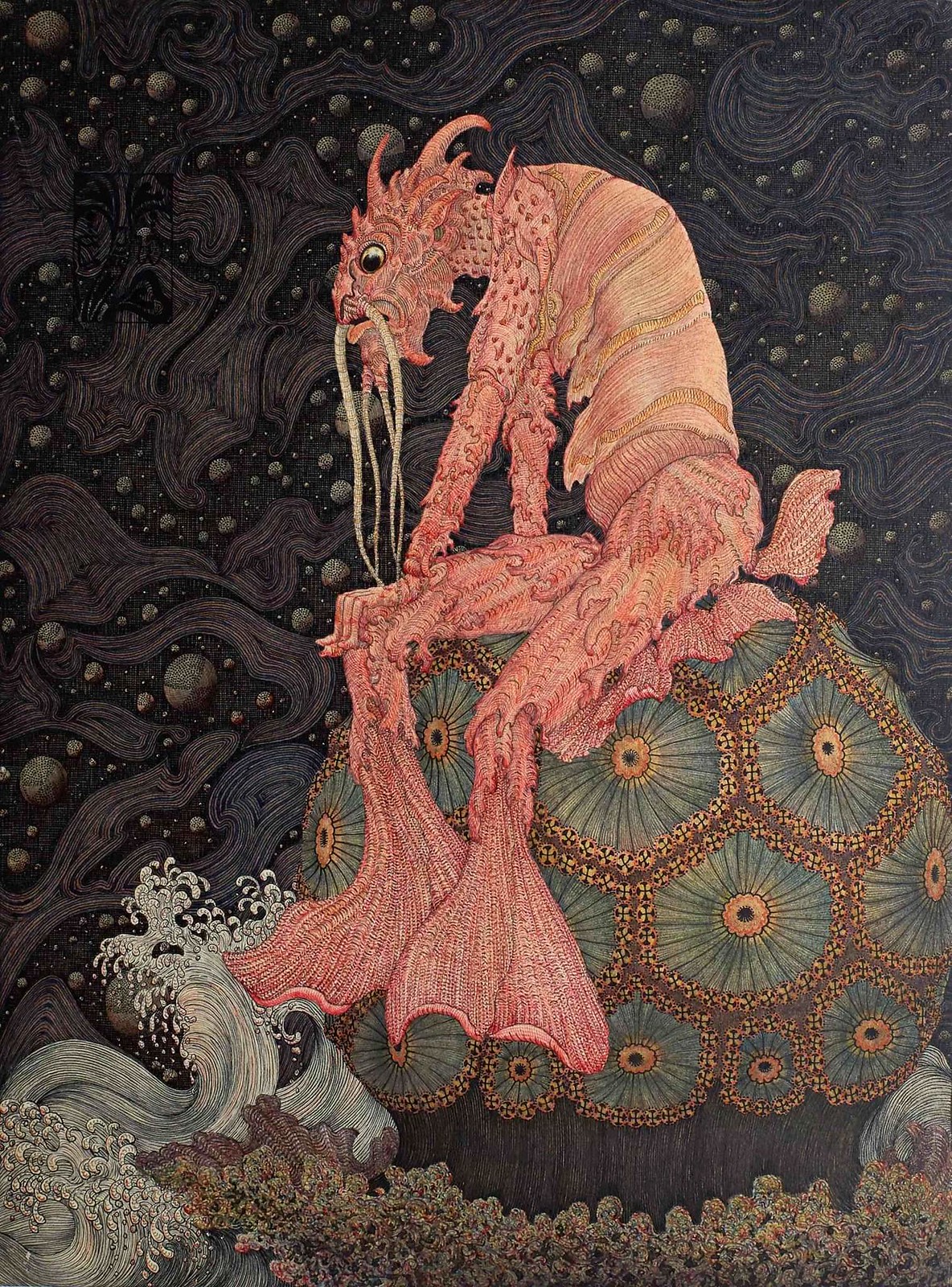Feed aggregator
Kiyoji Kurosu
Kazuo Umezu
2022 Open Houses: July 23
Kazuo Umezu - The Exorcist Comic, 1974
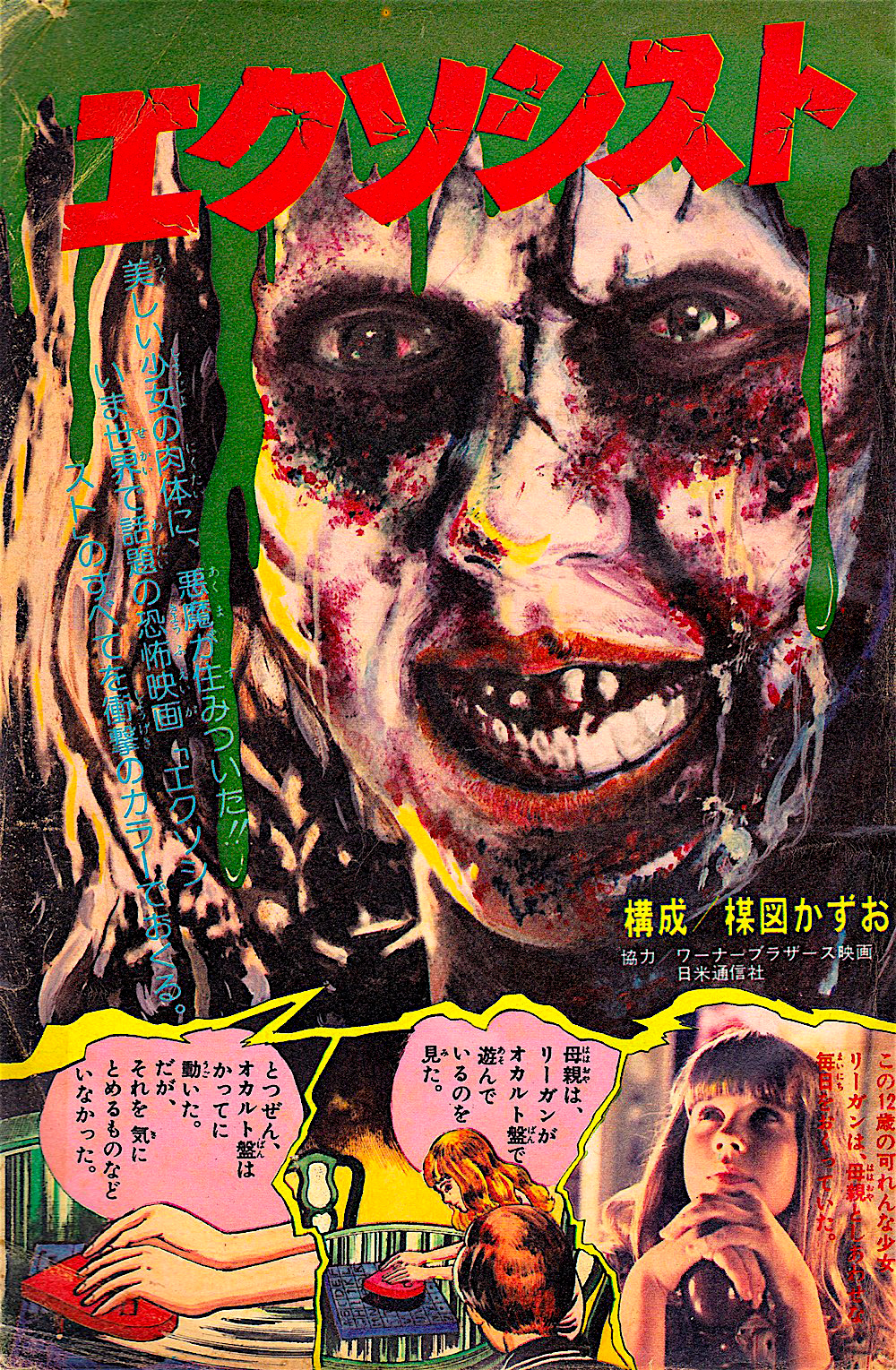

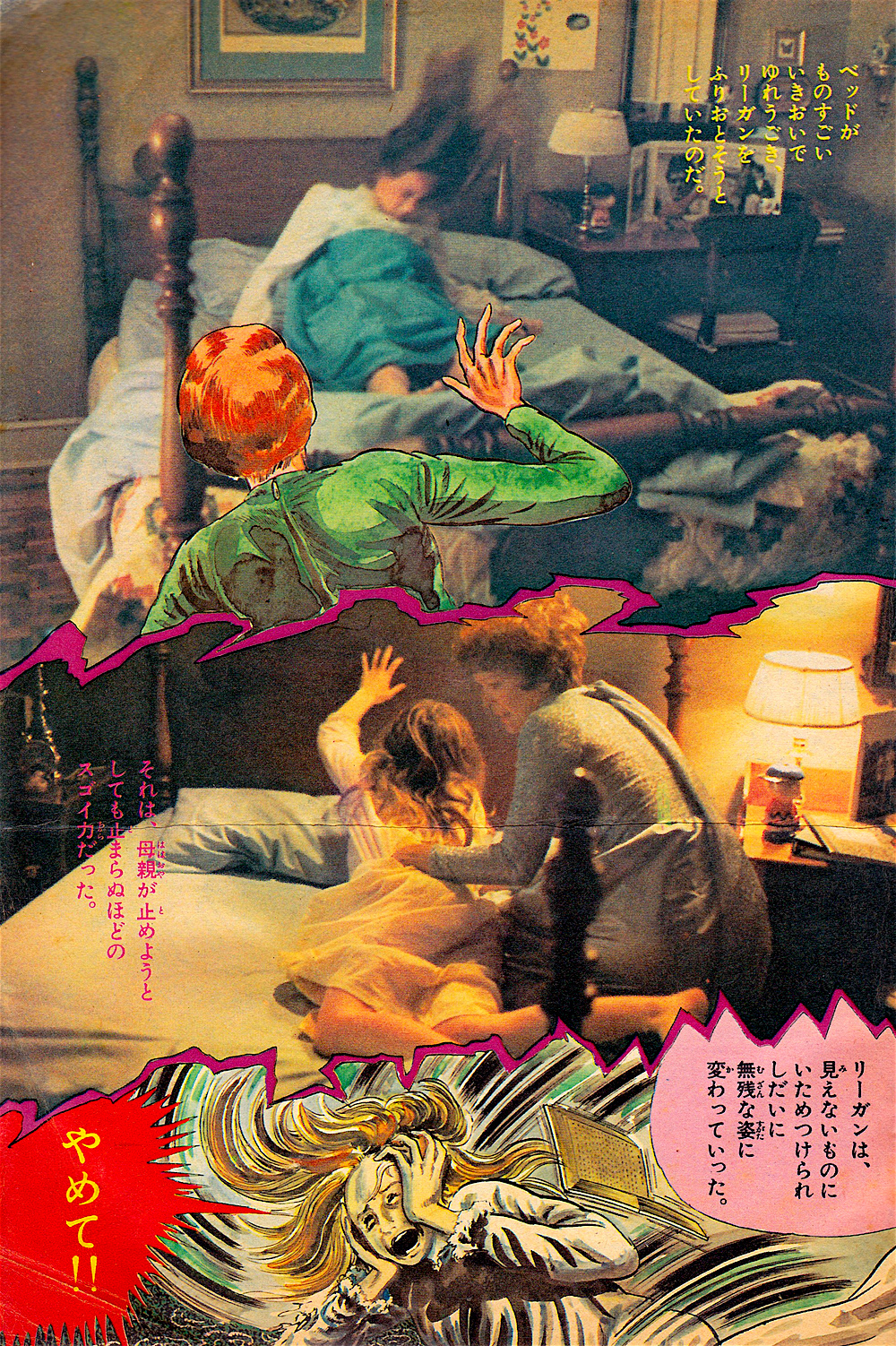




 Originally published in the July 7th, 1974 issue of Shonen Sunday, a week before the film's Japanese release.
Originally published in the July 7th, 1974 issue of Shonen Sunday, a week before the film's Japanese release. Umezu previously posted in 2008.
Module G3 – Hall of the Fire Giant King
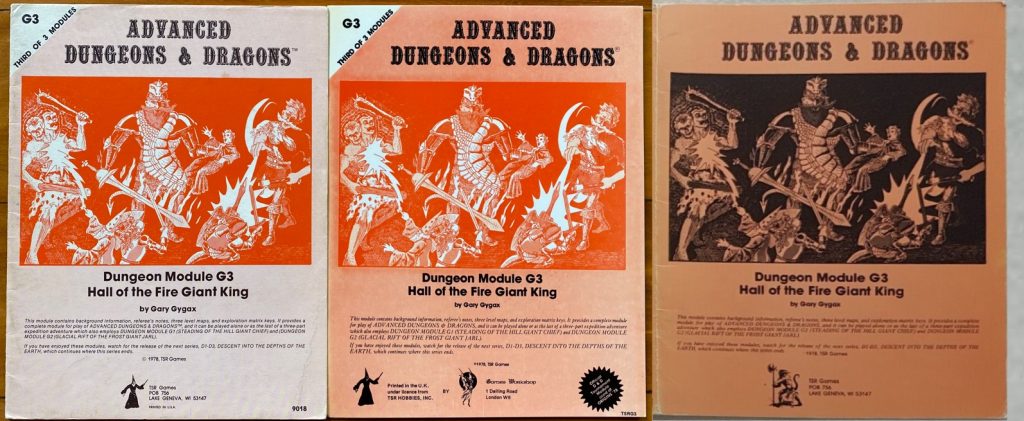 What’s New?
What’s New?
- First 16 page module (G1 & G2 are 8 pages)
- First 3 panel/3 map cover (although the Australian version doesn’t have a 3rd panel)
- First to have a new monster description at the end of the module
- Drow!
- Mind flayers!!
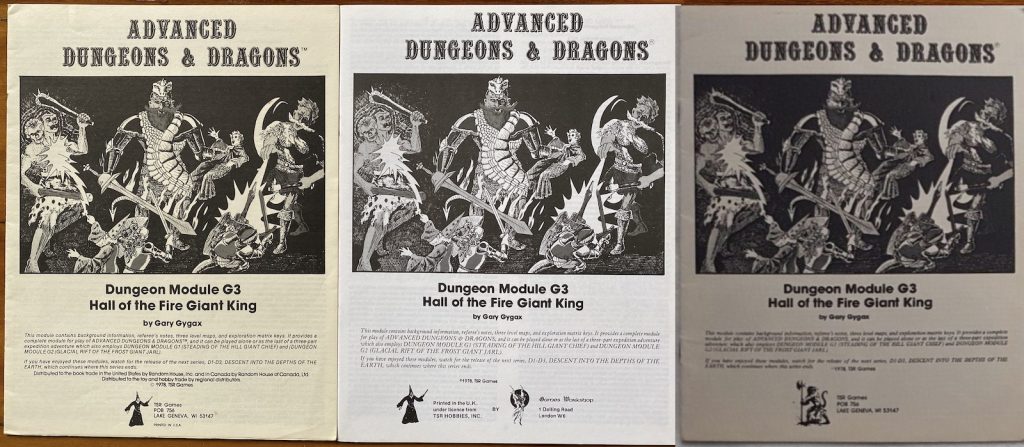 Art
Art
- Back to DCS III for the cover. I like how the armour of the middle fire giant (I assume King Snurre) puts me in mind of a fire salamander
- The backs of G1 and G2 showed aerial shots of the top levels of their maps. That’s not really possible with this one because the dungeon is in a hill. So instead we get a picture of the front doors. Though the proportions don’t really make sense because the two dudes are, I suppose, meant to represent your party (arriving on hippogriffs from G2) and the doors are human size instead of giant size. Anyway, cool picture by Trampier.
- Otherwise, there seems to be less art in this, but I think that’s because it’s 16 pages, many of which are just walls of text. There are some nicely appropriate ones, like the hell hounds and the evil priest. I count 7 art pieces, about half by DCS III and half by Tramp.
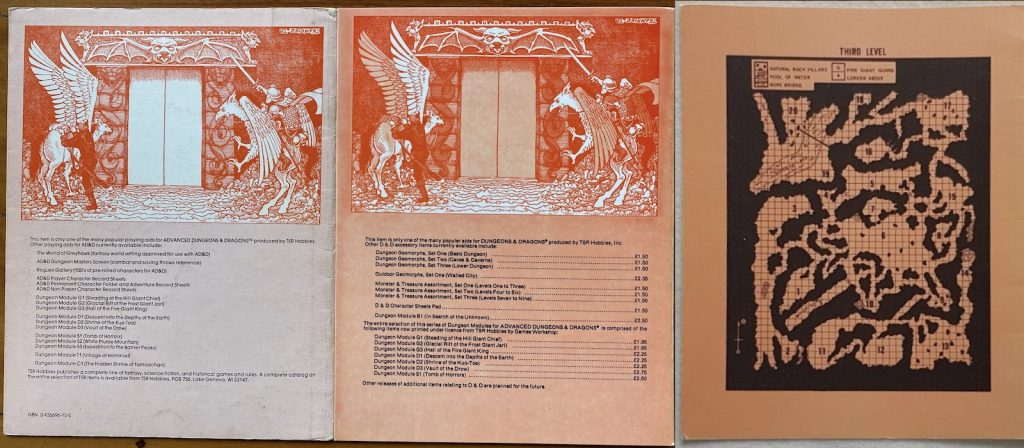 General
General
- The Notes for the DM are a bit more extensive this time. There’s even a nice bit where Gygax describes some of what happened to the play-testing group and how he handled it
- Note: spoilers from here
- It’s interesting that the titular Fire Giant King Snurre is basically in the first room – area 3. So what’s in the rest of the module?!?
- An interesting note for the headsman in the torture chamber – if he hits with a natural 20, he may sever an arm, leg or head – this goes against the general idea that hit points in D&D are an abstract thing. It makes sense, seeing as he’s a headsman but still, it’s a bit tricky to then have to play a character with only one leg or one arm!
- What’s in the rest of the module? Wait a second – what the heck is this way-creepy temple on level 2? Don’t go touching that altar boys and girls! And who are these weird drow?
- If you thought the treasure was good in G2, wait till you find the red dragon here and behold its treasure hoard – it’s immense!
- Level 3 – lots of drow
- Mind flayers!
- Like G2, again, it’s very hacky slashy – there’s very little description about what any of the drow are doing – it’s a case of: here’s a room – it’s filled with x number of drow with these stats and equipment – and that’s it. Occasionally you get a name and a little bit of motive.
- The monster description of the Drow is interesting – giving history and hints at more discoveries to come
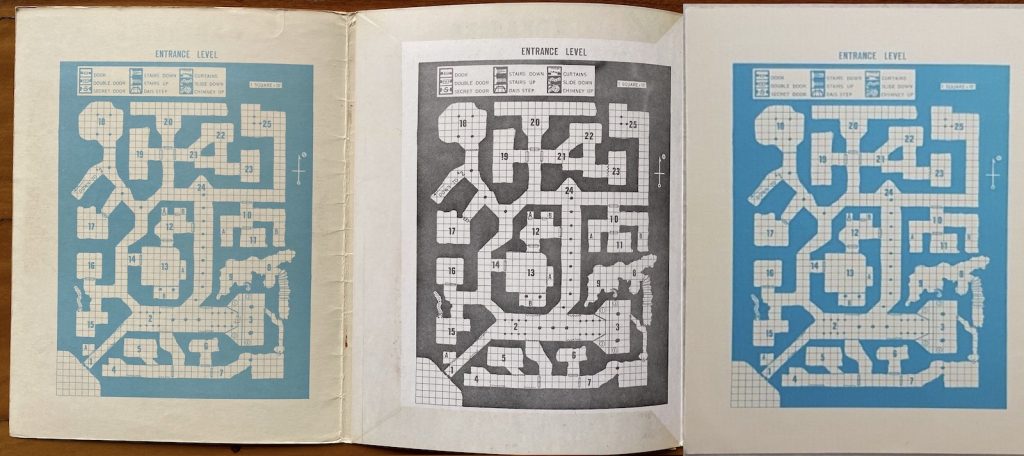 Image Information
Image Information
- From left to right in all pictures, US 4th print, UK print, Australian print.
- See info on the G1 page
Jonstown Jottings #65: GLORANTHA: Rivers of Blood
Much like the Miskatonic Repository for Call of Cthulhu, Seventh Edition, the Jonstown Compendium is a curated platform for user-made content, but for material set in Greg Stafford’s mythic universe of Glorantha. It enables creators to sell their own original content for RuneQuest: Roleplaying in Glorantha, 13th Age Glorantha, and HeroQuest Glorantha (Questworlds). This can include original scenarios, background material, cults, mythology, details of NPCs and monsters, and so on, but none of this content should be considered to be ‘canon’, but rather fall under ‘Your Glorantha Will Vary’. This means that there is still scope for the authors to create interesting and useful content that others can bring to their Glorantha-set campaigns.
—oOo— What is it?
What is it?GLORANTHA: Rivers of Blood is a scenario for use with RuneQuest: Roleplaying in Glorantha.
It is a five page, full colour, 1.65 MB PDF.
The layout is clean and tidy. It is art free, but the cartography is decent.
Where is it set?
GLORANTHA: Rivers of Blood is set in the central hills of the Grazelands.
Player Characters of all types could play this scenario, but any Chaos-hating character or character capable of fighting Chaos will be useful.
What do you need?
GLORANTHA: Rivers of Blood requires RuneQuest: Roleplaying in Glorantha and the Glorantha Bestiary.
What do you get?GLORANTHA: Rivers of Blood details an ancient Mostali cave where a Quicksilver dwarf has his alchemical laboratory. Madness and failure to restore the World Machine have led him to incorporate Lunar Chaos magic in his research and he has begun the source of a river in his cave. The Player Character, either members of the clan who live along the river or connected to the clan which does, are sent up river to determine why it has turned blood red and begun to kill cattle belonging to the clan.
The Game Master is provided with a short encounter table and details of the cave, plus stats for the Quicksilver Mostali. The cave complex consists of five rooms or caves, worked or unworked. The description of the cave along with its map takes up one page. The map is based a free-to-use map by Dyson Logos. (The blog is worth visiting as Dyson Logos provides a more interesting description of the cave than the author of GLORANTHA: Rivers of Blood does.)
The biggest problem with GLORANTHA: Rivers of Blood—outside of the fact that it is neither interesting nor good—is how the Player Characters get across a three-foot deep pool of contact poison. No advice or suggestions are offered to that end.
GLORANTHA: Rivers of Blood is at best a quick, mini-fixer-upper that a Game Master might be able to develop into something else. Probably not purchasing now that the scenario’s decidedly limp plot has been given away. It could be used as a quick combat encounter if the Game Master has absolutely nothing else planned. Otherwise it is nothing more than an uninspiring dungeon bash.
It is supposedly set in the Grazelands, but the scenario could be set almost anywhere else here there is a river. The fact that GLORANTHA: Rivers of Blood is said to be set in the Grazelands is irrelevant.
Cows with Chaos features is an amusing notion and utterly worth stealing from this review rather than the scenario being reviewed.
Is it worth your time?Yes—GLORANTHA: Rivers of Blood is the perfect showcase of how to write an uninspiring combat scenario for RuneQuest: Roleplaying in Glorantha.No—GLORANTHA: Rivers of Blood is a self-contained dungeon bash which the author kindly leaves all of the detail, stats, and flavour to the Game Master to develop herself. Cheap, cheerless, characterless, and charmless of which the author is highly skilled at churning out.Maybe—GLORANTHA: Rivers of Blood is a perfect showcase of how to write an uninteresting dungeon bash for RuneQuest: Roleplaying in Glorantha, so if the Game Master wanted to know how not to do it, she should start here.
1982: Shadows of Yog-Sothoth
1974 is an important year for the gaming hobby. It is the year that Dungeons & Dragons was introduced, the original RPG from which all other RPGs would ultimately be derived and the original RPG from which so many computer games would draw for their inspiration. It is fitting that the current owner of the game, Wizards of the Coast, released the new version, Dungeons & Dragons, Fifth Edition, in the year of the game’s fortieth anniversary. To celebrate this, Reviews from R’lyeh will be running a series of reviews from the hobby’s anniversary years, thus there will be reviews from 1974, from 1984, from 1994, and from 2004—the thirtieth, twentieth, and tenth anniversaries of the titles. These will be retrospectives, in each case an opportunity to re-appraise interesting titles and true classics decades on from the year of their original release.
—oOo— In 1981, Call of Cthulhu would revolutionise the roleplaying hobby, introducing the works of the Lovecraft, if not to the industry, then to the wider hobby; creating horror as a genre; making Player Characters or Investigators mortal and fragile; introducing the concept of Sanity and suffering mental damage; and more. The first supplement for Call of Cthulhu, published the following year, was just as revolutionary. Shadows of Yog-Sothoth: A Global Campaign to Save Mankind was the first campaign for Lovecraftian investigative roleplaying. It introduced the concept of the onionskin campaign. This has the investigators stripping away layers of information like the skin of an onion as the players progress through the campaign, revealing more of the evil cult’s plans and coming closer to the heart of the adventure. There had been campaigns before, such as G1 Steading of the Hill Giant Chief, G2 Glacial Rift of the Frost Giant Jarl, G3 Hall of the Fire Giant King, D1 Descent into the Depths of the Earth, D3 Vault of the Drow, and Q1 Queen of the Demonweb Pits for Advanced Dungeons & Dragons, First Edition, which were connected and could be run as a campaign. However, each part was available separately and could readily be run independent of the others, whereas each and every chapter of Shadows of Yog-Sothoth was integral to the plot and thus awkward to dismantle and run on their own. It was the first campaign to be set in a historical period and the first campaign to be set in a modern historical period and the first campaign to take its Player Characters around the world. In this way, Shadows of Yog-Sothoth set the blueprint for many the Call of Cthulhu campaigns we have had since, many of which would go on to improve upon the format, but Shadows of Yog-Sothoth was there first.
In 1981, Call of Cthulhu would revolutionise the roleplaying hobby, introducing the works of the Lovecraft, if not to the industry, then to the wider hobby; creating horror as a genre; making Player Characters or Investigators mortal and fragile; introducing the concept of Sanity and suffering mental damage; and more. The first supplement for Call of Cthulhu, published the following year, was just as revolutionary. Shadows of Yog-Sothoth: A Global Campaign to Save Mankind was the first campaign for Lovecraftian investigative roleplaying. It introduced the concept of the onionskin campaign. This has the investigators stripping away layers of information like the skin of an onion as the players progress through the campaign, revealing more of the evil cult’s plans and coming closer to the heart of the adventure. There had been campaigns before, such as G1 Steading of the Hill Giant Chief, G2 Glacial Rift of the Frost Giant Jarl, G3 Hall of the Fire Giant King, D1 Descent into the Depths of the Earth, D3 Vault of the Drow, and Q1 Queen of the Demonweb Pits for Advanced Dungeons & Dragons, First Edition, which were connected and could be run as a campaign. However, each part was available separately and could readily be run independent of the others, whereas each and every chapter of Shadows of Yog-Sothoth was integral to the plot and thus awkward to dismantle and run on their own. It was the first campaign to be set in a historical period and the first campaign to be set in a modern historical period and the first campaign to take its Player Characters around the world. In this way, Shadows of Yog-Sothoth set the blueprint for many the Call of Cthulhu campaigns we have had since, many of which would go on to improve upon the format, but Shadows of Yog-Sothoth was there first.Shadows of Yog-Sothoth: A Global Campaign to Save Mankind also introduced the first cult to Call of Cthulhu, the Lords of the Silver Twilight, whose members range from centuries old wizards to the undead. It is their aim to force the rise of the sunken city of R’lyeh under the Pacific where Dread Cthulhu has slumbered for aeons and so unleash the Great Old One upon the world and bring about the end of mankind’s dominion over the Earth. The stars though, are not yet right to bring about such a calamitous event and there is a chance that the Lords of the Silver Twilight will fail. When they discover the plans of the Lords of the Silver Twilight have for humanity and the Earth, a group of stalwart Investigators set out to thwart them, an effort which takes them to Boston to New York, then Scotland, California, Maine, and finally Easter Island and the South Pacific. In the process, they will discover dread histories and the darkest of secrets, place both their minds and their bodies in harm’s way again and again, learn things that man was always best not knowing, and ultimately, confront an alien being beyond their comprehension.
Shadows of Yog-Sothoth opens in Boston in 1928. In ‘The Hermetic Order of the Silver Twilight’, the Investigators are invited to join the eponymous and rich, well-to-do, misogynistic fraternity with a reputation for charitable works, not unlike the Freemasons. The order has several ranks though which the Investigators will quickly progress to the point when its reveals to them that in truth, its inner circle is dedicated to worshipping an unearthly god and is awaiting the time when the stars come right, and alien species can reclaim what once was theirs. The location and rituals for The Hermetic Order of the Silver Twilight are all sketched out in some detail and once they are initiated into the upper ranks, there is the constant nagging question of, “When is knowing too much just too much?” Yet as the Investigators are promoted through the ranks and exposed to unspeakable things and expected to commit increasingly despicable acts, they have the chance to learn both what the order knows and what its aims are. This includes sneaking into some of the more secret areas where they will find horrors indeed.
‘The Hermetic Order of the Silver Twilight’, the first chapter of the campaign, is detailed and rife with roleplaying possibilities combined with skulduggery and stealth. As written though it does not support that with any ease, there being no other members described other than the cultists and their acolytes, and similarly there is no real reason for the Investigators to join The Hermetic Order of the Silver Twilight except as a means to begin the plot. This despite the fact that Shadows of Yog-Sothoth is intended for fairly experienced Investigators. Shadows of Yog-Sothoth, Second Edition, published in 2004, addressed some of these issues, but not all. It is easy to be underwhelmed by ‘The Hermetic Order of the Silver Twilight’, but set-up and the plot definitely has possibilities. They just await the hand of a good Keeper to really fillet them out.
After the Investigators have learned all that they dare and fled the headquarters of The Hermetic Order of the Silver Twilight, they receive the first of several letters which will alert them to strange events around the world. This is a device that the campaign will use again and again, typically letters which draw their attention to something which turns out to be connected to the main plot, but does not look like it first. This is one of the major complaints about the campaign, that the use of letters as a narrative device is clumsy and clichéd. In hindsight this is undeniably true, but at the time of publication this was not the case.
The second scenario, ‘Look to the Future’, is a radical departure from the rest of the campaign, a piece of weird Science Fiction which takes the Investigators to New York where they will infiltrate an odd self-help and self-actualisation organisation. The Investigators are easily able to attend a meeting which is held in an oddly bare bunker-like building. In return for ready donations of money and unaware donations of Power—at this point in Call of Cthulhu’s rules, magic is fuelled by raw Power rather than Magic Points—at regular ceremonies, attendees are rewarded with small items of advanced technology, such as disposable lighters, digital watches, and non-stick frying pans. In addition, there is strange technology in the basement if the Investigators can gain access. Meddle too much and there is the possibility that one or more of their number will be killed, to the point that there is the possibility of all of them being killed. Even if they do not, they should find further links to the activities of the Hermetic Order of the Silver Twilight and its masters, but the scenario leaves a lot for the Keeper to develop if the Investigators want to explore beyond the walls of Look to the Future’s bunker. Curiously, this scenario involves Nyarlathotep, here indicating for the first time the involvement of the Crawling Chaos in the numerous machinations of those involved in the Mythos and other scenarios and campaigns for Call of Cthulhu. This is despite the fact that the campaign is called Shadows of Yog-Sothoth and famously Yog-Sothoth appears nowhere in the campaign.
More letters direct the Investigators to Scotland to check upon one Henry Hancock, renowned big game hunter and local amateur archaeologist. ‘The Coven of Cannich’ is a sprawling sandbox populated by numerous masters and mistresses of the Mythos as factions from the Lords of the Silver Twilight search for parts of an artefact believed to be buried in an ancient temple on the shores of Loch Mullardoch. These are not the only Mythos forces in the area, and there seems to be a medley of them, most far too powerful for the Investigators to face. The scenario is very much one of who the Investigators can trust from among the NPCs, and the difficulty is that because there are some twenty of them, the Keeper just has too many to handle and make them stand out from each other. There is potential to camp this up a bit a la Hammer Horror, what with the screeching ghost and the accents of the locals, but ‘The Coven of Cannich’ is a difficult scenario to run and prepare, and there is little in the way of advice for the Keeper.
Back in the U.S.A., the Investigators are hired by a Hollywood movie mogul to investigate a supposedly ‘haunted’ film set out in the Mojave Desert after the film was shut down, the director committed suicide, and the lead actor, all but a vagrant. Again, as a scenario, ‘Devil’s Canyon’, feels unconnected to the campaign as a whole, but again the Investigators will find what also seem like coincidental links. Yet there is some fun investigation to conduct in Hollywood before the Investigators set out the eponymously named Devil’s Canyon. There they find the ruined set of what would have been an epic film. After the bucolic highlands of Scotland and the city streets of Boston and New York, there is a sense of space, sunlit and dry, in this scenario’s desert setting, but even with that feeling of openness the Investigators quickly find themselves trapped and stalked by invisible things. Their invisibility is balanced by their cowardice and if they can harness the technology available, the Investigators might be able to reveal what they are. Where the Mythos and the monsters are overdone in the other scenarios, here they are restrained and creepy, and the scenario really benefits from that. However, the scenario does not add much to the overall campaign, and it comes across as a diversion rather than essential to the plot.
The campaign then takes a turn for the worse for the Investigators in ‘The Worm that Walks’. They are offered further clues, even patronage and respite, by one Christopher Edwin, but in following them up, they face increasingly nasty dangers—a family of cannibalistic backwoodsmen, an attack by a shoggoth whilst they are aboard their new patron’s yacht, and then when one of them is poisoned, stalked by something in the hospital. By the time it gets to that point, the likelihood is that the Investigators do not trust him—even if they ever did given the typical player sense of paranoia—and they have every reason not to. Edwin is out to kill them as part of the Lords of the Silver Twilight’s revenge upon the Investigators, and whilst that is understandable, to come at a point so late in the campaign when there is the possibility again of all the Investigators being killed, in what is already a campaign a deadly campaign designed for experienced Investigators, is well, overkill.
Penultimately, the campaign switches from reactive mode to proactive mode as it nears its climax. Up until now the Investigators have been reacting to letters received, but now they have the chance to begin moving against the cult, in ‘The Watchers of Easter Island’ and then in ‘Rise of R’lyeh’, the last two parts of the campaign. In the first, ‘The Watchers of Easter Island’, they travel to Easter Island, which during the period when Shadows of Yog-Sothoth is set, is a colony of Chile and under military rule. If the Investigators can make contact with the indigenous islanders and the survivors of an archaeological team, all of whom have suffered attacks and disappearances. There is something strange going on and the island is under martial law, the local commandant curious as to the reason for the Investigators’ visit and wanting to be kept aware of their activities. The indigenous islanders will guide the Investigators to a local, elderly priest who can advise and suggest the cause, and even equip them to fight the fearsome figure responsible for the disappearances. Getting to both priest and threat is physically gruelling and the end confrontation is challenging. ‘The Watchers of Easter Island’ does feel superfluous to the campaign itself. If they fail, the Investigators will be attacked on their voyage to R’lyeh at the beginning of the next chapter, but otherwise, the Investigators’ success or failure in preventing the final preparations being conducted by a Lord of the Silver Twilight have little effect on the campaign’s climax.
At last, in ‘The Rise of R’lyeh’, the efforts of the Lords of the Silver Twilight and their acolytes come to fruition and the island of R’lyeh rises out of the south Pacific, and they attempt to call Dread Cthulhu from his slumber. By this time, the Investigators should be armed with the artefacts they found during their investigations in the previous scenarios, and have the means to reverse the ritual that the Lords of the Silver Twilight want to perform, and so sink the island. It is a very short scenario, but a fitting one, as the Investigators race across the island to find a non-Euclidean vantage point from which to perform their reverse ritual. There is that moment of course, when they will have to witness Great Cthulhu easing himself out of his tomb and wading through the flotilla of boats carrying his worshippers, a moment worthy of legend that will tear at the Investigators’ sanity, after which the survivors must flee back across the island to their boat, and hopefully get away in safety. As momentous as this actually is, it does feel as if the Investigators are doing everything from the wings of the stage and so slightly anti-climactic.
In addition, Shadows of Yog-Sothoth includes two extra scenarios. The first, ‘People of the Monolith’ is based on the short story, ‘The Black Stone’ by Robert E. Howard and reads more like a short story than a scenario. The Investigators are hired by a publisher to travel to Hungary to look into the circumstances behind a piece of poetry and the poet’s subsequent suicide. The scenario is short and very little actually happens, although it is not without its strangeness. Written as a beginning scenario, it is suited to less action-orientated Investigators, and it works with fewer Investigators rather than more.
The second scenario is ‘The Warren’. This takes place in Boston and focuses upon the Boucher estate, long abandoned and now purchased for demolition and redevelopment. When the demolition expert goes missing the Investigators are hired to look into what has happened at the estate. What they discover inside the house is that the Boucher family never died out, but rather degenerated and became inbred, worshipping the Great Old Ones. Despite there being a decent bit of research to do beforehand, ‘The Warren’ all too soon descends into a location-based, dungeon style adventure. Nowhere near as bad as scenarios which would appear in the pages of the anthologies, The Asylum & Other Tales and Curse of the Chthonians: Four Odysseys Into Deadly Intrigue, but not something that would be done today or indeed since they were published. Despite the investigative efforts made before exploring the Boucher estate, the Investigators are unlikely to full prepared for the true threat at the heart of the scenario and the choice of the Great Old One feels ill-suited to the role here just as much as this type of scenario, whilst Lovecraftian, feels ill-suited to Lovecraftian investigative roleplaying.
Physically, Shadows of Yog-Sothoth is well presented and actually decently written for a campaign published in 1982. The organisation of the material leaves a lot to be desired and a lot for the potential Keeper to work through and prepare. The cover is a glorious depiction of R’lyeh and the pen and ink illustrations, all by Tom Sullivan, are all suitably dark and oppressive, and the maps have a certain charm. By the modern standards, the handouts are plain, but they are serviceable.
—oOo—
Following its publication in 1982, Shadows of Yog-Sothoth was reviewed in Space Gamer Number 60 (February 1983) in the ‘Capsule Reviews’ section by William A. Barton, the designer of Cthulhu by Gaslight. He identified that several of the scenarios are “almost too deadly”, but concluded that, “Overall, though, SHADOWS OF YOG-SOTHOTH should provide some exciting CoC play for even the most experienced investigators (despite the odd fact that Yog-Sothoth never makes an appearance, title or not), and I recommend it to all Lovecraftians.”
Shadows of Yog-Sothoth was reviewed not once, but twice in Dragon magazine. First, in Dragon #81 (Vol. VIII, No. 7, January 1984) in ‘Gaming without heroes: Horror role-playing gets its vigor from victims’ by Ken Rolston. From the start he highlighted issues with the campaign: “In design, each of the seven linked scenarios is a mystery, complete with clues, NPCs, and settings. However, for smooth presentation, considerable study and preparation by the GM will be necessary. The scenarios lack strict linear narratives. Though this avoids arbitrary limits on player freedom, it forces the GM to structure the adventures in response to the actions of the players — a difficult job even for experienced gamemasters. The-tactics of the antagonists are not adequately detailed, and will need to be improvised or planned ahead.” Ultimately, he was far more positive in his conclusion, saying that, “Yog-Sothoth requires much labor and study on the part of the GM; it is not usable after a single reading. The GM will have to provide most of the narrative structure for the campaign, since the players have much freedom to choose their own approach to solving problems. The writing and editing are generally superior. Player materials are provided in ample quantity and the text is adequately organized for GM reference. The adventures are unusual and the atmosphere exotic and terrifying. Yog-Sothoth is a classic example of role-playing horror, with awesome monsters, desperate victims, and an atmosphere of mystery and menace. Since it provides enough material for a campaign of several months’ duration, it is an excellent value for the $10 purchase.”
The campaign was then reviewed six years later in Dragon #81 (Vol. XV, No. 1, June 1990) in ‘Role-playing Reviews: A losing war against the forces of darkness’ by Jim Bambra. This was as part of the Cthulhu Classics anthology, which reprinted Shadows of Yog-Sothoth along with ‘The Warren’, but not ‘People of the Monolith’, alongside ‘The Pits of Bendal-Dolum’ and ‘The Temple of the Moon’ from Terror from the Stars; ‘Dark Carnival’ from Curse of the Chthonians; and ‘The Secret of Castrenegro’ from Cthulhu Companion. Bambra was positive in his summation, stating, “The horror elements are well presented, and the adventures span a wide variety of locations and investigative approaches. Opportunities for role-playing, investigation, and combat abound with nameless horrors and the depraved cultists who worship the creatures of darkness.”
Ian Bailey reviewed Shadows of Yog-Sothoth in ‘Open Box’ in White Dwarf #44 (August, 1983). Before awarding it ten out of ten, he said, “All in all the Shadows of Yog-Sothoth is an excellent and masterly campaign that demands a high standard of play throughout. It is well presented (one feature is five pages of player-information which can be photocopied or pulled out to save the Keeper time) and carefully managed throughout, and it provides, I believe, the most exciting and satisfying adventure available on the market to date. It might seem expensive but it is worth every penny.”
Anders Swenson reviewed the campaign in ‘Game Reviews’ in Different Worlds Issue 34 (May/June 1984). He highlighted the deadliness of the campaign saying that, “…[M]any of the scenarios would seem to work better with relatively well-equipped adventurers who have gotten access to heavy military weapons…” as well its organisation, complaining that, “Then there is the organization. Each scenario does contain the material needed to run the adventure, but finding it and having it handy is another question. Many of the scenarios have a lot of nonplayer characters, situations, maps, etc., and the tendency of the layout people was to string them together without enough introductory, transitional, and connective next to make everything findable.” As with other reviewers, he ended on a positive note with, “Overall, though, this is an excellent collection of first-rate Call Of Cthulhu scenarios. All keepers (gamemasters) should get Shadows of Yog-Sothoth.”
—oOo—
When it was first published in 1982, Shadows of Yog-Sothoth was like nothing that had come before. It was a whole campaign, consisting of several linked parts, each integral to the whole and the flow of the campaign’s story. It was set in a modern age and it was a first horror campaign, and it pitted the Investigators against H.P. Lovecraft’s signature creature, the Great Old One, Cthulhu himself. That is one thing that no campaign has done since. It is this version that would be reprinted as part of the Call of Cthulhu Classic Kickstarter campaign to celebrate the fortieth anniversary of Call of Cthulhu. It is also this version which would be reprinted as part of Cthulhu Classics in 1989.
Yet for all its scope and grandeur, Shadows of Yog-Sothoth suffers, by modern standards, numerous flaws—and those flaws are well known. They include an underwhelming set-up which challenges the Keeper to involve her players and their Investigators in the campaign. The links between the chapters are flimsy, awkward, and repetitive, and the constant use of the letter as a plot device is wearisome. ‘The Worm that Walks’, the fifth scenario, has a well-deserved reputation as a killer, an intentional method of murdering one Investigator after another at a point in the campaign when their knowledge and experience are needed for the last two scenarios. The campaign also lacks advice for the Keeper and having been written by different hands, it has a rough, incohesive feel.
It is possible that some or all of these issues could have been addressed by the planned development of a longer, more extensive, and greater world-spanning version of the campaign which would have been edited by Scott David Aniolowski. This would have included far more of locations visited in Lovecraft’s ‘The Call of Cthulhu’, the story which directly inspired Shadows of Yog-Sothoth, including Greenland, China, Germany, New Orleans, Kingsport, Saudi Arabia, Irem, San Francisco, and Xoth. Unfortunately, due to time constraints, this expanded version of the campaign was cancelled and Shadows of Yog-Sothoth, Second Edition was published instead. It should be noted that some of content of ‘The Call of Cthulhu’ has been presented for Call of Cthulhu, Seventh Edition in Cults of Cthulhu.
Some of these problems were addressed in Shadows of Yog-Sothoth, Second Edition, published in 2004. They included reasons and motivations for the Investigators to join the Hermetic Order of the Silver Twilight in ‘The Hermetic Order of the Silver Twilight’, as well as NPCs beyond the Cultists which they could interact with. The links between the chapters were listed and made more obvious and some advice was provided for the Keeper, although all too often, not enough. Whether the version from 1982 or 2004, Shadows of Yog-Sothoth cannot fail to show its age and whilst as it should, it presents a huge challenge to the players and their Investigators, it also presents an enormous challenge to the Keeper who wants to run the campaign. There is so much to prepare in the campaign and Shadows of Yog-Sothoth never makes it easy. Certainly, within two years, there would be campaigns from Chaosium, Inc, beginning with The Fungi from Yuggoth and Masks of Nyarlathotep, the latter often regarded as the greatest roleplaying campaign ever published, which made incredible strides in campaign design and presentation. There is no denying that Shadows of Yog-Sothoth needs a rewrite and even a redesign and hopefully its third edition will be the rewrite and the redesign it needs and addresses its issues.
Shadows of Yog-Sothoth: A Global Campaign to Save Mankind broke new ground in so many ways, but it is no masterpiece. It is flawed and often incoherent, and it remains a daunting prospect for any Keeper who sets out to run it for her players. Yet it has many fine moments of horror and creepiness, and above all, it has ambition, and it has a grandeur and it does something no other campaign has done since, which is have the Investigators face Cthulhu himself.
Grim & Perilous Lite
 In the Long Sixteenth Century all that stands between chaos and disorder is the Empire. The Empire is the bastion of law and order, but it is a law for those who can afford it and an order which keeps the citizenry in its place. Chaos comes in the form of all that would disrupt this law and order. Plague wends its way back and forth across the land. Feudalism has been displaced by the rise of the burghers and the wealthy middle class and the role of mercenaries on the battlefield, which have made the role of the knight irrelevant. Religion has become more than a matter of just faith with the schism the church. Adhering to one faith and not the other can get you butchered, letting getting caught up on the battlefield, whether as conscript or mercenary. The poor, the labouring classes, and the craftsmen all look to the Empire for stability and their safety, but yearn for something better knowing they are unlikely ever to truly gain it and so change their lot in life. The Empire wants them kept in their place, their labour making the rich even richer, their taxes filling the crown’s coffers, and their bodies, willing or unwilling, ready to be thrown into the quagmire of war against the enemy which threatens from without… Yet there is no great Chaos. Instead, there are the men and women who stand up and decide that theirs is not a life as dictated by the Empire. They seek lives of adventure and change, wanting to make difference in their lives first, but perhaps the lives of others too. As much as their agency can lead to their being employed by the wealthy, they can become a threat to the natural order. This is the setting for Kriegsmesser, a roleplaying game best described as Troika! meets Warhammer Fantasy Roleplay.
In the Long Sixteenth Century all that stands between chaos and disorder is the Empire. The Empire is the bastion of law and order, but it is a law for those who can afford it and an order which keeps the citizenry in its place. Chaos comes in the form of all that would disrupt this law and order. Plague wends its way back and forth across the land. Feudalism has been displaced by the rise of the burghers and the wealthy middle class and the role of mercenaries on the battlefield, which have made the role of the knight irrelevant. Religion has become more than a matter of just faith with the schism the church. Adhering to one faith and not the other can get you butchered, letting getting caught up on the battlefield, whether as conscript or mercenary. The poor, the labouring classes, and the craftsmen all look to the Empire for stability and their safety, but yearn for something better knowing they are unlikely ever to truly gain it and so change their lot in life. The Empire wants them kept in their place, their labour making the rich even richer, their taxes filling the crown’s coffers, and their bodies, willing or unwilling, ready to be thrown into the quagmire of war against the enemy which threatens from without… Yet there is no great Chaos. Instead, there are the men and women who stand up and decide that theirs is not a life as dictated by the Empire. They seek lives of adventure and change, wanting to make difference in their lives first, but perhaps the lives of others too. As much as their agency can lead to their being employed by the wealthy, they can become a threat to the natural order. This is the setting for Kriegsmesser, a roleplaying game best described as Troika! meets Warhammer Fantasy Roleplay.Kriegsmesser is written and published by Gregor Vuga following a successful Kickstarter campaign as part of ZineQuest #3. It offers a range of character types with a light set of mechanics predicated on degrees of failure, solid advice on running the game, and a very much implied setting. That setting is one akin to Mittel Europe, roughly at the time of the Thirty Years War, so akin to that of the Empire and the Old World of Warhammer Fantasy Roleplay. Although there is no specific setting, where Kriegsmesser differs from the original roleplaying game of ‘grim and perilous adventure’ is that it is humanocentric—there are no rules for playing anything other than Humans, there is no such thing as Corruption or supernatural Chaos, and so no bestiary of supernatural creatures. This is because the Player Characters are the chaos, though if the Game Master wants to include it, there are rules for Corruption which have a corrosive effect upon a Player Character, all too likely driving him into the clutches of Chaos.
A Player Character in Kriegsmesser is defined by a Career, four or five skills and some possessions. He also has ten points of Toughness and six points of Luck. To create a character, a player rolls ‘d66’ and notes the details of the character down. He then chooses a name. The options include the Street Rat, the Starving Artist, the Labourer, the Charlatan, the Revolting Peasant, the Vermin Snatcher, the Clueless Noble, and more. Each one of the Careers given in Kriegsmesser is accompanied by a short, but engaging piece of flavour text.
Helena Perun
Career: Slayer
Skills: Read Signs (Demonic) 3, Notice 3, Fight (Monsters) 2, Gossip 1, Track 1
Toughness: 10
Luck: 6
Possessions: Kickass Hat, Holy Water, Silver Knife
Mechanically, Kriegsmesser uses its own dice pool mechanics rather than those of Troika! Whenever a player wants his character to do something and the character has the relevant skill, he rolls a number of six-sided dice equal to the skill and looks for the highest result. If the highest result is a six, then the character succeeds without incurring any trouble. If the result is a five or four, then the character succeeds, but incurs some trouble. A roll of three or less is a failure. What form the trouble takes when a player rolls a four or five, can be anything from a weaker or partial result to bowing out gracefully or a complication. The Game Master is encouraged to present the player with a couple of options and essentially bargain with him as the possible trouble his character suffers. If a character does not have an appropriate skill, then his player can spend points of Luck to have dice to make the skill test. Luck can be recovered through rest, through prayer, or through some festive or merrymaking activities. Luck then forms an important resource and something that a player needs to expand with a care. Of course, every roll in Kriegsmesser should be important, but when or where, Luck is even more important.
Combat in Kriegsmesser is intended to be nasty and brutal, favouring characters—Player Characters and NPCs—who are combat trained. Otherwise, a Player Character has to rely upon his Luck and an NPC, a single die. Often, it is enough to draw a sword to persuade an NPC or possibly a Player Character to back down in the face of potential violence. Kriegsmesser does give more optional rules if the Game Master and her players want a less narrative influenced combat system. These cover initiative, armour (which reduces damage), various weapon types (from warhammer to pistol), mighty blows (bonuses to the base damage if sixes are rolled in an attack), and vantage (having a higher vantage grants a bonus die). Once a Player Character loses all of his Toughness, the next blow will probably kill him, but another option allows for Terrible Injuries, like losing multiple toes to one foot, a blow to the fleshy soft bits which forces the Player Character to double over in pain and vomit, or a strike which smashes the skull and damaging the brain, leaving him to collapse to the floor, dead. (No head flying off several feet in a random direction, sadly.)
For the Game Master, there is advice on the running the game, in particular, making the world real and the lives of the Player Characters exciting, being generous with information, and imagining and conveying a darkly humorously dark tone. There is advice too on how to interpret rolls, in particular, various forms of trouble if a Player Character does not roll a complete success. There are quick and dirty rules too to create and run NPCs, as well establishing relationships between them, as well as creating scenarios around towns. These tables are fairly short and are likely to be used up quickly. Six sample NPCs are included as potential encounters, which are nicely done. Rounding out Kriegsmesser is a discussion of the period in which it is set and ideas as to where it be set outside of a Holy Roman Empire-like setting. The latter is perhaps the least interesting or useful section in Kriegsmesser, but the inclusion of a decent bibliography makes up for it.
Physically, Kriegsmesser is decently presented, making good use of period woodcut artwork. The fanzine is general well written, but could have done with a slightly better organisation in places.
Kriegsmesser is Troika! meets Warhammer Fantasy Roleplay, in terms of its simplicity and stripped-down style of play. Yet whilst it is by design set in a world similar to that of Warhammer Fantasy Roleplay, it shifts its window upon that world. Traditionally, the Player Characters are caught between being in society of the Empire and not, but by not having an ‘other’—typically Chaos in one form or another—Kriegsmesser pushes them into being that ‘other’ and as a consequence the roleplaying game echoes the politics of Warhammer Fantasy Roleplay, First Edition (if not its setting and history). If there is an issue with this, it is that without a setting of its own, Kriegsmesser never gets to show this off properly.
If the Game Master can provide a setting, then there is plenty of scope in Kriegsmesser to provide an engagingly light and simple option for grim and perilous adventure.
Cannibal Cults in the Clouds
 Eat the Rich takes place one hundred-and-fifty years from now in a horrible future in which the Earth has been overrun by flesh-eating humans who have fallen victim to ‘The Hunger’, an unknown apocalyptic-plague of unknown origins. Amongst the Ravenous, there are a few survivors who have proven to have an immunity to the virus and a few who have managed to get by without being bitten or infected. There are others who have managed to escape it all, the genetically and cybernetically-enhanced ruling class, who reside in a majestic cloud-piercing levitating spire from where they can look down upon the survivors grubbing away in the mud below. Many when they look up, they see the home of the Gods and wonder what life might be like above their squalid existence. Now a Cult wants someone to ascend to the Godspire and capture a God. The Assembly, the leader of the Cult, knows that survivors of ‘The Hunger’ assume the properties and memories of anyone they eat—dead or alive. If they can consume the flesh of a God, what glorious memories and abilities will they gain? Will they include the knowledge they will help humanity restore the Ravaged Earth of this terrible future?
Eat the Rich takes place one hundred-and-fifty years from now in a horrible future in which the Earth has been overrun by flesh-eating humans who have fallen victim to ‘The Hunger’, an unknown apocalyptic-plague of unknown origins. Amongst the Ravenous, there are a few survivors who have proven to have an immunity to the virus and a few who have managed to get by without being bitten or infected. There are others who have managed to escape it all, the genetically and cybernetically-enhanced ruling class, who reside in a majestic cloud-piercing levitating spire from where they can look down upon the survivors grubbing away in the mud below. Many when they look up, they see the home of the Gods and wonder what life might be like above their squalid existence. Now a Cult wants someone to ascend to the Godspire and capture a God. The Assembly, the leader of the Cult, knows that survivors of ‘The Hunger’ assume the properties and memories of anyone they eat—dead or alive. If they can consume the flesh of a God, what glorious memories and abilities will they gain? Will they include the knowledge they will help humanity restore the Ravaged Earth of this terrible future?In Eat the Rich, the Player Characters will put aboard a lift-spacecraft which will take them to the Godspire. There they will explore its heights and its secrets, discover what has come of the Gods, and ultimately, find themselves threatened by something which will prove to be a danger to the whole of the world below. It is designed to be played by a small group of players. Four pre-generated Player Characters are provided, but there are guidelines too for generating them. This includes starting equipment, background, talents, and motivations. What will the Player Characters make of this strange, new, and vertical world? What will they discover and what secrets will they reveal? How will the Gods react to intruders from the Earth below?As with other scenarios from Games Omnivorous, Eat the Rich is a system agnostic scenario, but it does not fit the genres of the previous entries in the line. Both The Feast on Titanhead, and The Seed are fantasy scenarios, but Cabin Risotto Fever and Mouth Brood are modern-set affairs, although they call all be easily adapted to other time periods. Mouth Brood though, can be shifted into the Science Fiction genre, whereas Eat the Rich sits firmly in that genre as well as the Post Apocalypse genre. Which means that it could be run using the rules for Metamorphosis Alpha: Fantastic Role-Playing Game of Science Fiction Adventures on a Lost Starship, Gamma World, or Mutant Crawl Classics Roleplaying Game – Triumph & Technology Won by Mutants & Magic, for example. Similarly, it is easy to adapt to any number of modern or Science Fiction roleplaying games. These include Call of Cthulhu, Seventh Edition or Chill, third Edition, as well as Alien: The Roleplaying Game, Traveller, and MOTHERSHIP Sci-Fi Horror Roleplaying Game. It would also really work well with Numenera. Of course, if Eat the Rich is run using any of the systems suggested, the scenario need not be set on Earth. Its set-up is simple, flexible, and easy for the Game Master to adjust as necessary. However, just like The Feast on Titanhead, The Seed, Cabin Risotto Fever, and Mouth Brood before it, Eat the Rich adheres to the ‘Manifestus Omnivorous’, the ten points of which are:
- All books are adventures.
- The adventures must be system agnostic.
- The adventures must take place on Earth.
- The adventures can only have one location.
- The adventures can only have one monster.
- The adventures must include saprophagy or osteophagy.
- The adventures must include a voracious eater.
- The adventures must have less than 6,666 words.
- The adventures can only be in two colours.
- The adventures cannot have good taste. (This is the lost rule.)
As we have come to expect for scenarios from Games Omnivorous, Eat the Rich adheres to all ten rules. It is an adventure, it is system agnostic, it takes place on Earth (although technically, it takes place above the Earth), it has one location, it has the one monster, it includes both Saprophagy—the obtaining of nutrients through the consumption of decomposing dead plant or animal biomass—and Osteophagy—the practice of animals, usually herbivores, consuming bones, it involves a voracious eater, the word count is not high—the scenario only runs to twenty-four pages, and it is presented in two colours—in this case, a dark red and silver on white. Lastly, where previous entries in the series have exhibited Rule #10, it is debatable whether or or not Eat the Rich fails to exhibit good taste—though perhaps that may ultimately be up to how the players and their characters react to it.
The scenario is self-contained, the location amounting to just eight locations and six out of the twenty-four pages that make up Eat the Rich. The Godspire is an odd mix of aesthetic and the technical, a luxury enclave beyond the comprehension of the Player Characters where the line between sufficiently advanced technology blends into magic. Some of the technology is described along with the handful of locations aboard the Godspire, as is the main threat aboard the floating spindle.
Eat the Rich is primarily a setting, a small environment awaiting the intrusion of the Player Characters, the inhabitants—the the ‘Gods’ of legend, the Technology Priests, and the scenario’s ‘monster’—reacting to their invasive presence. It requires a fair deal of preparation upon the part of the Game Master, primarily in terms of creating the stats for the various NPCs, monsters, and more. She is though supported by a pair of tables of random encounters and random inhabitants aboard the Godspire. She will also need to provide guidance for her players if they want to create characters of their own, or adapt the four pre-generated Player Characters to the system of her choice.
Physically, as with the other titles in the ‘Manifestus Omnivorous’ series, Eat the Rich is very nicely presented. The cover is of sturdy card, whilst the pages are of a thick paper stock, giving the book a lovely feel in the hand. The scenario is decently written and quite detailed in terms of its locations. The artwork has an odd feel to it, a strangeness which reflects the weirdness of the setting.
A combination of the television series, The Walking Dead and the films, Zardoz and Elysium, Eat the Rich is a strange mix of fragility and the unknown with the Player Characters being hunted up and down the Godspire. The setting and its strangeness do make Eat the Rich the most difficult of the ‘Manifestus Omnivorous’ series to add to a campaign, but easy to run as a one-shot.
Marina Shirakawa
Shinichi Koga (1936 - 2018)
Have a Safe Weekend
Shintaro Goto
Noboru Yoshimi (1924 - 1996)
Bearfaced Horror II
 For fans of Vaesen – Nordic Horror Roleplaying, the roleplaying game of investigative folklore horror set in nineteenth century Scandinavia, based on Vaesen: Spirits and Monsters of Scandinavian Folklore as collected and illustrated by Johan Egerkrans, there is just the one supplement supporting it—for the moment. However, for Vaesen and other titles from Free League Publishing, there is the Free League Workshop. Much like the DM’s Guild for Dungeons & Dragons, this is a platform for creators to publish and distribute their own original content, which means that they also have a space to showcase their creativity and their inventiveness, to do something different, but ultimately provide something which the Game Master can bring to the table and engage her players with. Such is the case with Midnight Hunt.
For fans of Vaesen – Nordic Horror Roleplaying, the roleplaying game of investigative folklore horror set in nineteenth century Scandinavia, based on Vaesen: Spirits and Monsters of Scandinavian Folklore as collected and illustrated by Johan Egerkrans, there is just the one supplement supporting it—for the moment. However, for Vaesen and other titles from Free League Publishing, there is the Free League Workshop. Much like the DM’s Guild for Dungeons & Dragons, this is a platform for creators to publish and distribute their own original content, which means that they also have a space to showcase their creativity and their inventiveness, to do something different, but ultimately provide something which the Game Master can bring to the table and engage her players with. Such is the case with Midnight Hunt.Midnight Hunt is written by one half of the hosts of the podcast, What Would Smart Party Do?—the other half designed King of Dungeons and presents an engaging and entertaining mystery with a dilemma or two. It could easily be played in a single session, perhaps two at most, and would make a good option for a convention scenario just as it would for the Game Master’s own campaign. It is the author’s second scenario for Vaesen after Unbearable.
In Vasen, the Player Characters are members of the Society, which is based in Castle Gyllencreutz in the city of Upsala and which is dedicated to the study and understanding of the vaesen. Thus its members look for opportunities to investigate signs of Vaesen activity, but in Midnight Hunt, that sign comes to the Player Characters in the form of a message delivered by carrier pigeon. It comes from Ingvar Kransvik, the village elder of Snorum, who is concerned that members of a local family as well as the village priest have gone missing, as the beasts in the nearby forest are acting oddly, and the other villagers are thinking turning back to the Old Ways, the faiths their ancestors followed before Christianity was adopted.
Midnight Hunt is—like Unbearable before it—a classic ‘village in peril’ scenario, one which again involves bears, but unlike Unbearable, there is less of the cliché to it. Snorum is a quiet place (which leaves you wonder if the name itself is meant to be a sleepy joke), its inhabitants mostly friendly, if a little wary, and for the most part, co-operative. The place appears to be mouldering, even rotting in places, and there is a sense of impending degeneration to this settlement in eastern Sweden. This is present not just in the buildings, but also in a number of NPCs, most notably Ingvar Kransvik. The Player Characters’ efforts are hampered by the presence of the also elderly Algot Lindberg, a renowned hunter determined to take as trophies from the supernatural creatures he believes to be the cause of the problems in the village. Since their enquiries are likely to cross over, Algot Lindberg will seem to be hunting the Investigators as much as he is the Vaesen. The Investigators must also contend with Birgitta Blomqvist, a recently arrived spiritualist who is holding ceremonies dedicated to the Old Ways and tempting many of the villagers to attend.The scenario details just seven locations, complete with clues and challenges. The former are all open to interpretation and there is no one real solution. This is played out against not one, but three countdowns and potential catastrophes. These are nicely detailed, as are the three potential confrontations. There are several parts of a puzzle that the Game Master will need to seed the scenario with, which can be done as part of her preparation or placed as necessary through play.
Ultimately, the Player Characters will have a showdown with the supernatural cause of the problems and deaths in Snorum, hopefully with their having acquired clues and puzzle pieces sufficient to deal with the Vaesen, as well as the more human issues. Various solutions are offered and discussed with combat not necessarily being the obvious one. There is plenty of investigation to be done in the early part of the scenario, but there are opportunities to use other skills as well.
Physically, Midnight Hunt is decently presented. The artwork, which includes some nicely done thumbnail portraits of the NPCs, is decent and the maps clear and simple. It would have been useful though, if the map of the village had been included in the main body of the scenario along with the other maps. The scenario is not as well written as it could be, and a much stronger and much needed edit could have solved that issue.
Midnight Hunt is a nicely presented, accessible, and self-contained scenario with a decent nature versus man plot and plenty of NPCs to interact with and clues to find. It is also easy to move to another location—though that location should have bears!—and easy to add to an ongoing campaign. The latter is probably easier than running it as a one-shot as it does feel busy in places. Overall, Midnight Hunt is a solid scenario for Vaesen which delivers some potentially savage horror in a moldering bucolic backwater.
Friday Filler: The Fighting Fantasy Science Fiction Co-op IV
 Escape the Dark Sector: The Game of Deep Space Adventure brought the brutality of the Fighting Fantasy solo adventure books of the eighties to both Science Fiction and co-operative game play for up to four players in which their characters begin incarcerated in the detention block of a vast space station and must work together to ensure their escape. Published by Themeborne, with its multiple encounters, traps, aliens, robots, objects, and more as well as a different end of game Boss every time, Escape the Dark Sector offered a high replay value, especially as a game never lasted longer than thirty minutes. Now, like its predecessor, Escape the Dark Castle: The Game of Atmospheric Adventure, the game has not one, but three expansions! Funded via a Kickstarter campaign, each of the three expansions—Escape the Dark Sector – Mission Pack 1: Twisted Tech, Escape the Dark Sector – Mission Pack 2: Mutant Syndrome, and Escape the Dark Sector – Mission Pack 3: Quantum Rift—adds a new Boss, new Chapters, new Items, and more, taking the path of the escapees off in a new direction to face new encounters and new dangers. Each expansion can be played on its own with the base game, or mixed and matched to add one, two, or three mission packs that increase the replay value of the core game.
Escape the Dark Sector: The Game of Deep Space Adventure brought the brutality of the Fighting Fantasy solo adventure books of the eighties to both Science Fiction and co-operative game play for up to four players in which their characters begin incarcerated in the detention block of a vast space station and must work together to ensure their escape. Published by Themeborne, with its multiple encounters, traps, aliens, robots, objects, and more as well as a different end of game Boss every time, Escape the Dark Sector offered a high replay value, especially as a game never lasted longer than thirty minutes. Now, like its predecessor, Escape the Dark Castle: The Game of Atmospheric Adventure, the game has not one, but three expansions! Funded via a Kickstarter campaign, each of the three expansions—Escape the Dark Sector – Mission Pack 1: Twisted Tech, Escape the Dark Sector – Mission Pack 2: Mutant Syndrome, and Escape the Dark Sector – Mission Pack 3: Quantum Rift—adds a new Boss, new Chapters, new Items, and more, taking the path of the escapees off in a new direction to face new encounters and new dangers. Each expansion can be played on its own with the base game, or mixed and matched to add one, two, or three mission packs that increase the replay value of the core game.Escape the Dark Sector – Mission Pack 3: Quantum Rift differs from the previous two Mission Packs that it does not expose the escapees to the further secrets of the Dark Sector, but rather to secrets beyond its limits in terms of both time and space. The ‘quantum rift’ of the title is a strange anomaly which opens up a gateway in the fabric of time-space through which can pass inadvertent travellers caught in its field and malevolent forces taking advantage of the opening. As with Escape the Dark Sector – Mission Pack 1: Twisted Tech and Escape the Dark Sector – Mission Pack 2: Mutant Syndrome before it, Escape the Dark Sector – Mission Pack 3: Quantum Rift includes twelve new Chapter cards which represent the encounters the escapees will have as they flee. Some of the new Chapter cards have black backgrounds. These are Rift Chapters and indicate that the escapees have been caught up in the Rift and thrown into the past where they might run into a pair of Roman legionnaires barking commands at them in a language they do not understand, a drunken guard in a castle wondering who they are, a gunslinger at the end of a dusty street ready to draw and shoot you, a treasure chest on a sandy shore under the watchful gaze of the crew of a pirate ship. Surviving each Rift Chapters though, is not the only danger as every time the escapees find themselves cast into the Rift, the players must roll the Rift die. Although they might pass through the Rift safely, the other possibilities are they lose Hit Points, lose Hit Points and an item, or even suffer Rift Disruption! When this happens, all of the players must swap their items!
More than half of the new Chapter cards are Rift encounters and add a fun mix of time periods which the escapees must survive, including a pleasing crossover with Escape the Dark Castle. The other Chapter cards do not throw the escapes through the time and space, but they are no less weird. For example, they might run into an old woman who visits prisoners scheduled for execution, but might read the escapees’ last rites, or find themselves under the gaze of some incomprehensible being which casts it judgement upon them... Lastly, of course, there is the end-of-game Boss card, the ‘Araknochron’, the arachnid-like alien being whose ability to control time can temporarily prevent the escapees from acting, completely replace their weapons and gear, and of course, inflict deadly damage!
Other mission packs added new Items, but not Escape the Dark Sector – Mission Pack 3: Quantum Rift. Instead it gives Artefacts to be found. For example, it might be a Roman shield or javelin, a bundle of dynamite or bottle of grog, or a ration tin or a samurai sword. These enforce the sense of times and places that the escapees can visit with the various Rift chapters.
Escape the Dark Sector – Mission Pack 3: Quantum Rift also adds three new escapees. Lieutenants Gorn, Voki, and Taloch all have ‘split doubles’ as new symbols on their dice. These have two different symbols, and when rolled, generate doubles of both. However, a player can only use one set of these. Otherwise, the double symbol works as normal.
Physically, Escape the Dark Sector – Mission Pack 3: Quantum Rift is as well produced as the core game. The new Chapter card and Boss card are large and in general easy to read and understand. Each one is illustrated in Black and White, in a style which echoes that of the Fighting Fantasy series and Warhammer 40K last seen in the nineteen eighties. The Artefact cards are also easy to use and the dice are clear and simple. The rule book requires a careful read, if only to grasp how the different new mechanics work.
Escape the Dark Sector – Mission Pack 3: Quantum Rift does not so much add new subsystems, as add an even greater degree of randomness to fit the randomness of its theme. It is a fun theme and one that easily expandable with yet more Rift cards which will take the escapees across time and space. As with the other Mission Packs for Escape the Dark Sector, this third one easily mixes with the others, perhaps even more so given its random nature. Escape the Dark Sector – Mission Pack 3: Quantum Rift is an entertaining addition to Escape the Dark Sector: The Game of Deep Space Adventure, pushing its Sci-Fi theme to an even more random height.
